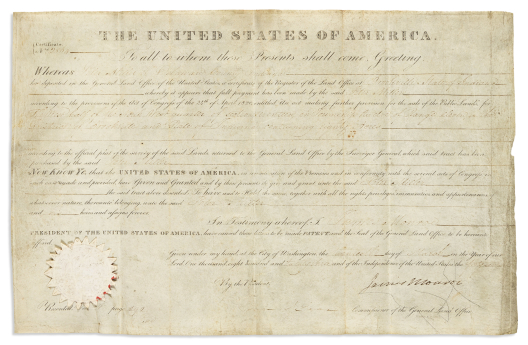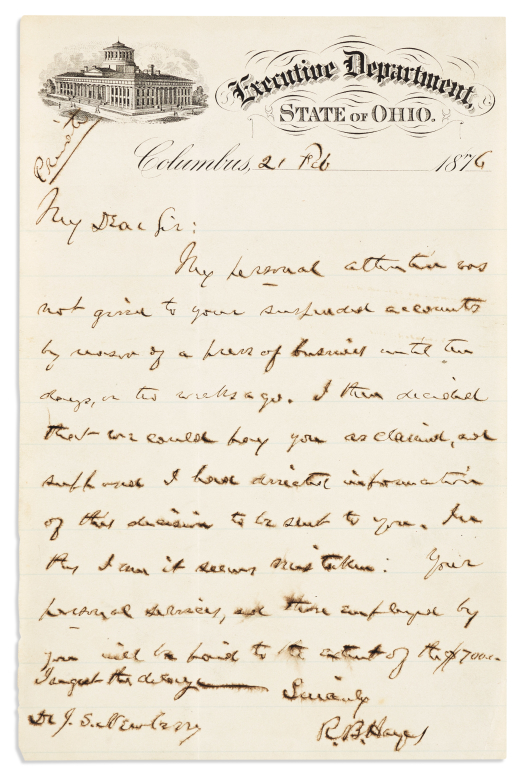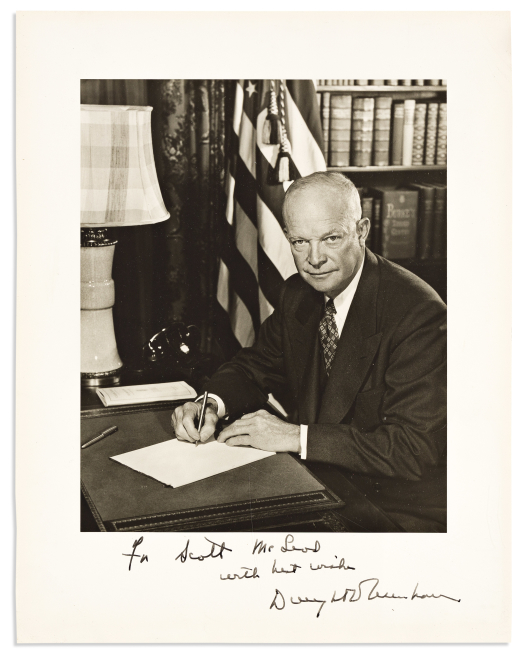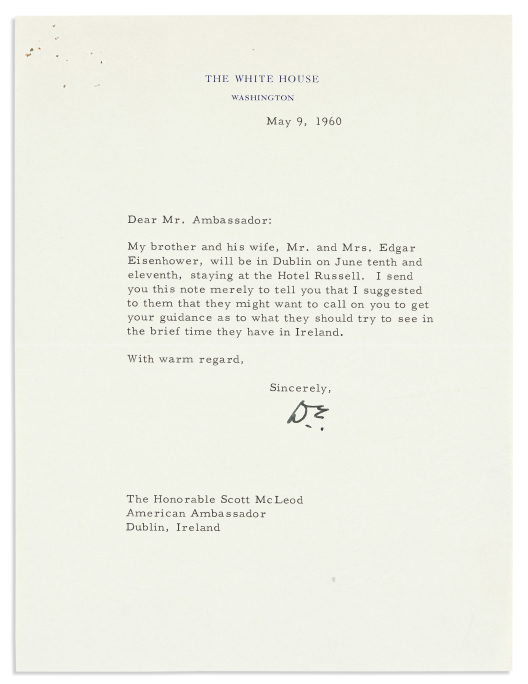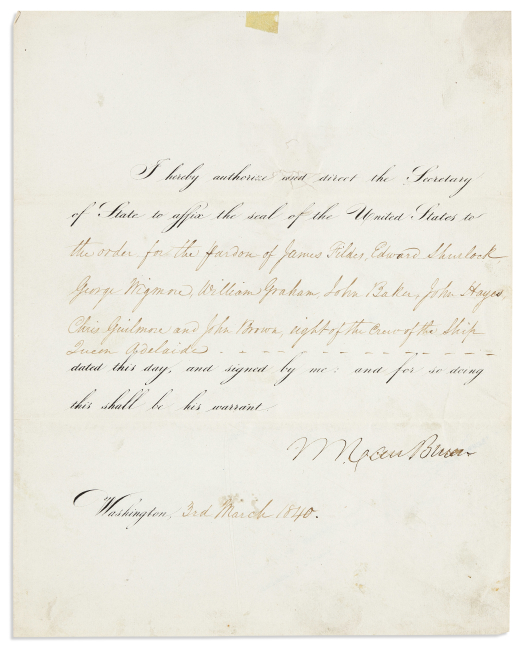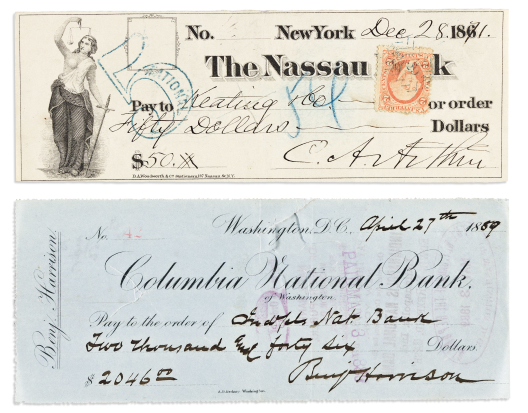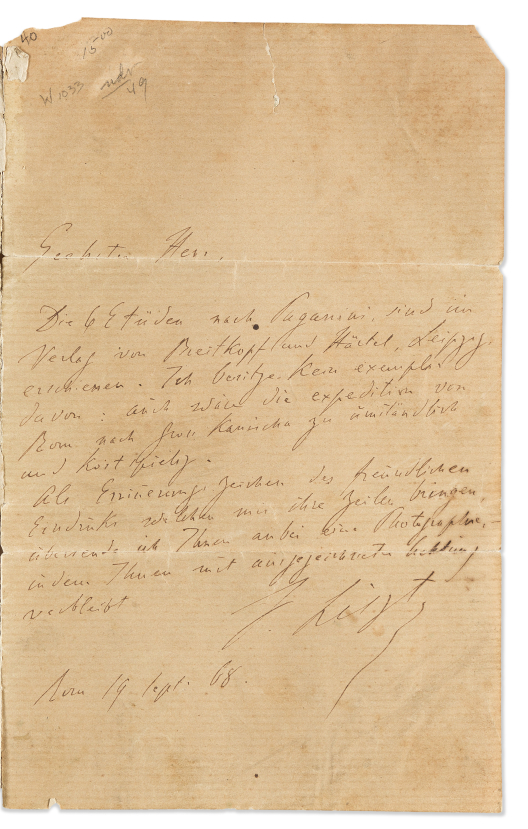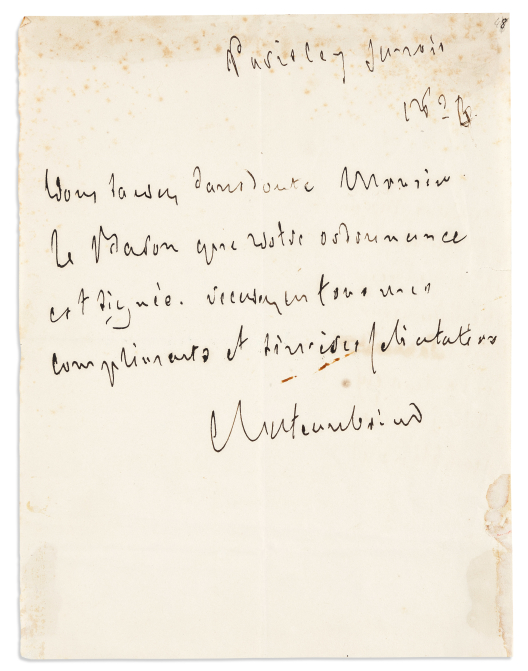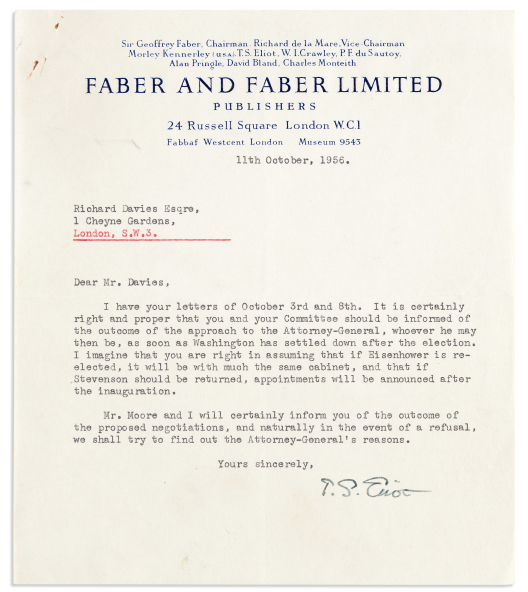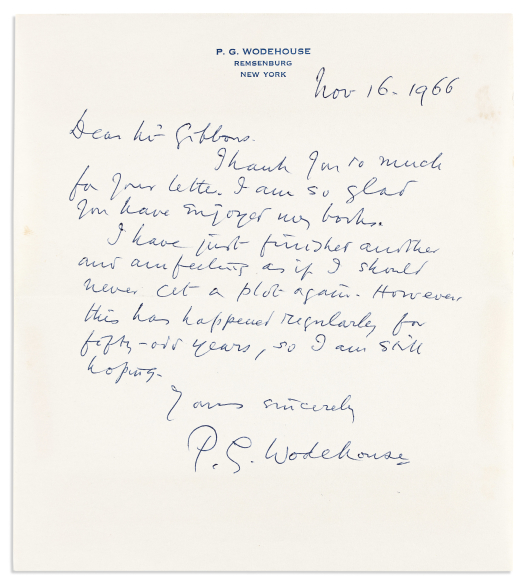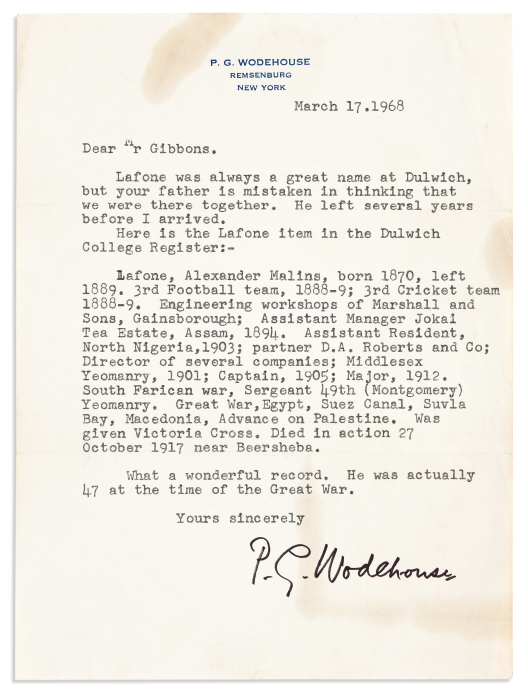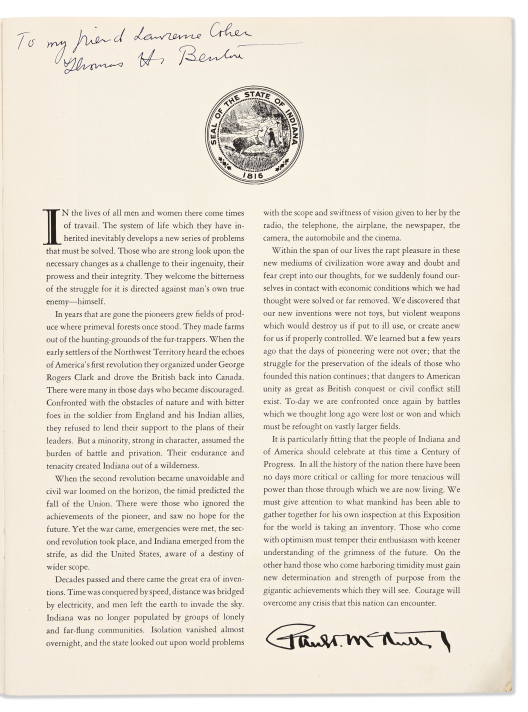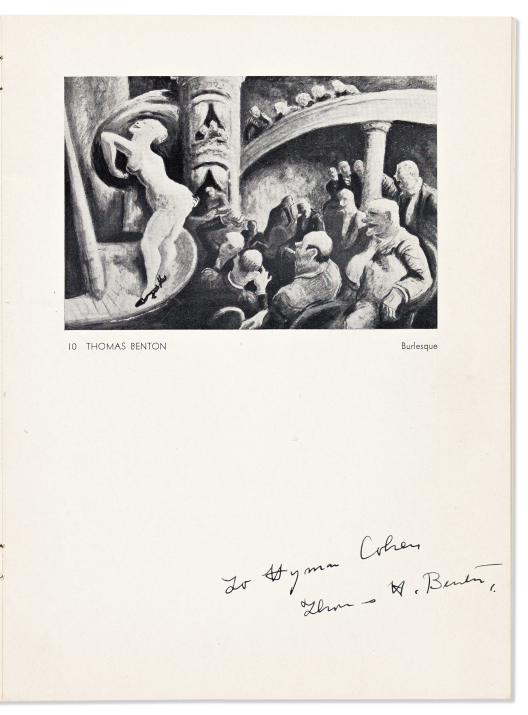
Fine Books & Autographs
Officers

Marco Tomaschett
Specialist, Autographs
mtomaschett@swanngalleries.com
(212) 254-4710 ext.12

John D. Larson
Specialist, Literature & Art Books
jlarson@swanngalleries.com
(212) 254-4710 ext. 61

David Rivera
Administrator
drivera@swanngalleries.com
(212) 254-4710 ext. 13
George S. Lowry
Chairman
Nicholas D. Lowry
President, Principal Auctioneer
924899
Andrew M. Ansorge
Vice President & Controller
Alexandra Mann-Nelson
Chief Marketing Officer
2030704
Todd Weyman
Vice President & Director, Prints & Drawings
1214107
Nigel Freeman
Vice President & Director, African American Art
Rick Stattler
Vice President & Director, Books & Manuscripts
Administration
Andrew M. Ansorge
Vice President & Controller
aansorge@swanngalleries.com
Ariel Kim
Client Accounting
akim@swanngalleries.com
Diana Gibaldi
Operations Manager
diana@swanngalleries.com
Kelsie Jankowski
Communications Manager
kjankowski@swanngalleries.com
Shannon Licitra
Shipping Manager
slicitra@swanngalleries.com
Americana



SIGNER
1
(american revolution.) hart, john.
Colonial banknote Signed, as Member of the First Provincial Congress of New Jersey,

Burlington, 25 March 1776; inscription: Np, circa March 1776
engraved 18 pence note issued by the Colony of New Jersey. Countersigned by Jonathan Johnston and John Stevens, Jr. 2¼x4 inches; minor scattered soiling.



2
(american revolution.) washington, george.
Letter Signed, “G:Washington,” to “Sir” [Commissary General Jeremiah Wadsworth?],

“Middle Brook” [Bridgewater Township, NJ], 12 February 1779
ordering that provisions be stockpiled at Pittsburgh to feed 1,200 troops for four months by the first of May. 1 page, 8x8¼ inches; tear and staining with some loss to lower edge touching signature, faint scattered staining, some loss to left corners, tiny holes at fold intersections, docketing verso.
“You are to proceed without delay to form a Magazine of provisions at Pittsburg for twelve hundred Men for four Months. I could wish to have the Magazine completed by the first May next, or if possible before that time.” In early 1779, George Washington made preparations for a campaign against Fort Detroit from Fort Pitt, requiring attacks against the Seneca villages along the Allegheny River. In April, Washington ordered General Daniel Broadhead to cancel the campaign he led, but, with the approval of Washington, Broadhead continued disrupting the loyalists and allied Indians in the region, destroying crops and dwellings in order to drive them to under-resourced British camps.

"HOWITZERS & SHELLS WILL BE ESSENTIAL . . . FOR CARRYING ON OUR OPERATIONS"
3
(american revolution.) washington, george.
Letter Signed, “G:Washington,” to President of the Council of Massachusetts Bay James Bowdoin,

[Paterson, NJ], 19 July 1780
appealing to him to supply the Continental Army with artillery and powder, telling him to expect estimates for the required equipment from General Knox, reporting that British Admiral [Thomas] Graves has arrived in [occupied] New York Harbor [thus threatening to delay Washington’s plans for attack or siege of New York City], and in the postscript: “Besides the present application for powder, requisitions are going & have been already made to some Other States to spare all they possibly can. I have been duly honored with your Several dispatches of the 26th & 27th Ult[im]o.” Text in the hand of Robert Hanson Harrison. 2 pages, folio, with integral blank; couple small holes at center vertical fold, minor abrasions along left edge of first page, few scattered short closed separations at folds repaired with cello tape, faint toning along fore edge, docketing on terminal page in unknown hand.
“It unfortunately happens on a minute examination of our ordnance & Stores at the different Deposits, that we are by no means in so respectable a condition as to these, as it might be wished. A number of Heavy Cannon & Shot–Howitzers & Shells will be essential in addition to those we have, for carrying on our operations with vigor and energy; and also a further quantity of powder. After considering the matter, Your State appears the most likely & the Only One that can assist us in these instances to any great extent, particularly in the Articles of Cannon & Shot–Howitzers & Shells; and being fully convinced that it will be done with the greatest chearfulness, if it is in their power, I have desired Genl Knox to form an Estimate of these four Articles and to transmit it to Your Honble Board. Powder, that is the quantity, will not be precisely mentioned by him, but it being equally material, I entreat that the Board will favor the Continent, with a loan of the largest quantity they can spare, as well as of the other Articles. They will be pleased to favor me with their Answer with respect to the Several matters requested, by the earliest opportunity.” “I am sorry to inform the Board that Admiral Greaves has arrived with Six Ships of the line off Sandy Hook. This is an unlucky incident & embarrassing at present; but it may eventually turn out otherwise.”



"HAVE NO APPREHENSIONS OF THE EFFECTS OF GENERAL HAMILTON...IN OUR...ELECTION"
4
Burr, aaron.
Autograph Letter Signed, “A. Burr,” as Vice President, to Caesar Augustus Rodney,

New York, 26 April 1801
reassuring him that Alexander Hamilton could not influence the upcoming election without committing fraud, expressing pain at hearing the news of an unspecified appointment, expressing concern that Fabius might be given candidacy [for governor of PA or DE?; "Fabius" was the alias John Dickinson used when authoring open letters], and promising to visit if he passes through Washington. 1 page, 4to, with integral address leaf, addressed in holograph and with franking signature; folds.
”. . . [Y]ou need have no apprehensions of the effects of General Hamilton’s exertions in our approaching election. If no fraud shall be practiced, our assembly ticket in this City will be carried by a Majority still greater than that of the last year. We have on the republican side . . . at least a dozen Men superior to Gen’l H. both in public debate & in active powers & exertions in a business of this kind. The only difference is that they do not puff themselves in the newspapers & thus you at a distance do not hear of them–but mark the effect. . . . “Fabius must not be set up as a Candidate unless there be a certainty of his success. Nor should he consent to the use of his name until there shall appear, in various, if not every, part of the State, a zeal and eagerness for the measure. Though I feel a lively interest in your success, I also feel much for his individual happiness, I may add, and for that of the fair Sarah & Maria. . . .” In 1798, President Adams appointed Hamilton Commanding General of the U.S. Army, passing up men with deep military experience, such as Benjamin Lincoln, George Clinton, Horatio Gates, Henry Knox and Charles Cotesworth Pinckney. If Hamilton’s appointment didn’t enrage Burr, who also had military ambitions, Burr certainly did not appreciate Hamilton’s efforts to discredit him during the presidential election of 1800. According to the election system of the time, the ticket whose candidate received the most electoral votes would become president and the other candidate on the ticket would become vice president. The vote in 1800 resulted in the Republican candidates receiving more votes than the Federalist candidates, but the votes were the same for both candidates on the Federalist ticket, leaving the House of Representatives to break the tie and resolve whether Burr or Thomas Jefferson would become president. Hamilton persuaded some of his fellow Federalists in the House to vote against Burr, denying him the presidency. In 1804, when Burr tried to run for offices as a Federalist, Hamilton launched a campaign similar to the one in 1800 that threatened to ruin Burr’s reputation. Later that year, Hamilton died by the shot of Burr’s pistol.

5
(civil war.) arthur, chester a.
Two partly-printed Documents Signed, “C AArthur.”

New York, 1862; 14 April 1875
The first, as Quartermaster-General, military pass, ordering compensation for transportation of New York State volunteers, unaccomplished except for document number (“1331”) and note that order is payable at Albany, in unknown hand, in red ink. The second, as Collector, a fragment including only the lower half of oath of office for John William Risdale, likely for Deputy Collector. Additionally signed by Risdale. Each 1 page, 4to or 6¼x8 inches; the first with cello tape remnants at upper left recto, the second with horizontal folds.

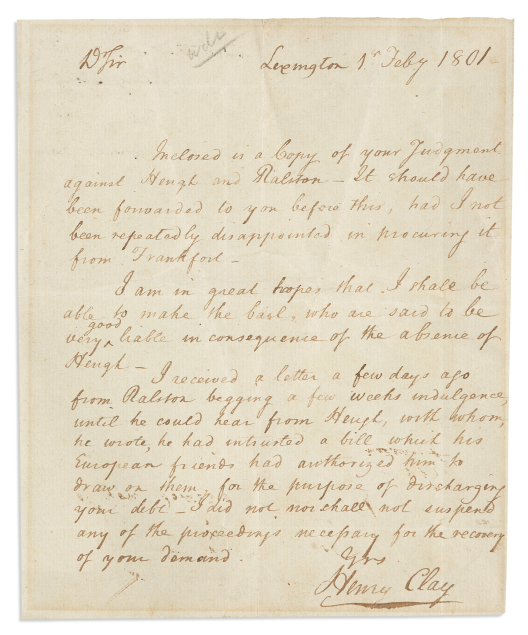

23-YEAR-OLD ATTORNEY
6
Clay, henry.
Autograph Letter Signed, to Baltimore merchant William Taylor (“D’rSir”),

Lexington, 1 February 1801
sending a copy [not present] of his judgment against [Louisville merchants John] Heugh and [Alexander] Ralston, and remarking that nothing would be done to delay collection of his debt despite the letter from Ralston requesting more time. 1 page, 8vo; faint marginal discoloration from prior matting, folds, remnants of prior mounting at upper corners verso.

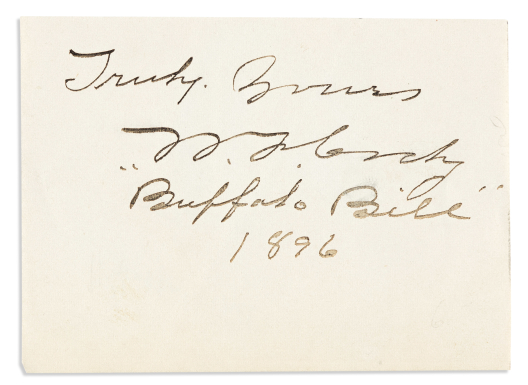

7
Cody, william f. (“buffalo bill”).
Signature and date, “Truly yours / W.F. Cody / ‘Buffalo Bill’ / 1896,” on a slip of paper.

Np, 1896
3x4 inches; minor diagonal crease.

ON GENERAL CUSTER'S SWORD: "DO NOT SHEATH ME WITHOUT HONOR"
8
Custer, elizabeth bacon.
Group of 4 items, each Signed and Inscribed, to Olive Griffin, in ink or pencil: Two Autograph Letters * Autograph Note * Elizabeth B. Custer. Boots and Saddles.

Vp, 1926-27
The letters and note, sending the book, postponing a meeting, planning a visit to the Cosmopolitan Club, giving travel plans, and sending her printed visiting card [present]. Together 5 pages, 8vo or smaller, the note written in pencil on a small envelope; generally good condition. Each with the original envelope. The book, “To my friend / Olive Griffin / Elizabeth B. Custer / 1927 / Motto on General Custer’s / Spanish sword– / ‘Do not draw me without cause / Do not sheath me without honor’,” on the front free endpaper. 8vo, publisher’s cloth, marked rubbing to edges, some fraying at backstrip ends; moderate scattered foxing to preliminaries and subsidiaries including signature page, cello tape repairs to verso of frontispiece. Later edition. New York, 1913; inscription: 1927.



9
Fulton, robert.
Document Signed, receipt for 2,000 livres advanced for rope-making machines, in French.

Paris, [10 January 1799]
1 page, oblong 8vo; folds, docketing verso, 15-centime ink revenue stamp (“Rep. Fra.”) at upper edge.

10
Hamilton, alexander.
Document Signed, “Alexandr Hamilton / for Plaintiffs,” with three additional lines in holograph, judgment of the Supreme Court of New York

[New York], 21 January 1797
in the case of LeRoy & Bayard v. Shaw. The holograph lines, dollar amounts relating to damages to be awarded or value of property under discussion. Additionally signed by Richard Harrison, attorney for the defendant. 2¼ pages, folio, written on a folded sheet; short closed separations repaired with cello tape in several places throughout, signature and holograph lines indicated by red pencil arrows, docketing on terminal page.
In the present case, Hamilton represented New York merchant Jan Cornelis Van den Heuvel and a New York mercantile firm LeRoy & Bayard, whose ship (probably the Narcissus) and cargo were captured by British privateers in July of 1795 during a voyage from Demerara in South America to New York. The plaintiffs brought suit against the insurer’s underwriter to recover the full value of the loss.



11
Hamilton, alexander.
Autograph Manuscript, unsigned, report of a case,

New York, March 1797
including 15 lines in holograph. The report, summarizing the events of a case tried in the Circuit Court for the City and County of New York in which Hamilton was defense counsel for Samuel Falkenham and William Wilmerding against the complaint of James Todd that the defendants failed to honor a promissory note. ½ page, 4to; linen hinge along right edge verso, folds, holograph docketing on verso.



12
Hamilton, alexander.
Clipped Signature, likely removed from a letter,

Np, nd
mounted to a strip of paper. ¾x3 inches; faint bleedthrough from writing on verso.



RESPONDING TO SC GOVERNOR'S DEMAND FOR RETURN OF ESCAPED SLAVES
13
Hancock, john.
Autograph Letter Signed, “JH,” as Governor, to Governor of SC Benjamin Guerard,

Boston, 30 March 1784
sending a report [not present] from the SC general court concerning a group of “negroes.” 1 page, small 4to; faint scattered foxing, horizontal folds.
“The Letter you did me the Honor to address to me I laid before the General Court at their first Session after the Receipt of it. And in compliance with their Request I inclose you the whole of the Transactions respecting the negroes mention’d in your Letter, which upon perusal I flatter myself will be Satisfactory.” In August of 1783, Percival and Anthony Pawley engaged an attorney to recover a group of 10 enslaved people who had escaped to Boston, where slavery had recently been abolished. On October 6, 1783, SC Governor Guerard wrote a letter to MA Governor Hancock demanding restitution for the damages caused by MA’s harboring of the slaves and demanding their return. Chief Justice of the MA Supreme Judicial Court, William Cushing, explained to Hancock that nothing undertaken by the authorities in MA violated the Articles of Confederation nor attacked the sovereignty of SC, which information was likely conveyed in the enclosure that accompanied the present letter to Guerard. Hancock did nothing to locate the “negroes,” and without any guarantees of protection from MA, no one from SC pursued them.



14
Key, francis scott.
Autograph Document Signed, “FSKey USAtt’y / DC,” as Attorney for the District of Columbia,

[Washington], 14 June 1839
giving notification of a motion for a new trial because of the discovery of new testimony in the case of United States v. William S. Smith. Additionally signed in third person within the text (“Francis S Key Esquire / District Attorney of the United States / for the District of Columbia”). 1 page, folio; complete separation at horizontal fold, small hole from inkburn (without loss to text), few small cello tape reinforcements to folds verso, docketing verso.

ARCHITECT OF WASHINGTON, DC
15
L’enfant, pierre charles.
Autograph Document Signed, “P. Charles L’Enfant,” ordering the Treasurer of the “Manufacture Society” [Society for Establishing Useful Manufactures]

Philadelphia, 21 March 1794
to pay B. Walker $918.80. 1 page, 4x8 inches; signature is completely crossed out with cancellation marks, folds.
With–Pierre Charles L’Enfant. Autograph address leaf, unsigned, to Director of the Society for Establishing Useful Manufactures Nicholas Low. 1 page, oblong 4to; some chipping at lower edge and minor loss from seal tear, folds. [Philadelphia, 5 February 1793].



UNCOMMON STOCK CERTIFICATE
16
Morris, robert.
Partly-printed Document Signed, “Rob’tMorris,” as President of the Asylum Company, issuing a share in Asylum to John Nicholson.

Philadelphia, 9 October 1794
Countersigned by Asylum Secretary James Duncan. 4 pages, folio, printed on a folded sheet; faint scattered foxing, horizontal fold.
In April of 1794, Morris, together with John Nicholson and others, formed the Asylum Company as a land speculation venture with the expectation of purchasing one million acres in various parts of PA. Morris and his partners identified a ready market in French nationals fleeing the French and Haitian revolutions, many of whom acquired land from the company to settle in Bradford County on the Susquehanna River. Like the other land speculation enterprises in which Morris was involved, such as the North American Land Company, Asylum struggled to realize its ambitions and was dissolved after Morris’s death.



SIGNER STRUGGLES TO MAINTAIN FINANCES WHILE SPECULATING IN LAND
17
Morris, robert.
Autograph Letter Signed, “Rob’t Morris,” to Thomas Fitzsimmons,

Philadelphia, 4 December 1794
declaring full responsibility for payment of Morris’s bills of exchange endorsed by Fitzsimmons, and expecting the payments to be covered by his own share of the proceeds from the sale of land held in common with him by London firm Arthur Cramond & Co. 1 page, 4to, with integral address leaf; horizontal folds.
“In consequence of the Power which You and I have transmitted to Mr. Arthur Cramond for the Sale of our Georgia Lands, I have made a Sale of Bills drawn by me upon . . . Arthur Cramond in fav’r of JnoNicholson or order payable in one year, Eighteen months, Two Years & Three Years to the Amount of Fourteen Thousand pounds Sterl’g in the whole, all which bills You have been kind enough to endorse. “I do therefore hereby bond myself to exonerate you from any share of the payment of said bills, as the same are to be paid out of Two thirds the proceeds of the said Lands or from other of my own Funds.”



REQUESTING A 24-HOUR LOAN
18
Morris, robert.
Brief Autograph Letter Signed, “RMorris,” to Philadelphia merchant George Harrison:

Np, 3 July 1795
“If you dare to lend me one Thousand Dollars (wanted this Moment) I pledge myself to return them–tomorrow.” 1 page, oblong 8vo, with integral address leaf formed by folding along upper edge; minor scattered smudging to text (not affecting signature), folds.

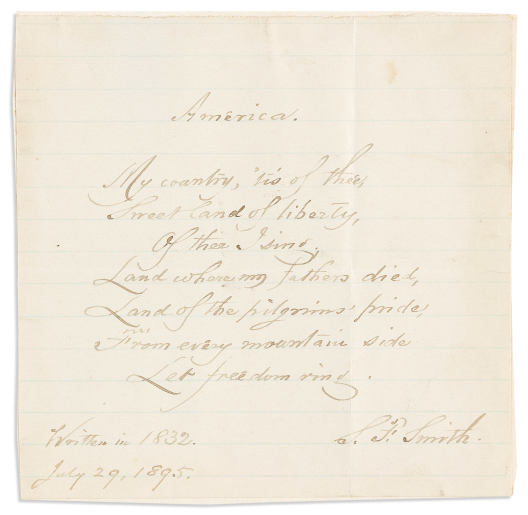

"MY COUNTRY 'TIS OF THEE"
19
Smith, samuel francis.
Autograph Quotation Signed, “S.F. Smith,” fair copy of the first stanza of his hymn, “America.”

Np, 29 July 1895
1 page, 5x5 inches, ruled paper; backed, folds.



TWO STANZAS OF "AMERICA"
20
Smith, samuel francis.
Autograph Quotation Signed, “S.F. Smith,” fair copy of the first two stanzas of his hymn, “America.”

Np, nd
1 page, 12mo, gilt-edged card; faint toning at right edge.



21
Steuben, friedrich wilhelm von.
Check accomplished and Signed, “Steuben,” drawn on an unnamed bank

New York, 6 August 1791
in the amount of $70.00 to John De Groashe[?]. 3x6 inches; ink cancellation marks through signature and text, vertical folds.

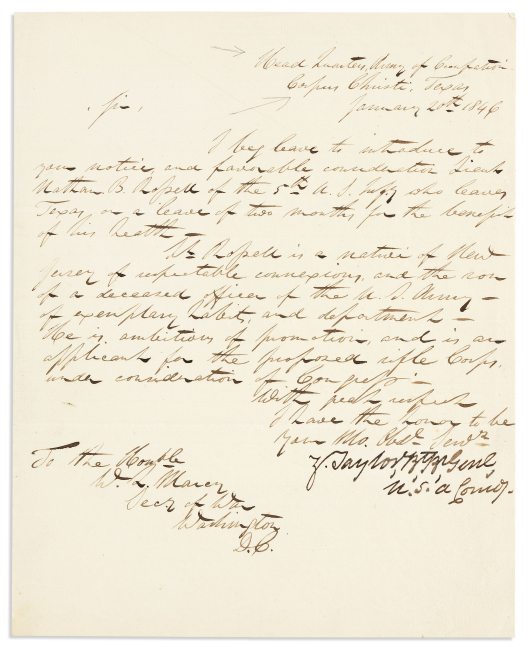

WRITTEN IN WEEKS BEFORE DECLARATION OF MEXICAN-AMERICAN WAR
22
Taylor, zachary.
Letter Signed, “Z. Taylor, B[reve]tB[rigadie]rGen[era]l / U.S.A Com[man]d[in]g,” to Secretary of War William L. Macy,

Corpus Christi, 20 January 1846
recommending that he consider the application of Lieutenant Nathan B. Ropell to the rifle corps. 1 page, 4to, with integral blank; horizontal folds.
”. . . Mr. Ropell is a native of New Jersey of respectable connexions, and the son of a deceased officer of the U.S. Army–of exemplary habits, and deportment. He is ambitious of promotion, and is an applicant for the proposed rifle Corps under consideration of Congress.”

23
(americana.)
Group of 4 items Signed, or Signed and Inscribed: James Monroe * Rutherford B. Hayes * Timothy Pickering * Daniel Webster.

Vp, 1794-1876
Format and condition vary.
Monroe. Partly-printed vellum DS, granting 80 acres near Brookville, IN, to Peter Miller. 10x16 inches; some fading to text (but legible and signature relatively bold). Washington, 20 March 1823 • Hayes. ALS, “R.B. Hayes,” as Governor, to Dr. J.S. Newberry, concerning payment for his services. 1 page, 8vo, “Executive Department” stationery; some scattered smudging to text. Columbus, 21 February 1876 • Timothy Pickering. ALS, as Postmaster General, to Colonel John Neilson, describing objections to the appointment of newspaper printers to positions in the post office. 2 pages, 4to, with integral address leaf. [Philadelphia], 24 January 1794 • Daniel Webster. Brief ALS, “Dan’l Webster,” to R. Gilmor, offering his services to Meredith. 1 page, 4to, moderate staining from cello tape repair to nearly complete separation at horizontal fold. Washington, 8 January no year.
General, including Royalty, Astronauts, World Leaders, Sports Figures, etc.

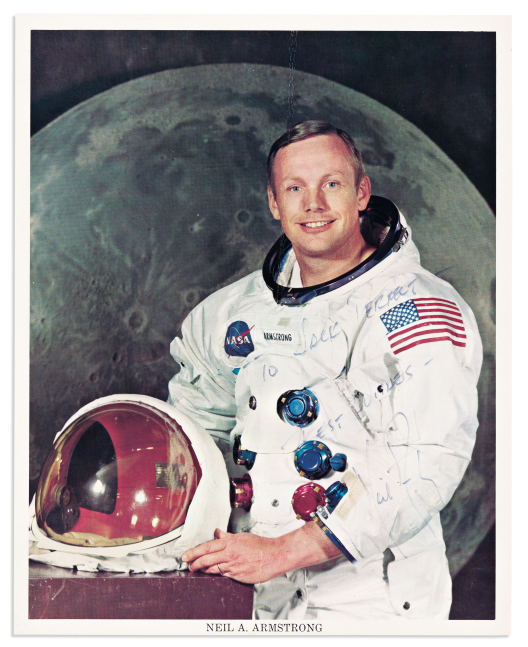

24
(astronauts.) armstrong, neil.
Color Photograph Signed and Inscribed, “To Jack Perfect– / Best Wishes–,”

Np, [1980s]
½-length portrait by NASA, showing him in space suit holding helmet with moon in background. Signed in the image, lower right. 10x8 inches; vertical crease with minor loss affecting portrait, remnants of prior mounting along edges verso, biography printed on verso.

INCLUDES ED WHITE, WHO DIED IN APOLLO I FIRE
25
(astronauts–gemini–apollo.)
Group of three color Photographs Signed, or Signed and Inscribed.

Np, 3 June 1965; nd
The first, Edward Higgins White II. “To Linda, / with best wishes / for a bright / future. / Edward H. White II / Gemini 4, 3 June ‘65,” half-length portrait showing him in his space suit holding a model of the Gemini-Titan II rocket. Inscribed in the image, lower right. 10x8 inches; uncommonly good condition. The second, Gene Cernan, John Young, and Tom Stafford. Additionally inscribed by Stafford, “To Dave Miller / With our Best Regards–The Apollo X Crew.” Full-length portrait, showing the crew in their space suits with a Saturn V rocket on the launchpad in the background. Inscribed on the mount above and below the image. 9½x7 inches; moderate fading to photograph (but inscriptions relatively bold), faint dampstaining at lower edge (not affecting signature). The third, John Glenn. Full-length group portrait by NASA, showing the Mercury Seven standing in front of an F-106 aircraft. Signed diagonally in the image, upper center. 8x10 inches; biographical information printed on verso.
With–Sticker showing the “Meatball” NASA logo, designed in 1959 by James Modarelli.

26
(business.)
Three items, each Signed, or Signed and Inscribed: Samuel F.B. Morse * Samuel Slater * Hudson Maxim.

Vp, vd
Format and condition vary.
Morse. Clipped Signature: “Sam’l F.B. Morse. New York.” ½x4½ inches • Slater. Clipped portion of an ALS, including only closing and 3-line postscript additionally signed with initials: “NB. Who bo[ugh]t the house in Dudley yesterday & what price did he agree to give. S.S.” 2¼x7 inches; mounted to larger sheet, folds • Maxim. TLS, to Russell Radford, sending a list of details from his own personal biography, including names of his ancestors, education history, and favorite sports (“Tennis, automobiling, chess”). 2 pages, 4to, written on two sheets; moderately dampstained overall, chipping at edges. Landing, NJ, 18 September 1915. With–(Hudson Maxim.) Two postcards and 4 envelopes addressed to Maxim from various senders. The postcards, promising to send an estimate concerning an [insurance?] claim, or acknowledging receipt of a check. 3½x5½ inches or smaller. Vp, 1896-1919.

27
Carver, george washington.
Two Autograph Letters Signed, “G.W. Carver,” to Grady Porter or Anderson S. Spann.

Tuskegee, 1 November 1932; 19 September 1934
The first, describing a visit from his friend’s sister. The second, describing changes to the Institute campus over the years since the time it was familiar to him. Together 2½ pages, 4to, “Tuskegee Normal and Industrial Institute” stationery, one written on recto and verso of a single sheet; folds. Each with the original envelope.
19 September 1934: “. . . Capt. Austin has been dead for several years. Mr. Bridgeforth is somewhere in Tenn. I believe he has not been with us for many years. . . . Were you to come upon the grounds at night, I doubt if you would know the place, as it has changed in so many ways. . . . You certainly would not recognize the old drill ground as three of the most beautiful buildings on the grounds are on it, viz library, gymnasium and science hall.”



28
Douglass, frederick.
Partly-printed endorsement Signed, “Fred’k Douglass,” as Recorder of Deeds, certifying a deed

[Washington], 24 March 1885
transferring a plot of land in Washington, DC, from Joseph C.G. Kennedy to Thomas D. Bond. Endorsement and docketing on terminal page. 1½ pages, folio; nearly complete separations at folds, faint scattered soiling.



TO SUCCESSFUL PHILADELPHIA DEALER IN EDISON PHONOGRAPHS
29
Edison, thomas a.
Typed Letter Signed, “Thos A Edison,” to General Manager of Girard Phonograph Peter R. Hawley,

Orange, 27 June 1923
declining to attend a testimonial dinner held by dealers of Edison phonographs but sending regards and wishes of continued success. 1 page, 4to, “From the Laboratory of Thomas A. Edison” stationery; mounted to board trimmed to size, moderately toned overall.
”. . . [B]usiness matters will not permit me to give myself the pleasure of participating in the festivities of the testimonial dinner to be given to you by . . . the Edison Dealers . . . . “But I do want to . . . express my kind regards, and also my felicitations upon the success . . . in having won for yourself the respect and esteem of your Dealers . . . .”



WRITTEN IN WEEKS PRIOR TO ANNOUNCEMENT OF EIFFEL TOWER'S COMPLETION
30
Eiffel, gustave.
Letter Signed, “G. Eiffel,” to press agent Henri Houssaye, in French,

Paris, 12 March 1889
apologizing for the delayed reply and accepting his invitation to allow the Haras Agency to publish communications for Eiffel. 2 pages, 8vo, personal stationery, written on the first and terminal pages of a folded sheet; collector’s ink stamp below signature (“Autograph Collection of Dr. Max Thorek Chicago”), cataloguing number written in unknown hand at upper left corner of first page.



SIGNED ON THE DAY HIS FRIEND, THE CHEMIST BERTHOLLET, DIED
31
Laplace, pierre simon.
Autograph Letter Signed, “M[arqu]is de Laplace,” to Antoine-François-Claude Ferrand, in French,

Np, 6 November 1822
respectfully declining an invitation because of commitments to care for his dying friend [Claude Louis] Berthollet. ½ page, 4to, with integral address leaf, addressed in holograph; minor loss at right edge from seal tear, faint staining at upper right, folds.

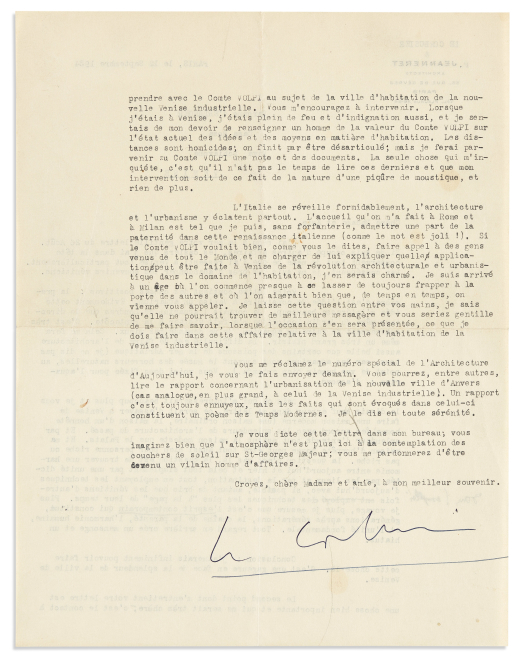

"ITALY IS WAKING UP TREMENDOUSLY, ARCHITECTURE . . . BURSTING OUT EVERYWHERE"
32
Le corbusier.
Typed Letter Signed, to Baroness Catherine d’Erlanger (“Dear Madam and Friend”), in French,

Paris, 12 September 1934
agreeing to design an aquarium for Venice, expressing interest in designing a residence in Venice that would take into account the history and present of that city’s architecture, offering to advise Count [Giuseppe] Volpi concerning [industrial?] housing, expressing excitement about Italy’s recent renaissance in city planning and architecture, and promising to send a copy of Architecture d’Aujourd’hui. 2 pages, 4to, written on the recto and verso of single sheet; folds.
”. . . Your letter contains positive things: the first is the idea of building an aquarium in Venice. Obviously this idea interests me a lot. I know the London aquarium, which the director of the Zoological Garden showed me during Pentecost. It’s very interesting to make an aquarium, I couldn’t ask for more. It will even give me great pleasure. The difficulty is to make architecture as beautiful as some of the fish in the Adriatic Sea . . . . “But what would interest me much more . . . would be to try to make a modern house in Venice (an ordinary house, the house of an honest man) in keeping with the splendours of the architecture of the past. And by splendor I mean just as much the modest house as the Palace. . . . The question is . . . to find a harmony between today and yesterday . . . employing the techniques of today with, if possible, as much brilliance as the Venetians of yesteryear . . . . The more I travel, the more I find that it is the contemporary spirit which constitutes, generation after generation, the chain of kinship, human harmony, and a fundamental unity. Any look back creates a lie and a hiatus. “The . . . point about . . . the contact to be made with Count VOLPI about . . . the new industrial Venice. You encourage me to intervene. When I was in Venice, I was also full of fire and indignation, and I felt it my duty to inform a man of Count VOLPI’s worth about the present state of ideas . . . in matters of housing. . . . I will send Count VOLPI a note . . . . The only thing that worries me is that he does not have time to read these and that my intervention is therefore of the nature of a mosquito bite, and nothing more. “Italy is waking up tremendously, architecture and town planning are bursting out everywhere. The welcome I received in Rome and Milan is such that I can, without boasting, admit a part of paternity in this Italian renaissance (how pretty the word is!). If Count VOLPI wanted, as you say, to appeal to people from all over the world and ask me to explain to him what application can be made in Venice of the architectural and urban revolution in the field of housing, I would be charmed. I’ve reached an age where you almost start to get tired of always knocking on other people’s doors and where you would like someone to call you from time to time. . . .”



SIGNED BEFORE PUBLICATION DATE
33
Lindbergh, charles a.
Spirit of St. Louis. Signed and Inscribed,

New York, 1953; inscription: August 1953
"To George T. Eggleston / With best wishes . . . / August, 1953 / Publication date is Sept. 14th," on title-page. 8vo, publisher's blue cloth, some fading to spine; faint scattered foxing to preliminaries; dust jacket worn with chipping and short tears at all edges. first edition.

34
Mayo, william james.
Two Autograph Letters Signed, “W.J. Mayo,” to physician John Benjamin Murphy (“Dear Doctor Murphy”),

Rochester, MN, 2 November 1896; 16 July 1916
sending the details for three recent surgical cases, and congratulating him for having been awarded a knighthood in the Order of St. Gregory the Great. Together 3 pages, the second written on the first and third pages of a folded sheet, “Dr. William J. Mayo” stationery; complete separations at horizontal folds of first forming three loose pieces, copy of Murphy’s typed letter reproduced vertically on blank page of second.
2 November 1896: “Unfortunately I did not keep a copy of the cases I sent you before but these are the last three . . . cases–please compare dates & names; not to duplicate. “N. Hinterschite–46—Loyd Minn. Malignant obstruction of common duct. Operation at his home–could not be moved. Profound jaundice– Cholecystenterostomy, death 4th day–no autopsy. “D. Davis, Lake Crystal Minn. Age 66–July 2–96. Operated on at St. Marys Gastroenterostomy for malignant disease of pylorus–Recovery discharged July 18 96. “Mrs. J. English–55. Chester Minn. Operated upon at St. Marys July 8–96. Gastroenterostomy for extensive cicatricial obstruction pylorus. Recovery–discharged July 80–96.” On June 16, 1916, John Benjamin Murphy was awarded the Pontifical Equestrian Order of St. Gregory the Great, a papal order of knighthood.



WRITTEN IN THE MONTH FOLLOWING THE FRANCO-RUSSIAN TREATY OF TILSIT
35
Napoléon.
Letter Signed, to his adopted son Eugène de Beauharnais (“Prince Eugene Napoléon”), in French,

Fontainebleau, 2 October 1807
acknowledging his letter regarding the Russian squadron and expressing disapproval of his having invited the Russian commanders to see him. ½ page, 4to; folds.
“I received your letter relating to the Russian squadron. I informed you in a letter the day before yesterday that there are measures to be taken, and that you should not warn too many people. I had told you to treat the general officers who came to Milan well; but I didn’t tell you to send invitations to squadron commanders to come and see you.”



WRITTEN DURING CRIMEAN WAR
36
Nightingale, florence.
Autograph Letter Signed, “FNightingale,” to “My dear Sir,”

Np, 5 June 1856
requesting that the women and children in her care be given appropriate cabins on the ships that are to take them home. 1 page, 4to; short closed tear at left edge, slight brittling overall, faint uneven toning overall, remnants of hinging at upper edge, folds.
“I promised Col. Drummond & Serj’t Brownlow to take care of Mrs. Brownlow & child, Mrs. Beaucroft (& Col. Walker to take care of a Mrs. Bruce, S.F. Gds) till I could send them home with proper women’s accommodation. Otherwise, they would have gone with their husbands–per Agamemnon. “Mrs. Brownlow is in very delicate health. “Pray do not let them go per ‘Bahiana’ unless they can have a proper women’s cabin. I depend upon you. There will be three to go, if possible, otherwise two.”



37
Nightingale, florence.
Signature, in full, on envelope with holograph address,

Np, 17 February 1886
to Mrs. Wilton Phipps. 4¼x5½ inches; closed tear at upper left.



INCLUDES LETTER SIGNED BY EDWARD TELLER MENTIONING OPPENHEIMER & MCCARTHYISM
38
(nuclear weapons.)
Archive of over 30 letters Signed, by U.S. Senators, Representatives, and others, to chemist Charles D. Coryell,

Vp, 1954-59
most thanking for his expression of opposition to President Eisenhower’s proposed agreements controlling the transfer of nuclear weapons to NATO countries around the world [relating to amendments to the Atomic Energy Act in August, 1954 and 1958], many suggesting that the agreements would not increase risk to global security, comparatively few expressing some sympathy in exercising caution. Some letters bear secretarial signature, including a letter and memorandum from John F. Kennedy. Together 43 pages, 4to or 8vo, most on Congressional stationery; Teller letter worn with moderate scattered staining, folds.
Edward Teller. TLS, “Edward”: “. . . I firmly believe that McCarthy is gone. I think that he has done us a great service by first establishing McCarthyism and then getting himself discredited. . . . “About the Oppenheimer case I am terribly disturbed and I continue to be disturbed. I hope that somehow in the course of time we shall get to the point where we can forget about it. Reopening the case may bring out even more unpleasant facts and may stir up even more unhappiness. In any case, I am extremely glad that Oppenheimer was retained as Director of the Institute. “One positive thing that may come from all of this may be a more reasonable and liberal approach toward security problems. . . .” 1 page, 4to, “University of California” stationery. Livermore, 12 November 1954. Letters dated July-August 1959: Joseph W. Barr • Overton Brooks • Steven V. Carter • J. Edgar Chenoweth • Marguerite Stitt Church • Frank M. Coffin • Laurence Curtis • Everett McKinley Dirksen • Thomas J. Dodd • Albert Gore • Randall S. Harmon • A. Sydney Herlong, Jr. • Hubert H. Humphrey (2) • John F. Kennedy • Hastings Keith • R.E. Lapp • Roland V. Libonati • Warren G. Magnuson • Eugene J. McCarthy • Erwin Mitchell • Wayne Morse • Edmund S. Muskie (2) • Thomas P. O’Neill, Jr. • Philip J. Philbin • William Proxmire • Henry S. Reuss • Maurice S. Rice • L. Mendel Rivers • James Roosevelt • Leverett Saltonstall • Samuel S. Stratton • Herman E. Talmadge • Leonard G. Wolf • Ralph Yarborough • Clement J. Zablocki. With–Three items: (Richard M. Nixon.) Typed letter from Vice President Nixon’s Executive Assistant, Colgate S. Prentice, to Coryell, remarking that Nixon is in Moscow and cannot respond to his letter. 1 page, 8vo, “Office of the Vice President.” Washington, 29 July 1959 • (Strom Thurmond.) Postcard from him to Coryell, acknowledging receipt, bearing printed signature. 1 page, 12mo. [Washington, 21 July 1959] • (Charles D. Coryell.) Retained copy of his typed letter to Representative J. Edgar Chenoweth concerning his work for the Committee on Science and Astronautics, and requesting revisions to the President’s agreements on nuclear arms. 2 pages, 4to. Np, 30 July 1959.

39
Pius ix; pope.
Two items: Autograph Letter Signed, “Pius P[ontifex]M[aximus] IX,” and an Autograph Note, unsigned, each to his eldest brother Gabriel Mastai, in Italian.

Np, 14 April 1857; 27 August [1859]
The first, discussing the proposed wedding of Mastai’s son, remarking that marriages are only rarely blessed by God, noting the birthdate of an unnamed woman, stating that he has bequeathed the lands on the bank of the Cesano, giving their value, adding that the Empress of Russia is expected in Rome, and closing with an Easter Blessing. The second, written on the integral blank of Mastai’s letter to him, assuring him that he is convalescing and will be returning in a few days, and remarking cynically on the current state of the world. Mastai’s letter, inquiring about the Pope’s health and suggesting remedies for swollen legs. Together 3 pages, 4to or 8vo, first with integral address leaf and second on folded sheet; first with small hole from seal (without loss to text).
14 April 1857: “. . . You speak to me of marriage for the . . . son Luigi; . . . I have always refrained from intervening with my suggestions . . . . I have heard it said that Luigi was . . . to deal with them more for speculation than for another end. Marriages are made such, I believe, and on rare occasions are they blessed by God. . . . I don’t know what else to tell you except that in the Roman Almanac it is recorded that the lady was born September 15, 1825. . . . [T]he deceased father of this lady lived and died as a great Gentleman . . . and better Christian. . . .” 27 August [1859]: “Infirmitas haec non est ad mortem. [This illness is not unto death.] . . . The things of the world have become a fat comedy, and so the charlatans are making their fortunes.” With–Group of 4 letters to members of the Mastai family from various senders, in French or Italian: “Szymanowski” to Luigi Mastai, mentioning Garibaldi; Zygmunt Krasinski to Louis Mastai; [Unknown] to Gabriel Mastai; “De Vico” to Count [Mastai], responding to news of death of Gabrielle Mastai Ferretti. Together 9 pages, 4to or 8vo. Naples, 14 August 1849; Baden, 24 April 1857; [Rome], 1 February 1859; Paris, 7 May 1869.



40
Robinson, jackie.
Check accomplished and Signed, “Jack R. Robinson,” to his daughter, Sharon Robinson,

Stamford, CT, 9 August 1967
in the amount of $50, drawn on the Royal National Bank of New York. 2¾x6¼ inches; cancellation ink stamp at left (not affecting signature), endorsement signatures including Sharon’s on verso.

SIGNED BY LEADERS OF ROTHSCHILD BANKS IN FRANKFURT, PARIS, LONDON, AND VIENNA
41
(rothschild family.)
Group of 3 letters and a document, each Signed by a member of the family: Amschel Mayer Rothschild * James de Rothschild * Lionel Nathan Rothschild * Anselm Salomon von Rothschild.

Vp, vd
Together 7 pages, 4to or folio; generally good condition.
Amschel Mayer. “MARothschild&Söhne,” LS, to Baron Limburger von Ehrenfels, in German, concerning the drawing of a note. Frankfurt, 11 March 1816 • James. LS, to British Ambassador to France Charles Stuart, in French, concerning a customs permit for the importing of books from Germany. Paris, 7 March 1821 • Lionel Nathan. LS, “N MRothschild&S[ons],” to Mr. Dowson, concerning the interest from a Belgian bond. “New Court” [London], 2 December 1840 • Anselm Salomon. DS, “ASvonRothschild,” receipt for 11 gulden 30 kreuzer to Austrian Ambassador at Paris for a subscription to Revue Commerciale. Vienna, 2 December 1836. With–(Amschel Mayer Rothschild.) Letter bearing signature by secretary, to the Chevalier von Limburger, in German. 1 page, 8vo, with integral address leaf. Frankfurt, 21 July 1815. Amschel Mayer Rothschild (1773-1855) was a son of Mayer Amschel Rothschild and head of the Frankfurt firm; James de Rothschild (1792-1868) was also son of Mayer Amschel and head of the Paris firm; Lionel Nathan Rothschild (1808-1879) was son of Nathan Meyer Rothschild who was employed at the firm in London; Anselm Salomon von Rothschild (1803-1874) was son of the founder of the firm in Vienna, Salomon Mayer Rothschild.



42
(royalty.) diana and charles; princess and prince of wales.
Color Photograph Signed, by both (“Diana” and “Charles”),

Np, 1983
bust portrait by Tim Graham showing them looking into the camera with Charles’s hand upon Diana’s shoulder. Signed on the mount below the image, additionally dated by Charles. 5¼x4 inches (image), 7½x6 inches overall; faint soiling along lower edge (not affecting signatures); original leather frame with the Prince of Wales’s feathers stamped in gilt at upper center, minor wear.



QUEEN ORDERS THAT GARMENTS BE MADE FOR HER
43
(royalty.) isabella i; queen of spain.
Document Signed, “Yo la Reyna,” to her chamberlain Sancho de Paredes Golfín, in Spanish,

Grenada, 18 March 1501
ordering him to instruct a dressmaker to make four chemises of Dutch linen appropriate to be worn with gold and scarlet overskirts, and requesting that garments be covered with lace or embroidery and finely pleated. Countersigned by secretary Miguel Pérez de Almazán. ½ page, folio; recent ink identification at upper left corner, slices (touching text only) repaired verso, faint bleedthrough from docketing verso, folds; ¼ morocco slipcase with gilt titling on spine, cloth chemise.



LEGITIMIZING PRIEST'S CHILDREN BORN OF A MARRIED WOMAN
44
(royalty.) philip iv; king of spain.
Document Signed, “Yo ElRey,” as King, granting legitimacy to the children sired by the priest Fernando de la Parra,

Np, 5 May 1635
Canon of the Church of Cuenca, in Spanish. 1 page, 12x11½ inches; moderate scattered dampstaining touching signature, loss at points along left edge expertly repaired with paper, folds, docketing and endorsements and mostly-intact paper seal on verso.
”. . . Fernando de la Parra priest . . . before taking holy orders had . . . sired . . . children from a married woman and . . . . begged us to . . . entitle them to be able to . . . inherit all . . . of the landed properties and livestock . . . and to be able to enjoy the dignities, mercies, generosity, freedom, immunity, or other things enjoyed by those who are born and procreated of legitimate marriage . . . and we have thought it proper to do it, because in the same way that our very Holy Father has the power to legitimate and entitle in spiritual matters we kings have the power to legitimate and entitle in temporal matters . . . .”

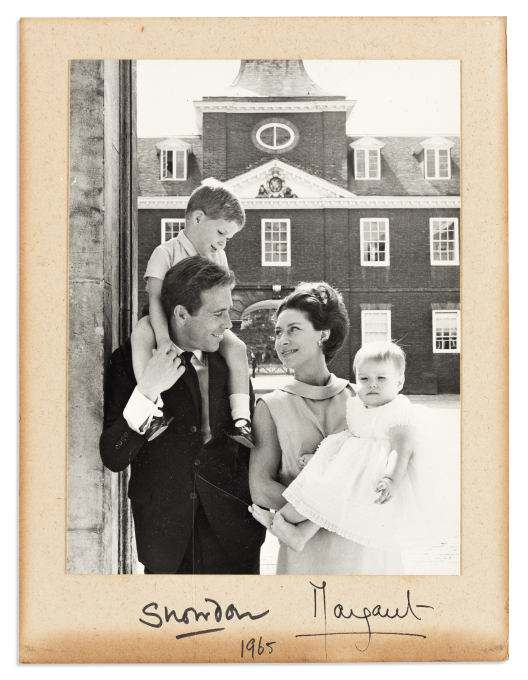

45
(royalty.) princess margaret; and antony armstrong-jones.
Photograph Signed, by both (“Margaret” and “Snowdon”),

Np, 1965
half-length portrait by Cecil Beaton showing them carrying their children, Sarah and David. Signed on the mount below the image, dated in unknown hand. 6½x5 inches (image), 8¼x6¼ inches overall; moderate toning at edges touching paraph of each signature, Beaton’s ink stamp on verso; original gilt leather frame by Frank Smythson, moderately worn.

46
(royalty–british.)
Group of 7 items Signed, or Signed and Inscribed, by a monarch or other nobility.

Vp, vd
Format and condition vary.
Victoria; Queen of the UK. Envelope Signed, “The Queen,” addressed in holograph to her personal secretary, “Sir Henry Ponsonby / G.C.B.,” with the word “Immediate” written at upper right. 3¾x4¾ inches, mourning border, gilt monogram of Queen as Empress of India on flap. Np, circa 1890 • Albert; Prince Consort of Queen Victoria (2). ALsS, “Albert,” to Alphonse, Count Mensdorff-Pouilly or Prime Minister Palmerston. The first, in German, complaining of “Lord P[almerston?]” who favors the re-establishment of arch-dukes and complaining of the narcissism of [Prince?] Ferdinand. 5 pages, 8vo, pale blue paper, written on two sheets; the second, sending a letter [not present] from the King of Sweden for him and Foreign Secretary Clarendon. 1 page, 8vo, with integral blank. First with the original envelope. [East Cowes], 28 August 1859; [Windsor], 21 March 1856 • Edward VII; King of the UK. ALS, “AlbertEdward,” to “My dear St. A. [Duke of St. Albans?],” inviting him for a visit. 1½ pages, 8vo, written on recto and verso of single sheet, Prince of Wales’s feathers stationery. [London], “Wednesday” • George V; King of the UK (2). The first, ALS, “GeorgeR.I.,” to Lady Wolverton, agreeing to meet for “the racing” and inviting himself to dinner. 2 pages, 8vo, written on recto and verso of single sheet; the second, ANS, “G[eorgius] R[ex] I[mperator],” to an unnamed recipient, in pencil: “I should like to see / Several at 3. o’clock.” 1 page, oblong 12mo, “Buckingham Palace” correspondence card. First with the original envelope. [London], 25 April 1921; nd • Mary of Teck; Queen Consort of George V. ALS, “Mary R,” to “Dear Sir Abe,” thanking for his Christmas gift of plums. 1½ pages, 8vo, written on recto and verso of single sheet, personal stationery. London, 16 February 1940. With–(Edward VIII; King of the UK.) Partly-printed letter from the King’s private secretary to Walter R. Stagg, thanking him for his message of sympathy [upon the death of Edward VIII’s father, King George V]. 1 page, 8vo, mourning stationery. With the original envelope. London, 4 March 1936 [from postmark].

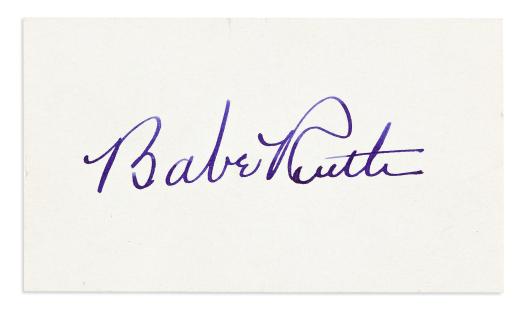

47
Ruth, babe.
Signature on a small card, in purple ink.

Np, nd
2x3½ inches; uncommonly good condition.



48
(suffragettes.)
Two cards, each dated and Signed: Susan B. Anthony * Julia Ward Howe.

Rochester, 3 October; Np, April 1895
Each approximately 2¼x3¾ inches; faint scattered soiling, remnants of prior mounting at corners verso.

49
(supreme court.) brandeis, louis d.; and benjamin n. cardozo.
Two Autograph Letters Signed, each by one, each to Ben B. Lifflander.

Washington, 8 March 1935
Brandeis. Declining to comply due to “judicial office” and thanking for his generosity. Cardozo. Thanking for sending an article and remarking, “I treasure the good will of my brethren of the bar.” Each 1 page, 8vo, “Supreme Court of the United States” stationery; mounted to larger board, faint marginal discoloration from prior matting, horizontal folds. Each with the original envelope.



COMMITTEE THAT INVESTIGATED WATERGATE
50
(watergate.)
Rules of Procedure for the Select Committee on Presidential Campaign Activities Signed by each member of the Committee

[Washington: United States Senate, 1973]; inscriptions: Np, circa 1973
except Herman Talmadge, on front cover. 6x4 inches, printed wrappers, staple binding; faint dampstaining along spine and upper edge of covers, minor cockling to covers. With Sam Ervin’s Senate envelope addressed to NBC Radio correspondent Bob McCormick.
Sam J. Ervin, Jr • Howard H. Baker • Edward J. Gurney • Daniel K. Inouye • Joseph M. Montoya • Lowell P. Weicker • Rufus Edmisten • Fred Thompson.



INCLUDES CHAIRMAN PETER RODINO, ELIZABETH HOLTZMAN, HAMILTON FISH, JR.
51
(watergate.)
Statement of Information: Hearings Before the Committee on the Judiciary, House of Representatives Signed by 28 members of the Judiciary Committee that submitted the Articles of Impeachment against Richard M. Nixon,

Washington, U.S. Government Printing Office, 1974; inscriptions: [1974]
on front cover. Ink stamp at lower left: “Not for release until Friday AM EDT 7/12/74.” Lacking signatures of 10 Republican committee members, including Trent Lott. 271 pages, 4to, printed wrappers; faint scattered staining at edges affecting two letters of Waldie signature, minor creasing at lower right corner.
With–Group of 6 items: George McGovern: TLS, “George,” to William Dixon, with 4-line autograph postscript signed, recalling the 1972 presidential campaign and sending an article [not present]. 1 page, 8vo. Washington, 7 November 1973 • Another copy of the Statement of Information, Signed by Nixon’s chief legal counsel James D. St. Clair, on front cover. Np, [1974] • Two copies of Application of the Twenty-Fifth Amendment to Vacancies in the Office of the Vice President, one Signed by Gerald R. Ford on front cover, the other Signed and Inscribed to Dixon by Nelson Rockefeller on inside front cover, in green ink. Each 469 pages, 8vo, wrappers. Washington, 1973; inscriptions: [1973] • Two offprints of Congressional reports, unsigned: Confirmation of Gerald R. Ford as Vice President of the United States, and Confirmation of Nelson A. Rockefeller as Vice President of the United States. 70 or 50 pages. 8vo, self-wrappers, stapled binding. [1973; 74]. Provenance: From the files of William Patrick Dixon.



SIGNED DURING THE U.S. OCCUPATION OF JAPAN
52
(world war ii.) macarthur, douglas.
Photograph Signed and Inscribed, “To Congressman Judd / With best wishes / Douglas MacArthur / Tokyo - 1947,”

Tokyo, 1947
The photograph, bust portrait showing him in 5-star general’s uniform. Signed in the image, lower right. 10x8 inches; faint scattered soiling, short closed tear at lower edge (not affecting portrait).

53
(miscellaneous.)
Group of 4 items Signed, or Signed and Inscribed: Chaim Gross * Paul Signac * Louis D. Brandeis * Johannes Wolff.

Vp, vd
Format and condition vary.
Gross. Ink drawing on cover of exhibition catalogue for “Sculpture, Drawings” held at Forum Gallery in New York beginning March 21, 1967. The drawing, showing a woman dancing. Small 4to, printed wrappers, staple binding; 3 color plates detached. Np, nd • Signac. ALS, “P. Signac,” to “My dear friend,” in French, inviting him on behalf of the Société des Artistes Indépendants to a dinner, and sending information on Dutch painter Lucas van Leyden [not present]. 1½ pages, 8vo, written on a folded sheet; moderate offsetting and scattered smudging. Np, [19 March 1888?] • Brandeis. ALS, to B.D. Roberts: “My thanks for your thoughtful letter of the 20th.” 1 page, 8vo, personal stationery. Washington, 25 April 1939. With the original envelope • Wolff. ALS, to the wife of Edvard Grieg’s brother, Mrs. John Grieg, in German, declining an invitation and asking to convey greetings to Edvard and Nina Grieg. 3 pages, 12mo, written on a folded sheet. London, “Sun. evening” no year.
Presidents



BUYING TWO HORSES
54
Adams, john quincy.
Autograph Document Signed, as Secretary of State, in the third person within the text,

Washington, 5 November 1817
receipt written out for signature of B.R. Jenkins who received $400 from Adams for two coach horses. Additionally signed by Jenkins and a witness, 3-line docketing in holograph on verso. 1 page, oblong 8vo; folds.
”. . . Received of John Quincy Adams, the Sum of four hundred dollars, for a pair of Bay Coach Horses, one four and the other five years old, which I warrant to be Sound wind and limb, and without fault.”



55
Adams, john quincy.
Partly-printed vellum Document Signed, “J.Q. Adams,” as President,

Washington, 15 May 1828
land deed granting 160 acres in Lexington, MI to Isaac Groom. Countersigned by George Graham as Commissioner of the General Land Office. 9½x15½ inches; few small worming holes at folds, faint scattered foxing, docketing on verso, seal mostly intact.



THE ONLY FORMER PRESIDENT ELECTED TO THE HOUSE OF REPRESENTATIVES
56
Adams, john quincy.
Signature, “J.Q. Adams,” as Representative, on a petition recommending George McClure[?] for a midshipman appointment in the Navy.

Washington, 2 January 1838
Additionally signed by 11 others, including MA Representatives Richard Fletcher (in whose hand the text of the petition is written), John Reed, Caleb Cushing, George Grennell Jr., William Calhoun, Nathaniel B. Borden, George N. Briggs, Levi Lincoln Jr., William S. Hastings and two others. 1 page, 4to; remnants of prior mounting on verso at lower corners and upper edge, faint scattered staining, folds.

57
Adams, john quincy.
Three clipped Signatures, each on a slip of paper.

Np, nd; Washington, 1842
The second and third additionally inscribed: “Yours faithfully” or “Quincy / Massachusetts.” ½x2½ or 1x5 or 2x6¼ inches; the first mounted to a larger sheet and with faint scattered foxing, the third with place and date inscribed at lower left in unknown hand.



58
Adams, john.
Clipped Signature, “J Adams,” likely a franking signature removed from an address panel, mounted to a strip of vellum.

Np, nd
¾x1½ inches; inscription in unknown hand touching lower extreme of signature.



59
Adams, john.
Signature, as President, on a clipped portion of a partly-printed vellum document

Washington, 29 September 1800
including only the last few lines and a portion of seal, likely removed from a land grant issued to a soldier. Additionally signed by Secretary of War Samuel Dexter on verso. 2½x11 inches;



60
Adams, john.
Franking Signature, “J Adams,” on an address panel,

Quincy, 15 December no year
addressed to Alexander B. Johnson in an unknown hand. 3x4¾ inches; mounted to larger sheet, moderate scattered foxing.

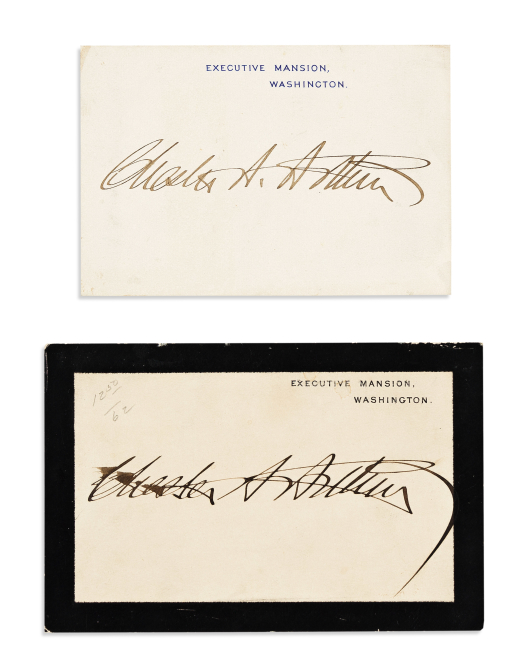

ONE WITH MOURNING BORDER, POSSIBLY CHOSEN IN RESPONSE TO GARFIELD'S DEATH
61
Arthur, chester a.
Two Signatures, as President, each on an Executive Mansion card.

Washington, nd
The first, heavy mourning border. 3¼x5 or 2¾x4¼ inches; first with minor smudging, second with minor paperclip stain at upper right, remnants of prior mounting on verso.
Vice President Arthur assumed the presidency in September of 1881 when James A. Garfield died from complications relating to the gunshot wound he sustained from his assassin.



PRESIDENTIAL PARDON
62
Buchanan, james.
Document Signed, as President, pardon of Joseph Cunningham.

Washington, 11 October 1859
Countersigned by the Secretary of State Lewis Cass. 2 pages, 16x10¾ inches, written on the recto and verso of a single sheet; short closed tears at center touching text (without loss) repaired with cello tape recto, faint scattered foxing and bleedthrough, folds, paper seal intact.
”. . . Cunningham, in the act of rendering assistance to the Deputy Warden of the said Penitentiary, and while actually grappling with one Lyons, a refractory prisoner, received and was severely wounded by a pistol shot aimed at the said Lyons. . . . [T]he said Penitentiary, after a full investigation of the facts, in view of the meritorious conduct of said Cunningham on this occasion, has recommended a remission of his punishment. . . .”

63
Buchanan, james.
Two Documents Signed, each as President.

Washington, 19 June 1858; 6 June 1860
The first, appointing William Mechlin Second Auditor of the Treasury during the absence of Thomas James Duncan Fuller. The second, partly-printed, authorizing the Secretary of State to affix the Seal of the U.S. to “a Warrant for the remission of certain forfeitures to Lemuel Moore and to Benjamin F. Duval, administrator of the estate of David Barnett, deceased.” Each ½ page, 4to, first with integral blank, second pale blue paper; second with faint toning to edges, horizontal folds.



64
Eisenhower, dwight d.
Partly-printed Document Signed, as President,

Washington, 23 August 1957
appointing Walter H. Judd a U.S. Representative from MN to the 12th session of the General Assembly of the United Nations. Countersigned by Secretary of State John Foster Dulles. 19x23 inches; paper seal intact.



65
Eisenhower, dwight d.
Large Photograph Signed and Inscribed, “For Congressman Walter H. Judd / with best wishes and / warm regard to an American statesman, / from his old friend,”

Np, nd
bust portrait showing him as president, holding his eyeglasses. Inscribed in the blank lower margin. 13¾x11 inches; minor scattered fading to inscription (but legible, mostly bold), mounted to board trimmed to size.

66
Eisenhower, dwight d.
Three items, each Signed and Inscribed, “Dwight D. Eisenhower” or “D.E.,” two as President, to U.S. Ambassador to Ireland, R.W. Scott McLeod: Large Photograph * Two Typed Letters.

Np, circa 1960; Washington, 9 May 1960; 19 January 1961
The photograph, “For Scott McLeod / with best wishes,” half-length portrait by Nickolas Muray, showing him seated at his desk poised to write on a pad. Inscribed in the blank lower margin. 14x11 inches; crease at lower left, few scattered dings, label on verso credits Muray and indicates that the photo was reproduced by the U.S. Army Signal Corps. The letters, explaining that Eisenhower referred his own brother’s family to McLeod for guidance about what to see during their visit to Ireland, expressing gratitude for his service, and hoping that he would continue to be active after the end of the Eisenhower administration. Each 1 page, 4to, White House stationery; the first with pinholes at upper left, the second with faint toning at extreme edges, horizontal folds.
19 January 1961: “. . . From a lifetime of Federal service, I have become much aware that the conventional rewards from productive labor are not usually received in public service; but there is a reward from public service not achievable in any other enterprise, and that is the abiding satisfaction of knowing that you have done your honest best to build a stronger and better nation . . . . “. . . [T]he principles and programs that we of this Administration have collectively advanced this past eight years need continuing support . . . . I hope and trust that you will find opportunity to remain personally active in the cause of sensible, good government in our country.” With–Dwight D. Eisenhower. Typed Letter, bearing secretarial signature, to Ambassador McLeod, thanking for a gift. 1 page, 4to, White House stationery. [Washington], 3 January 1958.



67
Grant, ulysses s.
Partly-printed Document Signed, “U.S. Grant,” as President,

Washington, 2 May 1871
authorizing the Secretary of State to affix the Seal of the United States to “a Warrant for the commutation of the sentence of Charles Purdue.” 1 page, 4to, pale blue paper, with integral blank; short closed tear in left edge repaired verso with paper, cello tape at upper left, faint scattered foxing, horizontal folds.
Charles Purdue, a seaman aboard the Robert Edwards in the spring of 1871, was accused of inexplicably setting fire to the ship, causing all on board to abandon the vessel. Although he was charged and convicted of arson, no lives were lost, and Purdue claimed that his confession of the crime had been extorted.



68
Grant, ulysses s.
Signature, “U.S. Grant,” on a sheet additionally signed by his Secretary of State Hamilton Fish,

Np, [1874-1902]
and also by U.S. Army Generals Leonard Wood and Joseph Wheeler. 1 page, 8vo; horizontal fold.



69
Grant, ulysses s.
Two clipped Signatures, “U.S. Grant.”

“Hdqrs”, 28 April 1866; Np, nd
The second additionally inscribed, “Lt. Gen. U.S.A.” 1¼x3 or 2½x5 inches; each with remnants of mounting on verso, the first with rank and date inscribed in unknown hand.



70
Harrison, william henry.
Autograph Document Signed, “Wm H Harrison / A[ide] De C[amp],” provision return, ordering the contractor to issue rations

Np, circa 6 March [1794?]
“for one guide for six days commencing the 1st & ending the 6th of March inclusive . . . .” 1 page, 3½x6¼ inches; short closed separation at vertical fold repaired verso with tissue, faint scattered bleedthrough, fragment of unrelated holograph inscription on verso suggesting this document written on scrap.



WRITTEN IN DAYS FOLLOWING SIGNING OF TREATY OF GREENVILLE
71
Harrison, william henry.
Autograph Document Signed, “WmHHarrison / aid[e] de camp,” ordering food for the Shawnee:

Greenville [OH], 22 August 1795
“For the Shawanoes issue fifty pounds of flour and one quart of salt.” 3x6 inches; faint scattered staining, small hole at center (without loss to text), folds, remnants of prior mounting at upper corners verso, docketing verso.

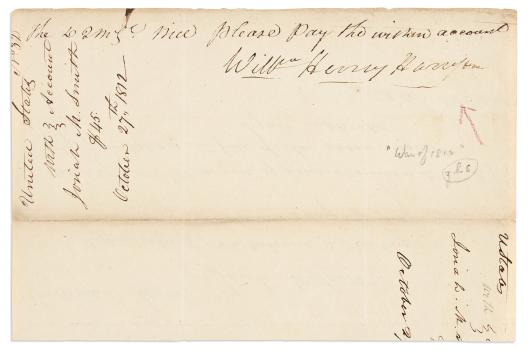

72
Harrison, william henry.
Endorsement Signed, “Will’m Henry Harrison,” ordering Lieutenant Quartermaster General James Morrison to pay the request written in another hand on verso.

Np, circa 27 October 1812
The request, $45 for a 15-day express ride from Urbanna to Pittsburg to Franklinton for Josiah M. Smith. 5¼x8 inches; lacking mostly-blank lower panel (affecting only docketing), red pencil arrow pointing to signature, receipt signature on verso.



73
Harrison, william henry.
Autograph Letter Signed, “W.H. Harrison,” to “Hon[orab]le Ja’s [John?] C. Calhoun,”

Washington, 7 March 1819
recommending J. Edwardson to the position of Assistant Deputy Quartermaster, noting that Edwardson was praised in the Army and that MI territorial “Gov[erno]r Cass also desired me to give his name in support of Mr. E’s appointment . . . .” 1 page, 4to, complete separation at horizontal fold forming two pieces, other separations at folds repaired verso with tissue, cello tape stain at upper edge.



74
Harrison, william henry.
Autograph Document Signed, “W.H. Harrison,” draft on the Bank of the United States at Washington

Np, nd
in the amount of $18.50 to Mrs. Clark. 1 page, 2½x7 inches; cancellation slices touching text with minor loss, red pencil marking at lower center, remnants of prior mounting along upper edge verso, vertical fold.



75
Jackson, andrew.
Brief Autograph Letter Signed, as Major General, to Colonel Robert Butler,

Nashville, 15 July 1815
requesting that he certify the abstracts for the provisions given to the Creek Indians. 1 page, oblong 8vo; silked on recto and verso, folds, docketing on verso.
“Col. Robert Butler adjutant general for the Division of the South will please examine the abstracts for provisions furnished the Creek Indians, under the contract of Ward & Johnston compare them with the Vouchers and if found correct will certify them.”



76
Jackson, andrew.
Two clipped Signatures with rank, each on a small slip of paper: “Andrew Jackson / Major Gen’l Com’dg.”

Np, [1814-20]
The first additionally inscribed, “D[ivision] of the South.” 1x5¼ or 1½x4¼ inches; the second mounted to larger sheet and with faint scattered bleedthrough.



PAYING THE FIRST US IMPORT DUTY
77
Jefferson, thomas.
Partly-printed Document Signed, “Th:Jefferson,”

[Philadelphia], 7 September 1793 [from docketing]
certifying the accuracy of the invoice [not present] which lists the cost of, and duty paid for, items imported by Thomas Jefferson. Countersigned by Collector Sharp Delany and Naval Officer William Macpherson. 1 page, 6½x8 inches; faint soiling along vertical folds touching signatures (without loss).
On July 4, 1789, “An Act for laying a Duty on Goods, Wares and Merchandise Imported into the United States” was approved, becoming the first U.S. tariff act and only the second law passed under the new Constitution. The revenue generated was intended for, among other things, “the support of government, for the discharge of the debts of the United States, and the encouragement and protection of manufactures,” the most significant debt being that incurred from the Revolutionary War. A collector and Naval officer were appointed and stationed at what was deemed the nation’s sole port of entry, Philadelphia. The highest duties were imposed on luxury goods, up to 15 percent for items such as carriages.



78
Jefferson, thomas.
Franking Signature, “Th:Jefferson,” as Secretary of State, on an address leaf

[Philadelphia], 20 November 1793 [from docketing]
with holograph address to merchant John Mason. 8x10 inches; seal tear repaired with tissue verso, folds, docketing at lower right.

79
Jefferson, thomas.
Two clipped portions of partly-printed Documents Signed, “Th:Jefferson,” as President, each a fragment of a four-language ship’s papers,

[Washington], 28 May; 23 December 1807
each showing only a portion of the English and Dutch parts. The first, 4½x7¾ inches; slight fading to signature, horizontal fold. The second, including portions accomplished for the Ship The Ann departing New York for London. 9x8¾ inches; closed tear affecting signature repaired verso with cello tape, complete closed separation at horizontal fold forming two loose parts, chipping and toning along right edge, faint staining at center and along upper edge.

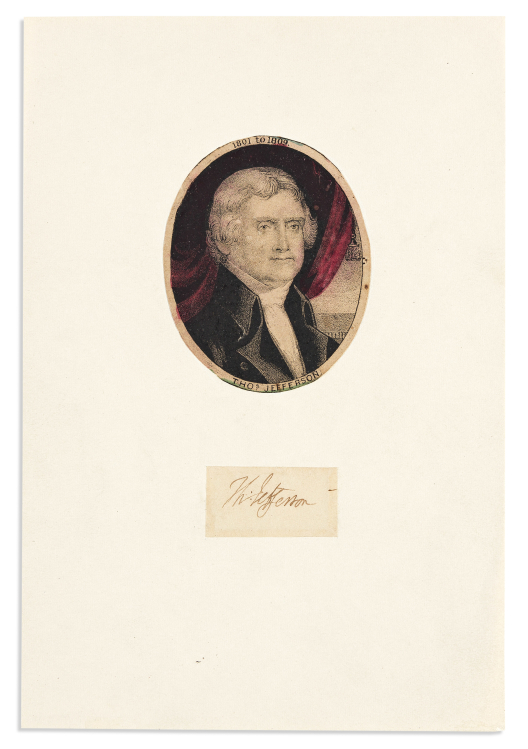

80
Jefferson, thomas.
Clipped Signature, “Th:Jefferson,” inlaid into a sheet with a printed portrait.

Np, nd
¾x1½ inches.



81
Jefferson, thomas.
Clipped Signature, “Th:Jefferson,” likely removed from a letter.

Np, nd
¾x2½ inches; silked on verso.



82
Johnson, andrew.
Partly-printed Document Signed, as President,

Washington, 4 November 1868
authorizing the Secretary of State to affix the Seal of the United States to “a Warrant for the arrest of John Cramer.” 1 page, 4to, pale blue paper; some smudging to signature, horizontal folds.



83
Johnson, lyndon b.
17 Signatures on a sheet of Air Force One stationery.

Np, nd
1 page, small 8vo.

84
Johnson, lyndon b.
Archive of 7 Typed Letters Signed, “Lyndon” or “Lyndon B. Johnson,” as Senator or Vice President, to U.S. Ambassador to Ireland, R.W. Scott McLeod,

Washington or Austin, 1956-61
sending personal greetings, thanking for gifts, or requesting details concerning his suggestions for immigration law reform quoted in recent newspaper article. Together 7 pages, 8vo or 4to; few with pinholes or punch holes at upper edge, folds.
10 June 1957: “I noticed in the paper this morning that you feel the need of a revision of the immigration laws. I would appreciate it very much if you could take the time to advise me confidentially and on a personal basis as to the detailed recommendations which you would make.” 21 December 1959: “. . . I want to be as helpful as I possibly can. I don’t know for sure what all I might do. However, I think it might be well for me to have a talk with John Rooney and I will endeavor to do so as soon as I get back to Washington in January. I will also see what can be done with Wayne Hays.” . . .” With–(Lyndon B. Johnson.) Archive of 7 letters to McLeod, each signed in Johnson’s name by a secretary, sending personal greetings, forwarding letters [not present], or requesting a reception in Ireland of a friend. Together 7 pages, 4to or 8vo. [Washington], 1957-60.



85
Lincoln, abraham.
Autograph Document, unsigned, 11-line court order for the case of William D. Enyart v. Smith McAtee.

[Springfield, 1849]
With testimonial signed by Edwin S. Walker, written at lower edge of page, stating that the case was heard before Judge David Davis at Sangamon County Circuit Court on September 11, 1849. ½ page, folio; moderate staining at edges and along center horizontal fold, complete separations at horizontal folds repaired verso with tissue.
“This day came the parties, and by agreement, the cause is set down for hearing at the next term of this court, till when, by agreement, the defendant is enjoined and restrained from cutting any timber, or doing any work whatever, upon the land in question, or on any part thereof, by the removal of fallen timber, or of rails made form timber on said land, or any other wise howsoever. And it is, by the court, ordered and decreed accordingly, and the cause is continued.”

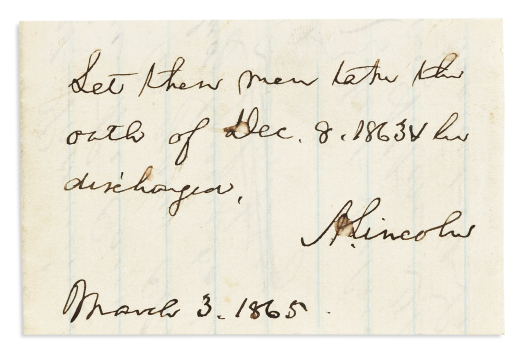

FREEDOM FOR CONFEDERATE PRISONERS
86
Lincoln, abraham.
Clipped portion of Autograph Endorsement dated and Signed, “A. Lincoln,” as President:

[Washington], 3 March 1865
“Let these men take the / oath of Dec. 8, 1863 & be / discharged,” removed from a letter likely appealing to him for release of the men. 2x3¼ inches, ruled paper; backed, faint bleedthrough from letter written vertically on verso.
In his “Proclamation of Amnesty and Reconstruction,” issued December 8, 1863, Lincoln offered a pardon and restoration of property to all participants in the rebellion against the Union who take an oath (with certain exceptions). The oath specifically requires the “support [of] all acts of congress passed during the existing rebellion with reference to slaves . . . .”



87
Lincoln, abraham.
Clipped Signature, “A. Lincoln,” likely removed from a personal deed.

Np, nd
½x1¾ inches, pale blue ruled paper; mounted to verso of late 19th-century business card of New York real estate broker John O. Hoyt.



88
Lincoln, abraham.
Clipped Signature, “Yours truly / A. Lincoln,” on a slip of paper,

Np, nd
likely removed from a letter. 1¼x2¼ inches; mounted to board trimmed to size, ink border added by previous owner at all edges, moderate scattered soiling overall.

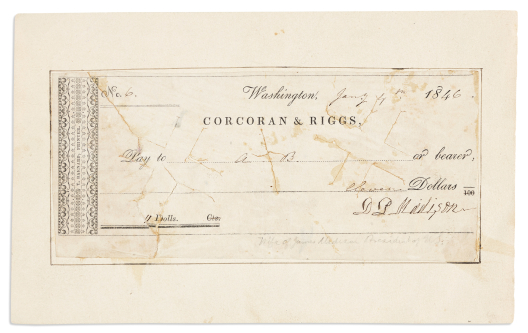

89
Madison, dolley.
Check Signed, “DP Madison,”

Washington, 4 January 1846
to “A.B.,” in the amount of $11 drawn on Corcoran & Riggs. 2¾x6¼ inches; mounted to larger sheet, cancellation slices touching text, faint scattered staining.



90
Madison, james.
Letter Signed, as Secretary of State, to Secretary of the Treasury Albert Gallatin,

Washington, 12 October 1801
sending receipts of Captain Jereovich of the Ragusan Brigantine Benevenuto for payments to him amounting to $681.25 [not present], and requesting that a warrant be issued for that amount to Collector of New York David Gelston. With 3-line holograph endorsement signed by Gallatin on terminal page. 1 page, 4to, with integral blank; loss to few words of text at horizontal fold expertly repaired verso with tissue, folds reinforced verso with tissue, minor staining at upper edge.
“I . . . enclose the receipts of Capt. Jereovich . . . for [$681].25 paid to him in the name of William Eaton, the Consul at Tunis, by David Gelston . . . . Be pleased . . . to cause a warrant to be issued . . . upon the appropriations for Barbary negotiations, charging it to Mr. Eaton.”

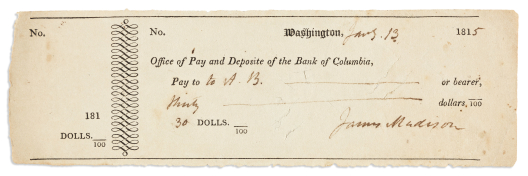

91
Madison, james.
Check accomplished and Signed, as President,

Washington, 13 January 1815
to A[aron?] B[urr?] in the amount of $30, drawn on the Bank of Columbia. Includes intact check stub. 2½x8 inches; cancellation slices repaired with tissue verso, one slice touching signature (without loss).



WARTIME PROVISIONS
92
Monroe, james.
Brief Autograph Letter Signed, “Ja’s Monroe,” to “Mr. Miller”:

Powhatan, 27 September 1782
“If you have any spirit or very good rum let me have by the bearer two or three gallons, also one cloak[?] brush.” Addressed in holograph on verso (“Mr Miller”). 2¾x7¼ inches; few scattered pin holes, folds, faint foxing to side edges, docketing on verso.



J.Q. ADAMS AND MONROE
93
Monroe, james.
Partly-printed vellum Document Signed, as President,

[Washington], 13 April 1821
passport for the brig Baltic of New Bedford. Countersigned by Secretary of State John Quincy Adams. 14½x10 inches, upper edge scalloped; folds, small hole above Monroe signature with minor loss to text, lacking paper seal, faint scattered soiling, docketing on verso, bold signatures.

94
Monroe, james.
Three partly-printed vellum Documents Signed, as President, each granting land to various parties.

Washington, 6 June 1817; 2 December 1823; 24 May 1824
The first, a quarter lot near Wooster, OH to John Lytle. The second, one-half acre in Tuscaloosa, AL to John Hodge. The third, 150 acres near Shawneetown, IL to Robert B. Knight. Each countersigned by Commissioner of the General Land Office Josiah Meigs or George Graham. Each approximately 9x15 inches; moderate scattered foxing to first and last, first docketed on verso, folds, paper seals intact.

INCLUDES PRESIDENTIAL PARDON
95
Pierce, franklin.
Two items: Partly-printed Document Signed, as President * Clipped Signature.

Washington, 17 January 1857; Np, nd
The document, authorizing the Secretary of State to affix the Seal of the United States to “the pardon granted to John Moriarty.” 1 page, 4to, pale blue paper, with integral blank; horizontal folds. The signature: “Very respectfully / Y’r friend, Serv’t / Franklin Pierce,” on a slip of paper. 2½x5 inches; horizontal fold.



APPOINTMENT SIGNED DURING MEXICAN-AMERICAN WAR
96
Polk, james k.
Partly-printed vellum Document Signed, as President,

Washington, 20 January 1847
military commission appointing Arthur B. Ramirez Assistant Quarter Master. Countersigned by Secretary of War William L. Marcy. 13¾x16½ inches; some fading to signature and text (but still legible), folds, paper seal intact.

97
Roosevelt, franklin d.
Group of 4 Typed Letters Signed, to various recipients,

Vp, 1917-31
thanking for writing or for contribution to U.S. Navy’s “Eyes for the Navy” program. Each 1 page, 4to, “Navy Department” or “Fidelity and Deposit Company” or “Executive Chamber” stationery; first with small hole at upper edge and moderate staining at lower right, horizontal folds.
TLS, s Assistant Secretary of the Navy, to Manning Cleveland, thanking for letter regarding “certain conditions in Poughkeepsie” and promising to launch an investigation in to the matter. Washington, 8 March 1917 • TLS, as Assistant Secretary of the Navy, to Albert R. Merrill: “Your prompt and patriotic response to the NAVY’S call for binoculars, telescopes, and spy-glasses, is most appreciated. . . .” Washington, 31 December 1917 • TLS, to Miss A. Hamam, expressing gratefulness for her thoughts and note. Warm Springs, 14 November 1928 • TLS, as Governor, to Julius J. Frank, thanking for his letter and information. Albany, 4 1931.



98
Roosevelt, franklin d.
Signature, as President, on a White House card.

Washington, nd
2¾x4¼ inches; remnants of prior mounting along upper edge verso.

99
Roosevelt, theodore.
Three Typed Letters Signed, in full or “T. Roosevelt,” to various recipients.

New York, 8 May 1895; 25 November 1911; 6 October 1917
The first, as NYC Police Commissioner, to Paul V. Bunn, expressing satisfaction at Bunn’s accomplishments while at the Civil Service Commission, and declining any credit for them. The second, to Milt Goodkind, thanking him for his amusing letter and expressing hope of meeting. The third, to George W. Brush, thanking him for his letter. Each 1 page, oblong or square 8vo, two on either “The Outlook” or “Metropolitan” stationery; each trimmed at all sides, folds, first with remnants of mounting at corners verso, second with slight fading to portion of signature.



DENYING THAT U.S. AGENCY PROVIDED "WIVES" FOR PANAMA CANAL LABORERS
100
Taft, william howard.
Typed Letter Signed, “WmHTaft,” as Secretary of War, to Washington correspondent for The Sun Richard V. Oulahan,

Washington, 10 January 1906
sending copies [not present] of evidence he is submitting to Congress confirming his own opinion concerning the government transportation of women from Martinique to Panama. 1 page, 8vo, “War Department” stationery, with integral blank; staining from cello tape remnants at upper left and lower right.
“In the . . . papers accompanying the President’s Message, I have included an addendum to the exhibit about the importation of Martinique women . . . . I do not think it is of great importance, because it only confirms my previous denial . . . .” On November 25, 1905, the New York Herald published an article from a correspondent in Panama alleging that the Isthmian Canal Commission (ICC: the U.S. agency overseeing construction of the Panama Canal, headed by Taft) was responsible for providing “wives” brought from Martinique for local laborers, and that the women were not fully informed about what was proposed when they agreed to be brought to Panama. Taft denied that any transport of women was being conducted under the authority of the ICC.



101
Taylor, zachary.
Endorsement Signed, “Z. Taylor, B[reve]tB[rigadie]rGen[era]l / U.S.A Com[man]d[in]g,” requesting that field musicians be supplied

“Fort Smith,” 24 February 1844
to the 6th Regiment Infantry, written on the terminal page of Lieutenant James Belger’s letter to Lieutenant Colonel Loomis describing the lack of adequate musicians in his regiment. Additionally endorsed by Loomis on panel beside Taylor’s endorsement. 1 page, 4to, ruled paper, with integral blank; folds.
Letter from Loomis, February 14, 1844: “. . . There are but two drummers and two fifers with the four companies of the Regiment serving at Fort Towson, of whom one drummer and one fifer are young boys, not able to perform their duty, and will not be for some time. There is also one drummer and fifer with the two companies at Fort Smith, and by the 10th of March next, there will be but two fifers and one drummer with the four companies at this Post. . . .”



102
Truman, harry s.
Typed Letter Signed, as President, to Emil Hurja,

Washington, 27 April 1949
thanking for an original letter by James A. Garfield presumably for Truman’s autograph collection. 1 page, 4to, White House stationery, with integral blank; trace of cello tape at upper edge, horizontal fold.
“I appreciated most highly your sending me the handwritten letter of James A. Garfield, dated December 6, 1880. It is most interesting and I am very happy to have it. . . .”

103
Truman, harry s.
Two Typed Documents Signed, as President, each appointing Walter H. Judd Alternate Delegate to the signing of a U.S. Security Treaty in 1951.

Washington, 20 August 1951
The first, for treaty with the Republic of the Philippines in Washington on August 30. The second, for treaty with Australia and New Zealand in San Francisco on September 1. Each countersigned by Secretary of State Dean Acheson. Each 1 page, folio, with integral blank; few minor scattered creases, paper seals intact.

104
Tyler, john.
Two partly-printed Documents Signed, as President, each ordering the Secretary of State to affix the Seal of the U.S. to an exequatur.

Washington, 15; 21 April 1842
The first, to [Consul for France] Jean Jacques Aversenc. The second, to [Consul for Netherlands] Stevenson Forbes. Each 1 page, 4to, with integral blank; first with remnants of cello tape at upper and left edges, horizontal folds.



SITTING PRESIDENT READY TO SELL LAND IF BUYERS "ACT LIKE FAIR AND CANDID MEN"
105
Washington, george.
Autograph Letter Signed, “G:Washington,” as President, to Ebenezer Tucker,

New York, 24 January 1790
suggesting that the parties interested in the tract of land Washington has to sell [on Millers Run in Washington County, PA] name their price only after examining the tract. 1 page, 4to; silked on recto and verso, edges reinforced, faint scattered foxing, docketing on verso.
”. . . It is my sincere opinion that the land mentioned in it is worth what I asked for it–to wit four dollars per acre . . . . [L]et those, who are really inclinable to buy, come forward, like men that are in earnest, and say what they will give–If they, or their Agent have seen the land, (and without this it is useless to name any price) have examined its qualities and improvements, they can say what they will give, and ought to act like fair and candid men–On these terms I am ready to treat with them. It is not my intention to dispose of the land for a song, nor is it my wish to higgle, or make many words to the bargain–for which reason I pray them to come to a decision at once, and that you would inform me of the result . . . .”



106
Washington, george.
Autograph Manuscript, unsigned, 4 holograph lines recording payment of his debt to George Thornton

Fredericksburg, 27 November 1772
on a receipt, in another hand, giving an accounting of hardware he purchased from Thornton between 1771 and 1772: “Fredericksburg Nov’r 27th 1772 / Then Received the above Sum / of Three pounds fifteen shillings / and eight pence.” With signature of Thornton’s agent, Michael Robinson, Jr. 1 page, 8¼x7 inches; remnants of cello and masking tape repairs at edges verso, brittling at edges, folds, docketing on verso in holograph.



WASHINGTON THE BUSINESSMAN APPROVES COMPANY PAYROL.L
107
Washington, george.
Endorsement Signed, “G:Washington,” as President of the Potomac Company,

Alexandria, 26 September 1785
authorizing the Company payroll of £33.18.8 for the workmen at Seneca Falls from August 20th to September 3rd, 1785, on the verso of a list of the worker names and pay amounts. Additionally endorsed by two other Company directors, George Gilpin and John Fitzgerald. 2 pages, 15x6 inches, with integral blank; few nearly complete separations at folds, faint bleedthrough overall.
In addition to listing the hours worked and pay for each worker, the payroll includes a few pay deductions for worker drunkenness.

RESPONDING TO JAPANESE SHIPPING MONOPOLY DURING PARIS PEACE CONFERENCE
108
Wilson, woodrow.
Two Typed Letters Signed, as President, to former Chairman of the Federal Trade Commission Edward N. Hurley.

Washington, 11 October 1917; Paris, 9 January 1919
The first, encouraging him to attend a conference between various agencies of the government and the Harbor Development Commission [which created Port Authority]. The second, sending a letter from Secretary of State Robert Lansing [present] and asking, in full: “Is there anything possible to be done about this? It is clearly a serious situation, and I should like to see it relieved.” Together 3 pages, 4to, the first on White House stationery in two sheets, the second on “The President of the United States” embossed stationery with integral blank; horizontal fold, the first with few small holes along upper edge, the second with paper clip stain at upper left.
11 October 1917: “I recently had an occasion to discuss with the New York, New Jersey Port and Harbor Development Commission the important purposes for which they were constituted a joint commission, and I suggested to them that it would be very beneficial if they could be guided in their study of projects and development by the best opinion of the departments of the Federal Government chiefly concerned. I, therefore, suggested to them . . . a conference between their board and the Secretary of War, the Secretary of the Navy, and the Chairman of the Shipping Board. . . .” With–Two items: Typed Letter Signed by Robert Lansing to President Wilson, sending a telegram [present], arguing that Japanese monopoly over shipping routes in the Pacific has driven rates unacceptably high, suggesting that Europe might divert a portion of their shipping to alleviate the problem, and recommending that he bring the matter to Hurley’s attention. 2 pages, small 4to, “Secretary of State” stationery. Paris, 6 January 1919 • Telegram from Counselor of the United States Department of State Frank Polk to Robert Lansing, describing the problem summarized in Lansing’s letter. 1 page, 4to, telegram form. Washington, 3 January 1919. In 1917, the legislatures and governors of New York and New Jersey formed the New York-New Jersey Port and Harbor Development Commission with the aim of coordinating responses to the various problems concerning the Port of New York. The result of the Commission’s work was the creation of the Port Compact, an agreement between New York and New Jersey to create the Port Authority, signed by representatives of both States on May 1, 1921.

109
(presidents–white house cards.)
Group of 14 White House or Executive Mansion cards, each Signed, as President, some additionally dated.

Washington, vd
Each 2¾x4¼ inches; Hayes moderately stained and discolored from prior matting, one Coolidge mounted to larger sheet, few with remnants of prior mounting verso.
Rutherford B. Hayes. “RBHayes” • Grover Cleveland (4). Two additionally dated, “April 1894” or “Jan 8. 1897” • Warren G. Harding (2) • Calvin Coolidge (5) • Herbert Hoover (2). With–Group of 7 White House cards, each bearing a signature by a secretary: Dwight D. Eisenhower • Richard Nixon (6). Each 2½x4 inches. Nd.

PRESIDENTIAL PARDONS
110
(presidents.)
Three partly-printed Documents Signed, each as President, each a pardon: Martin van Buren * Franklin Pierce * Rutherford B. Hayes.

Washington, 3 March 1840; 23 December 1855; 17 July 1879
Each authorizing the Secretary of State to affix the seal of the United States to the pardon. Van Buren. “M. VanBuren,” ordering “the pardon of James Fildes, Edward Shurlock, George Wigmore, William Graham, John Baker, John Hayes, Chris Gildmore and John Brown, eight of the crew of the Ship Queen Adelaide.” Pierce. Ordering the pardon of Samuel N. Direy. Hayes. “R.B. Hayes,” ordering “a warrant commuting the sentence imposed upon Catherine Bailey.” Each 1 page, 4to, with integral blank, pale blue paper; Van Buren document with closed tears at center repaired verso with paper (without loss), each with faint scattered soiling, remnants of cello tape at upper edge recto, horizontal folds.

111
(presidents.)
Group of 8 Franking Signatures, most clipped: James Madison * John Quincy Adams * Martin Van Buren * John Tyler * Millard Fillmore * James Buchanan (2) * Andrew Johnson.

Vp, vd
Each 3x5½ inches or smaller; Van Buren and Tyler and Buchanan and Johnson mounted to larger sheet, slight fading to one Buchanan.
Madison. “Free James Madison,” on holograph address panel to B.H. Rand. Orange, 19 February no year • Adams. On holograph address panel to his wife. Np, nd • Van Buren. “Free / M. Van Buren.” Kinderhook, 1 March no year [from postmark] • Tyler. “J. Tyler,” on holograph address panel to J.J. Albert. Charles City, 7 April 1847 • Fillmore. “Free / M. Fillmore,” on holograph address panel to Cyrus Powers. Buffalo, 30 January no year [postmark] • Buchanan (2). Each “Free / James Buchanan.” Np, nd • Johnson. “U.S.S. / Andrew Johnson.” Washington, 8 February 1861 [from postmark].

112
(presidents.)
Group of 4 checks, each Signed, two as President, most additionally accomplished in holograph.

Vp, 1871-1932
Each 3x8 inches or smaller; generally good condition.
Chester A. Arthur. “C.A. Arthur,” to Keating & Co. in the amount of $50. New York, 28 December 1871 • Benjamin Harrison. “BenjHarrison,” as President, to the “Ind[iana]p[o]l[i]s Nat[ional] Bank” in the amount of $2,046. Washington, 27 April 1889 • William McKinley. As President, to future OH Governor Myron T. Herrick in the amount of $5,000. Accomplished in another hand, endorsed by Herrick. Washington, 9 December 1898 • Calvin Coolidge. To F.G. Ruder in the amount of $5.75. Northampton, 4 August 1932.

113
(presidents.)
Group of 5 Documents Signed, each as President: John Quincy Adams * Millard Fillmore * Woodrow Wilson (2) * Warren G. Harding.

Washington, vd
Format and condition vary.
Adams. “J.Q. Adams,” on vellum, land deed granting 160 acres in AL to Moses Fields. Countersigned by Commissioner George Graham. 9x13½ inches; deep folds, moderate scattered staining, docketing verso, seal perished, bold signature. 25 July 1825 • Fillmore. Ordering the Secretary of State to affix the seal of the U.S. to “the remission of the penalties incurred by the Master and owner or owners of the Steamer Carolina.” 1 page, 4to, with integral blank, pale blue paper; horizontal folds reinforced with paper verso causing some staining recto, faint scattered soiling. 25 February 1853 • Wilson (2). Appointing Ivan Heideman or Bessie E. Skinner notary public for the District of Columbia. Countersigned by Attorney General Thomas Watt Gregory or Acting A.G. John W. Davis. Each 13½x17½ inches; folds, paper seals mostly intact. 4 January 1917; 16 February 1918 • Harding. Appointing Kathleen W. Noel notary public for the District of Columbia. Countersigned by A.G. Harry Daugherty. 14x18 inches; folds, paper seal intact. 22 April 1921.

114
(presidents.)
Group of 11 Signatures, most clipped: James Madison * John Quincy Adams * Andrew Jackson * Millard Fillmore * James A. Garfield * Chester A. Arthur * Grover Cleveland * Theodore Roosevelt * Calvin Coolidge * Dwight D. Eisenhower * George H.W. Bush.

Vp, nd
3¾x8 inches or smaller; generally good condition.
Madison. On vellum • Adams. “J.Q. Adams,” on slip of paper slightly larger than signature. Small hole (not affecting signature) • Jackson. Clipped portion of ALS including only fragment of closing. Mounted to larger sheet • Fillmore. Clipped portion of LS including only closing. Mounted to portion of album leaf with signature of U.S. Treasurer William Selden mounted to verso • Garfield. “J.A. Garfield,” with holograph State (“O.”) on a small card • Arthur. On printed “Executive Mansion” card • Cleveland. Autograph sentiment, on “Executive Mansion” stationery: “For / General [Adolphus?] Greely” • Roosevelt. “T. Roosevelt,” on small card • Coolidge. On White House card • Eisenhower. Signed diagonally at left, on envelope addressed in type to Mrs. Eisenhower, with “Headquarters: U.S. Forces” printed on flap • Bush. Autograph sentiment, on “The Vice President” visiting card with gilt Seal of the President of the U.S: “Mr Goupte / Here it is–.”

115
(presidents–19th century.)
Group of 7 letters, each Signed, to various recipients,

Vp, vd
including 5 ALsS, a TLS and an LS. Together 8 pages, 4to or 8vo; scattered staining from cello tape repairs, Cleveland markedly stained from cello tape, Polk with signature present but detached, folds.
James K. Polk. ALS, as Representative, to “Sir,” sending communication from Joseph Green concerning testimony in a case. Washington, 27 February 1828 • Millard Fillmore. ALS, “M. Fillmore,” as Representative, to Secretary of the Treasury Roger B. Taney, sending the letters [not present] of George H. Grosvenor who is anxious to learn whether he is to receive an appointment. [Washington], 5 March 1834 • James Buchanan. ALS, as Secretary of State, to auditor S. Pleasonton, agreeing to increase the expenses limitation for Richard Rush, Minister at Paris. [Washington], 8 November 1848 • James A. Garfield. ALS, “J.A. Garfield,” as Representative, to H.M. Brown, sending his autograph. Washington, 4 April 1876 • Grover Cleveland. ALS, to Patrick Kieman[?], sending a check for work done [not present] and giving instructions to cut the grass and set it in piles. New York, 12 September 1889 • Benjamin Harrison (2). LS or TLS, “BenjHarrison,” to Louis F. Ellis or Dudley Payne Lewis, each declining an invitation. Indianapolis, 11 June 1895; 26 December 1900.

MADISON THROUGH BUCHANAN
116
(presidents–19th century.)
Group of 24 clipped Signatures, one as President,

Np, vd
on small strips of paper or vellum, most strips slightly larger than signature. Each 10x8 inches or smaller; slight fading to one Madison signature.
James Madison (2). One a small clipped portion of partly-printed document • James Monroe (2). “Jas Monroe” or in full • John Quincy Adams. Clipped portion of a document, certifying a deposition in a legal case • Andrew Jackson (2) • Martin Van Buren (5). “MVanBuren” or “MVBuren” or “Van Buren.” One on 8vo sheet, in holograph: “With Mr. Van / Burens best / respects”; another a clipped portion of ALS including only fragmentary postscript: “March 12, ‘44 / P.S. The Major . . . / to Albany today & . . . / you will see me at 100pm” • John Tyler (2). Both “J. Tyler,” one including only holograph closing from ALS • James K. Polk. Clipped portion of ALS to Georgetown College president Thomas F. Mulledy including only closing. Washington, 29 October 1845 • Zachary Taylor (3). “Z. Taylor.” One a clipped portion of ALS including only closing • Millard Fillmore (3). One as President, clipped portion of partly-printed DS including only date; another an ANS: “For Myles L. N. Myers / With the respects of / Millard Fillmore.” Np, 28 August 1852; Buffalo, 22 May 1867 • Franklin Pierce (2). One a clipped portion of ALS including only closing. New York, 31 December 1859 • James Buchanan.

117
(presidents–19th century.)
Group of 17 clipped Signatures, two as President, each on a slip of paper.

Np, vd
Each 7½x4½ inches or smaller; marked staining to one Johnson and Grant, Harrison and two Johnson mounted.
Andrew Johnson (4). One a clipped portion of a LS dated 1863 • Ulysses S. Grant (2). “U.S. Grant,” one with additional holograph address: “Long Branch, N.J. / July 21st 1882” • Rutherford B. Hayes (2). “R.B. Hayes” or “Rutherford B. Hayes,” one with 3-line holograph note: “I suggest that you read Dr. O.W. Holmes’[s] directions to autograph collectors” • James A. Garfield (3). “J.A. Garfield,” one clipped from a holograph address panel with ANS by Lucretia R. Garfield on verso: “From an old envelope addressed to me by General Garfield with Mrs. cut off” • Chester A. Arthur (2). One as President with holograph date: “19 May 1882,” the other a clipped portion of an undated partly-printed document • Grover Cleveland (2). One as President, both with holograph date. 21 August 1896; 9 May 1903 • Benjamin Harrison • William McKinley. “William McKinley Jr.,” as Prosecuting Attorney for the County of Stark, clipped portion of partly-printed document.



HARRISON THROUGH COOLIDGE
118
(presidents–19th-20th century.)
Group of 8 small cards, each Signed, or Signed and Inscribed, one as President, some on printed correspondence card or visiting card.

Vp, vd
Each 3½x5¾ inches or smaller; generally good condition.
Benjamin Harrison. As President: “BenjHarrison / July 3d 1893,” on verso of his printed visiting card with mourning border • Grover Cleveland. 20 January 1897 • William McKinley. “Yours Very Truly / WMcKinley,” on printed “State of Ohio / Executive Chamber” card • Theodore Roosevelt. ANS: “Hearty good wishes for the success of the Bazaar!” on printed “Sagamore Hill” correspondence card. [Cove Neck], 5 November 1917 • William Howard Taft. “WmHTaft,” on printed War Department card • Woodrow Wilson. On card bearing gilt Seal of the President of the U.S. • Warren G. Harding. ANS: “With Xmas Greetings / to the Colonel,” on card bearing gilt Seal of the President of the U.S. • Calvin Coolidge. Written over printed text of his Governor of MA visiting card.

119
(presidents–19th-20th century.)
Group of 19 small cards, each Signed, or Signed and Inscribed.

Vp, vd
Each 3¼x5 inches or smaller; generally good condition.
Ulysses S. Grant. “U.S. Grant,” with holograph rank: “Lt Gen. U.S.A.” • Rutherford B. Hayes (4). “R.B. Hayes” or “Rutherford B. Hayes,” one including date on verso in another hand: “Aug 14 1877” • James A. Garfield. “J.A. Garfield / Hiram / Ohio” • Chester A. Arthur. On fragment of engraved White House card • Benjamin Harrison (3). “BenjHarrison,” with holograph State (“Ind’a” or “Indiana”) • William McKinley (3). “WMcKinleyJr,” with holograph salutation (“Yours Very Truly” or “Yours Truly”), one on printed “State of Ohio / Executive Chamber” card • William Howard Taft (2). “WmHTaft,” one as Chief Justice, each additionally inscribed, “Sincerely yours,” or “With pleasure / sincerely yours.” Washington, 4 May 1919; 24 December 1922 • Woodrow Wilson. Princeton, 20 May 1907 • Calvin Coolidge • Franklin D. Roosevelt. One on printed “New York / Executive Mansion” card • Harry S. Truman. “Best wishes to / Howard B. Ellis,” on card bearing gilt Seal of the President of the U.S. With–(Dwight D. Eisenhower.) Printed War Department card bearing his signature written by Autopen machine. 3x5 inches. Np, nd.

120
(presidents–20th century.)
Group of 11 Typed Letters Signed, one as President, to various recipients.

Vp, vd
Each 1 page, 4to or 8vo, most on government stationery; generally good condition.
William McKinley. “WMcKinley,” to Horatio King, promising to consider his suggestions. Canton, 30 July 1896 • William Howard Taft (2). “WmHTaft,” the first, as Secretary of War, to George W. Brush, concerning the publication of sentiments by Taft’s critics in the New York World; the second, to Joseph B. Gilder, agreeing to recommend George E. Ide to the Century Club. Washington, 4 June 1908; New Haven, 3 November 1914 • Woodrow Wilson. To Frank I. Cobb, promising to consider his proposal of a joint resolution after autumn elections. Washington, 21 July 1922 • Warren G. Harding. “WGHarding,” as Senator, to Thomas O. Marvin, thanking for sending the lettergram addressed to “Colonel [Theodore] Roosevelt” and his reply. Washington, 1 July 1916 • Calvin Coolidge (2). The first, as Vice President, to Henry J. Ryan, declining to accept the invitation to address the National Education Association; the second, as President, to Hudson Maxim, thanking for sending his book, on White House stationery. Washington, 12 April 1922; 15 December 1924 • Herbert Hoover (2). The first to John A. Stewart, the second to Oliver J. Olson, both expressing thanks. New York, 14 December 1920; Washington, 26 September 1928 • Harry S. Truman. As Senator, to Peter Koegel, sending his autograph. Washington, 12 January 1938 • George H.W. Bush. “George Bush,” as Representative, to David Acheson, thanking him for sending the speech of Yale President Kingman Brewster Jr. Washington, 2 November 1967. With–(Franklin D. Roosevelt.) Typed letter bearing stamped signature, to Joseph F. Barron, Jr., thanking for his message and expecting to look to him and others for support in the days to come. 1 page, 4to, “Executive Mansion” stationery. Albany, 18 November 1932.

121
(presidents–20th century.)
Group of 14 clipped Signatures, one as President, each on a slip of paper,

Np, nd or 1916
most removed from a letter or document. Each 3½x8 inches or smaller; faint staining to Reagan, a Taft and a Truman mounted to larger sheet.
Theodore Roosevelt (4) • William Howard Taft (2). “WHTaft” • Woodrow Wilson (2). One as President, from document. 1916 • Herbert Hoover (3). One a clipped portion of TNS, to “President Holt,” explaining that there is nothing that can be done now • Franklin D. Roosevelt. Clipped portion of TLS, including only name of recipient: Mrs. Howell Woolley • Harry S. Truman. Clipped portion of TLS, including only closing • Ronald Reagan.
Musicians

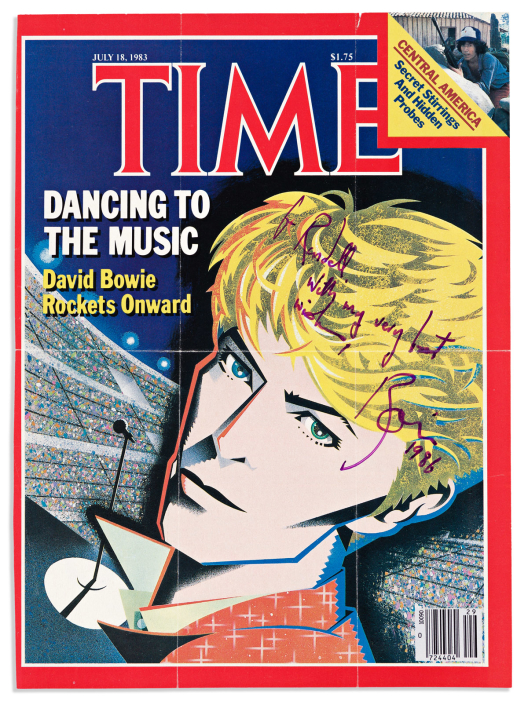

122
Bowie, david.
Time magazine cover Signed and Inscribed, “For Randall / With my very best / wishes / Bowie / 1986,”

Np, 1986
diagonally at middle right. The cover, from the July 18, 1983 issue featuring a bust portrait of him beside the headline, “Dancing to the Music.” 4to; folds, short closed tear at upper edge.



123
Debussy, claude.
Autograph Note Signed, to pianist Ricardo Viñes, in French, in red ink,

[Paris], 18 April 1903 [from postmark]
arranging a meeting to discuss the piano [performance]. ½ page, square 12mo, personal stationery, with integral blank; horizontal fold. With the original envelope, addressed in holograph, with two cancelled 15-centimes “Droits de l’homme” postage stamps.



124
Fitzgerald, ella.
Photograph Signed and Inscribed, “Best / Wishes / Maza / & Thanks / Sincerely / Ella Fitzgerald,”

Np, nd
bust portrait showing her looking obliquely at the inscription. Inscribed diagonally in the image at upper right. 10x8 inches; scattered minor dings and creases, faint scattered soiling.



125
Grieg, edvard.
Autograph Letter Signed, in Danish,

Bergen, 27 December 1884
to an unnamed recipient, mentioning his “Holberg Cantata” [commissioned by the city of Bergen to commemorate the 200th anniversary of Ludvig Holberg’s birth in December of 1884] and Bergen’s Society of Good Works (“Det Nyttige Selskab”). 1 page, 8vo, monogrammed stationery, pale blue paper; horizontal fold, remnants of prior mounting at corners verso.

126
Liszt, franz.
Two items: Autograph Letter Signed * Fragment of Autograph Musical Manuscript, unsigned.

Rome, 19 September 1868; Np, nd
The letter, “F. Liszt,” to pianist Alois Wagdits[?], in German, explaining that the 6 etudes after Paganini were published by Breitkopf and Härtel, declining to send a copy because of the cost of shipping from Rome to Hungary, and sending a photograph [not present]. 1 page, with integral blank; envelope mounted to blank with wax seal intact, brittling and uneven toning overall, chipping at edges with minor loss at upper edge, short closed separations at folds, remnants of prior mounting at scattered points on verso of letter and blank. The manuscript, 13 bars from a working draft of Psalm 129 (“De profundis”; 1880-83), notated on two systems of 3-5 printed staves each, with holograph lyrics and numerous corrections. 5½x6¾ inches; blue pencil cross-out markings overall, vertical fold.



127
Rodrigo, joaquín.
Typed Letter Signed, “Rodrigo[?],” to “Mr. Schenker,” in English, inviting him to visit,

Madrid, 20 November 1983
and sending a photograph together with his discography [not present]. 1 page, oblong 8vo, personal stationery; faint scattered staining, folds.
”. . . I am very pleased to know that you like my Concierto de Aranjuez. “. . . I have many fans in USA, the country I admire so much. “If you come to Spain, I shall be very glad to meet you . . . .” The autographs of Joaquín Ridrigo are uncommon, partly because he lost his sight at a very young age after having contracted diphtheria. With–Typed letter from Rodrigo’s daughter, Cecilia Rodrigo, attesting to the authenticity of the signature on this letter. Madrid, 27 June 2022.

128
Saint-saëns, camille.
Two Autograph Letters Signed, “C. Saint-Saëns,” the second with an Autograph Musical Quotation, to “My dear friend” or “Dear Sir,” in French.

Saint-Germain[-en-Laye?], 25 June 1889; Np, 7 October 1908
The first, praising the way he conducted his own symphony, and complaining of other conductors including the incompleteness of [François] Habeneck and the over-reputed [Narcisse?] Girard. The second, declining to write an article, remarking that he has no genius–rather the skill to reinforce the inventions of others, and adding that some inventions were his own and naming the works in which they appear, discussing his violin concerto in A major. The quotation, 3 bars from his violin concerto in A major, notated on a hand-drawn stave. Together 7 pages, 8vo, first with mourning border, second pale blue paper; first with complete separations at folds repaired with cello tape, faint scattered soiling.
25 June 1889: “There’s only one voice where it concerns your magisterial way of conducting my symphony, bringing it such magnificent animation; everyone spoke to me about it Sunday evening . . . .” 7 October 1908: “. . . ‘This glow that flashes all of a sudden,’ M. Poincaré speaks of it and shows that it is the result of previous . . . work. . . . “. . . I belong to the 2nd category, that of artists who serve to fortify the inventions of others. . . .”

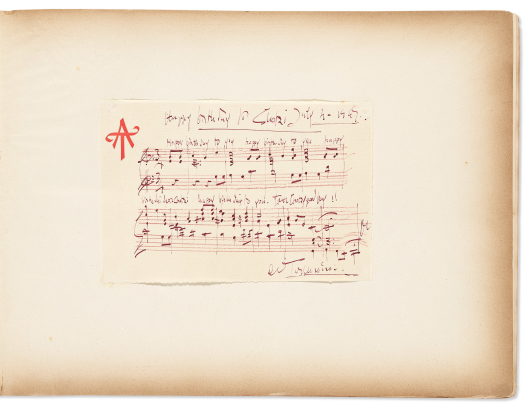

"HAPPY BIRTHDAY"
129
Toscanini, arturo.
Autograph Musical Quotation Signed and Inscribed, “Happy birthday to Chotzi / AToscanini,” a variation of “Happy Birthday” in 11 bars,

Np, 4 July 1949
notated on two hand-ruled two-stave systems, with holograph lyrics, on his monogrammed stationery, mounted at corners to front blank in a large book. The book: Gaetano Donizetti and Salvatore Cammarano. Lucia di Lammermoor, dramma tragico. “313 extra” of 300 copies. Oblong folio, ¼ morocco with cloth over boards, moderately stained and abraded; Istituto di Alta Cultura bookplate pasted to colophon, moderate uneven toning to preliminaries and subsidiaries, scattered dampstaining at lower edge throughout. Milan: E. Bestetti, 1941.
The “Chotzi” in the inscription is likely music critic and pianist Samuel Chotzinoff (1889-1964), who helped persuade Toscanini to become the first music director of the NBC Symphony Orchestra in 1937.



130
Wagner, richard.
Autograph Letter Signed, “Rich. Wagner,” to “My friend,” in French,

Paris, 18 December 1861
declining an invitation, explaining that he has quarantined himself, complaining that his voice has given out, and explaining that he wants to avoid situations in which he must “for the 500th time, make the same explanation, the same complaints.” 1 page, 8vo, with integral blank; closed tears at left touching text (without loss) repaired verso with paper, faint marginal discoloration from prior matting, folds.



THE HANDS OF AMERICAN BANDSTAND: RAY SMITH'S COPY
131
(musicians.)
Dick Clark and Ray Smith. Dick Clark’s American Bandstand. Signed throughout by over 100 musicians, dancers, radio personalities, industry professionals, and others

(New York: Collins Publishers, 1997); inscriptions: [1997-2000]
(most of whom appeared on the show), many additionally inscribed to Ray Smith. Most identified by Smith, in ink. First edition. Unpaginated. 4to, publisher’s cloth, moderate rubbing to edges; few scattered abrasions to dust jacket.
Dick Clark • Donna Summer • Elton John • Don & Phil Everly • Jerry Lee Lewis • Little Richard • Chubby Checker • Aretha Franklin • Tony Bennett • Frankie Avalon • Sting • Bobby Rydell • Diana Ross • Harry Belafonte • Connie Francis • Gladys Knight • Johnny Mathis • Carole King • James Taylor • Barry Manilow • Patti LaBelle • Ricky Martin • Carlos Santana • LL Cool J • Mariah Carey • Eddie Fisher • Judy Collins • Patti Duke • Al Jardine • Mike Love • Bruce Johnston • Rod Stewart • John Mellencamp • Jon Bon Jovi • Gloria Estefan • Cyndi Lauper • Cher • Paul Simon • Nick Rhodes • Simon Le Bon • Warren Cuccurullo • others. A complete list is available upon request.

132
(musicians.) armstrong, louis; and aretha franklin.
Two items, each Signed by one: Typed Letter * Document.

Corona, NY, 2 June 1961; [Los Angeles, 23 December 1971]
Armstrong. TLS, “Louis Armstrong / Satchmo,” to Erich Kauffmann, praising his lip balm, sending a gift [not present], hoping to perform together in Germany, and sending regards. 2 pages, 4to, “Satchmo / in Africa” stationery, written on two sheets; two punch holes in left margin, horizontal folds. Franklin. Partly-printed DS, certifying a California tax withholding report, naming Twentieth Century-Fox Film Corporation as withholding agent. 2 pages, 3½ x 8½ inches; written on recto and verso of single sheet; two punch holes in upper margin with minor loss to printed text.
Armstrong: “I received the lip salve. Thanks very much. I was getting down to just a few tins left. . . . “With your lip salve, Bis Ma Rex [an antacid], and a good laxative, I shall be happy healthy a long long time. They are the rudimentals of life. . . . Don’t ever stop making salve. When and if you should stop making the salve, I shall quit playing the trumpet. . . .” Erich Kauffmann was the son-in-law of German trombonist Franz Schuritz, who developed and marketed a special lip balm for horn players in the 1930s. Armstrong became a devoted customer, and by the mid-1950s, it was sold as “Louis Armstrong Lip-Salve.”



134
Browning, robert.
Autograph Letter Signed, “RBrowning,” to [reviewer Eliot?] Warburton (“Dear Warburton”),

Np, “Easter Day”
sending a copy of his work [not present], and expressing appreciation for his friendship. 1 page, 12mo; ink identification in unknown hand at upper edge recto, small hole at center with minor loss to one character, horizontal folds.
“Here is my last number. If the whole series missed every other success, yet I should consider your friendship (if they were in any degree instrumental in preventing it) an ample reward for the five-years trouble.”

135
Chateaubriand, françois rené de.
Small archive of 6 letters Signed, “Chateaubriand,” and an unsigned note, to the Baron de Vitrolles or the Comte de Sèze, in French,

Vp, 1823-26
including 5 ALsS, a LS, and an AN. The LS, to the Comte de Sèze, ordering him to send decorations to those the King has recently made Knights of the Order of the Holy Spirit and of St. Michel, including Prussian Prince Frederick William IV, Austrian Archduke Franz Karl, and Count von Nesselrode. The other letters and note, to the Baron de Vitrolles, inquiring whether he is the author of the articles that appeared recently in the Drapeau Blanc and Quotidienne, urging him to proceed slowly [concerning the publication of certain articles that are to vindicate the Comte], congratulating him that the order is signed, commenting on his own views toward power, thanking for help with the infirmary of Marie Thérèse, declining to lead the Société des gens de lettres, and, in the unsigned note, requesting notes on the finances and inquiring whether the Prefect of Strasbourg has been removed from office. Together 15 pages, mostly 4to or 8vo, most on folded sheets or with integral blank; some evenly toned, few with scattered ink burn, one with remnants of mounting at corners verso.
20 June 1824: “You will judge me, Sir, at the same time too well and too badly. It is true that I do not at all deplore power, but it is also certain that it is not at all by a feeling of superiority that I recognize myself. . . .”



"IT IS MY WISH. . .THAT. . .MY MORTAL REMAINS SHALL BE COMMITTED TO THE FLAMES"
136
Crane, hart.
Autograph Manuscript Signed, twice (“Hart Crane” in the third person within the text and “Harold Hart Crane”),

Np, nd
informing those who will survive him of his wishes as regards what is to be done with his remains. Additionally signed by witness William Slater Brown. 2 pages, 5x2½ inches, written on the recto and verso of a single sheet, ruled leaf torn from an address book; faint scattered foxing, small tear at upper edge with minor loss, paper clip stain touching first signature.
“I, Hart Crane, under my right mind and full sensibilities, hereby insist and do declare that it is my wish and . . . demand that, upon the occasion of my demise into the hands of our Lord of Eternity and the Great Hereafter, that my mortal remains shall be committed to the flames.”

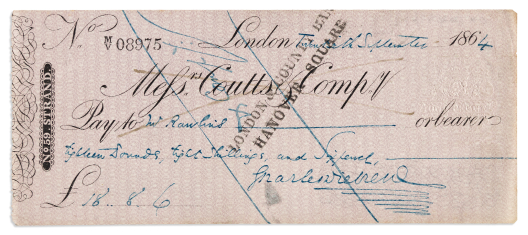

137
Dickens, charles.
Check accomplished and Signed,

London, 20 September 1864
to “Mr Rawlins,” in the amount of £16.8.6 drawn on Coutts & Co. 3¼x7½ inches; ink cancellation marks touching a letter of signature and affecting text, one penny embossed revenue stamp at right edge.

138
Dreiser, theodore.
Three letters, each Signed, to Lewis Alsberg, including two Autograph Letters and a Typed Letter,

Monticello, NY, or New York, 6 August; 7 September 1923; 24 January 1924
concerning his experiences in finance and their relation to The Financier (1912) and The Titan (1914), remarking on the rarity of first editions of Sister Carrie, suggesting that he contact Boni and Liveright for a copy of The Color of a Great City, and thanking for useful information. Each with the original envelope. Together 5 pages, 8vo or oblong 8vo, one on folded sheet, one with integral blank; folds.
6 August1923: “. . . I am not of a financial turn, never have had any practical experience in any commercial field and, in writing the Financier and the Titan, merely gathered data which made the various processes clear to me. I am pleased therefore to find a practical man who looks upon them as accurate. I never had any connection with the Chicago Board of Trade, but as a boy often sat in the Gallery & watched the turmoil below because–from a dramatic or life point of view it was interesting to me. And I’m glad your mother likes The Titan. It is a book I enjoyed writing. I fear you will find it hard to pick up a first edition of Sister Carrie. I have seen it advertised at $100–so you may guess how scarce it is. I have but one copy myself.”

ELIOT NEGOTIATES WITH US ATTORNEY GENERAL TO HELP EZRA POUND
139
Eliot, t.s.
Two Typed Letters Signed, to Richard Davies [friend of imprisoned Ezra Pound].

London, 18 September; 11 October 1956
The first, promising to respond after discussing the situation with [legal advisor to Ezra Pound’s wife] Arthur Valentine Moore. The second, agreeing that his committee should be informed of matters relating to the [U.S.] Attorney General, agreeing that the re-election of Eisenhower would likely indicate a continuation of the same cabinet, and promising to report the result of negotiations with the Attorney General. Each 1 page, square 8vo, “Faber and Faber” stationery, pale yellow paper; pin holes at upper left, folds.
In 1945, Ezra Pound was arrested by U.S. authorities and charged with treason. Most of his 12-year imprisonment was spent at St. Elizabeths psychiatric hospital in Washington, DC, during which time Pound’s case was never brought to trial. In 1956, St. Elizabeths concluded that Pound’s condition made him unfit to stand trial. Friends of Pound, including Archibald MacLeish, Graham Greene, Jean Cocteau, and T.S. Eliot, appealed to the U.S. Attorney General to review the case with an eye toward extraditing him to the U.K., if no trial was forthcoming in the U.S. Pound was discharged in 1958, after a judge’s motion to dismiss the 1945 indictment went unopposed by the Attorney General.



140
Eliot, t.s.
Typed Letter Signed, to M.S. Howard,

London, 6 June 1941
thanking for a specially printed copy of Eliot’s own poem, “Portrait of a Lady.” 1 page, 4to, “Faber & Faber” stationery; folds.
“Thank you for . . . the Number I copy of your private edition of Portrait of a Lady. . . . I can assure you that I am much pleased with it, and congratulate you upon the piece of work that you have done.”

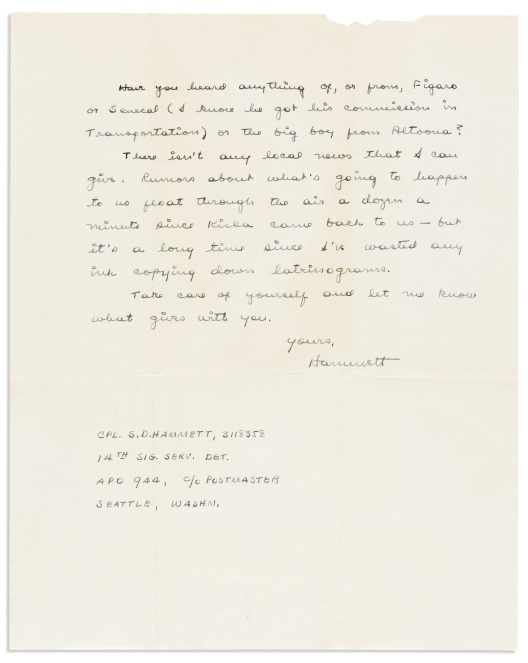

WRITING FROM A PLACE NOT "CONVENIENTLY LOCATED IN RELATION TO WOMEN AND WHISKY"
141
Hammett, dashiell.
Autograph Letter Signed, “Hammett,” to Isadore Gottlieb,

“Alaska” [Cold Bay?], 1 September 1943
conveying news of common friends at Fort Monmouth in NJ, where Hammett was formerly stationed. 1½ pages, 4to, written on two sheets; minor loss to small area at upper edge, folds. With the original envelope.
”. . . I’ve been up here about a month, and so far the going isn’t bad. My present spot isn’t what you’d call conveniently located in relation to women and whisky, but I guess you can’t have everything . . . . But can you drink double hookers of fresh air with a beer chaser? I don’t know, I’ve never tried. “Once in a while I get a spot of news from Monmouth. My bunch seems to have left Sea Girt for Wood again. Treloar is still flubbing the dub and dodging shipment. . . . Monash beat the game and got out of the army with an honorable discharge. He’s now happily–so Florence writes me–doing radio programs for the O[ffice of] W[ar] I[nformation]. . . . “. . . Rumors about what’s going to happen to us float through the air a dozen a minute since Kiska came back to us–but it’s a long time since I’ve wasted any ink copying down latrinograms. . . .”



THE DANGEROUS SUMMER: "LAST SUMMER WAS THE BEST TIME I EVER HAD"
142
Hemingway, ernest.
Letter Signed, “Ernest / His mark EH,” to Bill Davis (“Dear Negro”),

“Finca Vigia” [Havana], 4 January 1960
thanking for sending magazines and papers, remarking that there was no customs trouble for books he sent, remarking that the nonfiction war writing of Paul von Lettow-Vorbeck and Erwin Rommel and other Germans is dull, expecting a visit from his doctor George Saviers who is to examine his wife’s arm, looking forward to releasing the story he had been working on involving bullfighting to critics Kenneth Tynan and Peter Buckley and others [his last major work, The Dangerous Summer, (1985)], requesting newspaper clippings about a bullfight at Dax involving Antonio’s Ordóñez, complaining of difficulty recalling some details, reporting that his biographer A.E. Hotchner has important plans but he has not heard from him recently, wondering about the reception of two of his short stories, and wishing he could be with him as the fish start to bite. Text in the hand of his personal secretary, Valerie Danby-Smith. 3 pages, 4to, personal stationary, onionskin paper, written on three sheets; folds. With the original envelope.
”. . . [W]as happy to have Lettow-Vorbeck. He was a very noble character and can certainly put solid kraut dullness over one of the most brilliant campaigns in history. But Rommel is dull reading too. Very few krauts make good reading. I suppose it is because they tell the truth & keep back anything that should not be shared with outsiders. Also they always write as though they hoped they might have a chance to fight the same campaign over again. “Here the weather has finally turned for the good & we may even have some fishing. George Saviers should be down in a few days, and will be able to give a good look at Mary’s arm. . . . Am running hard in everything except word production. The piece I started at the Consula now over 63,000, reasons why as complicated as charge of late [light?] brigade. Very difficult piece but I hope it will be good. Something in it for everybody including the crows. Am tired of skinning all these dead horses and they can take bullfighting, for the moment, and put it where they found it. After this appendix is finished will relinquish it to Tynan, Buckley and whoever wants it if they can find it. . . . Last summer was the best time I ever had and am only bitching so as not to be rude around the house. . . . “. . . Forgot to thank you for the Burgos clipping. Do you think you could find one on the fight at Dax where the bull stepped on Antonio’s foot? Unfortunately, that is all I remember about that fight except that the bulls had their horns shaved down to the quick. Remember all about Jamie[?] & giving him the smelling salts & about Luis Segura making such a bloody fool of himself. But mostly I recall how La Barata [pet name of his Lancia car?] farted & spat, Nicole & her relatives & the bull stepping on Antonio’s foot. You can see how difficult it is to have only selective recall. From San Sabastian on it gets quite vivid. . . . Hotch [A.E. Hotchner] has all sorts of plans but I have not seen him since before Christmas . . . . Don’t know how the last show the Snows [short story “The Snows of Kilimanjaro”] was received. . . . He is doing The Gambler, the Nun, and the Radio next . . . . Hope he keeps well as a hell of a lot depends on him . . . .”



143
Humboldt, alexander von.
Autograph Letter Signed, “AHumboldt,” to Sanskrit scholar Antoine-Léonard de Chézy, in French,

[Paris?], circa 1800
suggesting that a certain figurine was created with the intention of resembling depictions of Vishnu, listing cognate terms in three languages as proof, requesting more information about the figurine, hoping for a reference in Sanskrit, and sending regards to Mr. Haase. 2 pages, 8vo, with integral address leaf; faint scattered foxing, horizontal fold.
”. . . I believe as you do that traces [outline?] of Vishnu have nothing to do with the ollise figure and that the resemblance is only accidental. However, please cast your eyes on the [entire?] figure and you see that it was made to resemble Vishnu. Besides, I don’t need this proof. Other signs suffice for me: [three columns of terms in “Mexican” (Aztec, Mayan?), Tibetan and Greek showing cognate relationships] . . . . Would you . . . tell me again a few more words about this figure which has an enormous tongue . . . . Perhaps cite some passage in Sanskrit where this idea is expressed. . . .”



144
Kipling, rudyard.
Etched portrait of him by Richard George Mathews, Signed below the image at lower left, in pencil.

Np, nd
Additionally signed by Mathews, at lower right below his printed initials, in pencil. 9x10 inches; faint toning at edges (not affecting signatures).



HELPING A CZECH MUSICOLOGIST TO ESCAPE NAZIS
145
Mann, thomas.
Typed Letter Signed, “To Whom it May Concern,” in English,

Princeton, 3 January 1940
a letter of recommendation for music historian Paul Nettl. 1 page, 4to, personal stationery; folds.
“When visiting Prague in the last years, each time I was strongly impressed by the intensity and high standards of Czech musical culture. . . . I am sure Dr. Paul Nettl, a scholar and musician of outstanding qualities, will greatly strengthen the bonds of a deep and genuine sympathy already existing between this country’s music lovers and the people which produced Dvorak, Smetana and Janacek. Dr. Nettl’s great knowledge of music history as well as his experience in broadcasting technique will enrich our musical life as it did in the old country.” Paul Nettl (1889-1972) was a Jewish, Bohemia-born musicologist who taught at Prague from 1919 until 1939, when he settled in the U.S. to escape the Holocaust. Teaching in Chicago, and later at Indiana University, he wrote works on Jewish minstrels and musicians, the history of dance music, and other European musical topics. His son, Bruno, became an ethnomusicologist.



OF CIVILIZATION AFTER OUTBREAK OF WORLD WAR: "LET US HOPE IT WILL SURVIVE"
146
Mann, thomas.
Typed Letter Signed, to Milton Kronovet, in English,

Princeton, 8 June 1940
thanking for birthday wishes. 1 page, 6x5½ inches, personal stationery; faint discoloration from prior matting, faint scattered staining, horizontal fold.
In full: “How kind of you to think of me at my birthday! In these dark, almost unbearable hours it is a great comfort to know that one has friends who still believe in the fundamentals of western civilization. Let us hope it will survive.” With–Thomas Mann. Photograph Signed, bust portrait clipped from a newspaper. Signed on the mount below the image. 3x2¼ inches (image), 4x2¾ inches overall; uneven toning affecting signature. Np, nd.



147
Maupassant, guy de.
Autograph Letter Signed, to Hortense Howland (“Madame”), in French,

Paris, 10 November 1882 [from postmark]
explaining that he had a prior engagement with Baron de Vaux, but promising to cancel it so the he could accept her charming invitation. 1 page, 8vo, with integral blank; faint even toning overall, vertical fold through signature (without loss). With the original envelope.
“I was invited on Friday to one of my colleagues; but I cannot resist amiable things when they are said in certain charming ways, and I am writing to the Baron de Vaux to free myself. “I must add that the intimate desire of my heart also impels me to this resolution. . . .”



SIGNED BY AUTHOR AND HIS SON
148
Milne, a.a.; and christopher robin.
When We Were Very Young. Signed by both (“A:A: Milne” or “Christopher Robin Milne”), on the title-page.

London: Methuen & Co., (1925); inscription: circa 1925
8vo, publisher’s morocco, markedly worn with cello tape repairs to joints and perished backstrip; cello tape repairs to hinges, text block shaken, first and last gatherings coming loose, faint scattered soiling to signature page, moderate foxing to endpapers. Later edition. Sold as Is.



149
Sand, george.
Autograph Letter Signed, to “Dear friend,” in French,

Np, 28 September 1853
recommending that recipient request the desired seats and day of the performance at Gymnasium [Théâtre du Gymnase], noting that she cannot guarantee seats after the third performance, explaining that the tickets can be picked up at the theater located in the interior office beyond the vestibule, hoping the trip and consultations would restore recipient, suggesting that recipient have some of the jam that is available here, and, in a postscript, suggesting a remedy for toothache. 2½ pages, 12mo, written on a folded sheet; ink identification written on terminal page, folds.

150
Sassoon, siegfried.
Two copies of The Old Century, one first edition in dust jacket, each Signed.

London: Faber and Faber, (1938); inscriptions: Np, [1963?]
The first, signed and additionally inscribed on the half-title: “Inscribed for Carroll L. Priebe.” First edition. The second, signed on the copyright page. Each 8vo, publisher’s cloth, some rubbing to edges; second slightly cocked, owner’s 1963 letter describing circumstances of book acquisition mounted to front free endpaper of second; dust jacket, chipping at fold ends reinforced with cello tape, moderate fading to spine panel, faint scattered soiling.



ORIGINAL DRAFT FROM "THE SOUTH SEAS"
151
Stevenson, robert louis.
Autograph Manuscript, unsigned, 38-line fragment of original draft of South Sea Letters (first published serially in 1891 in the New York Sun and elsewhere, published posthumously as The South Seas).

Np, circa 1890
The fragment, a continuous passage from the end of chapter II in South Seas, including a paragraph discussing the symbolism of Venus in relation to the seasons of death in the Tuamotus Islands which does not appear in the published book. 3 pages, oblong 8vo, written on rectos, each cut from a single folio sheet formed by pasting together two smaller sheets; few scattered short closed tears repaired verso with paper, ink identification written vertically in left margin of two pages, faint scattered soiling.
“Either beach, I have said, abounds with life. . . . “Venus, being the Paumotuan star of Hades and time-keeper of the dead, was perhaps not unnaturally saddled with this responsibility; the light that chases spectres might well be thought to sicken fish. By all accounts besides, the periodicity is, for each island, regular. The difficulty is that it should vary and be even reversed from isle to isle. Touched with a sense of this, Monsieur Wilmot, conseiller-général, an able man–the author, at least, of an able pamphlet on the archipelago–made a number of well considered experiments. Catching wholesome fish on the outside, he had them sunk . . . to different depths and over different bottoms in the lagoon. Over pearl shell, it appears they remained innocuous; but the proximity of certain sorts of coral, above all in the season of its flowering, poisoned them in an exposure of twelve days. . . .”



152
Turgenev, ivan.
Autograph Letter Signed, “Tourguéneff,” to Horace Günzburg, in French,

Paris, 6 January 1881
a letter of introduction for French violinist Paul Viardot. 1 page, 8vo, with integral blank; couple short closed separations at folds, faint band of toning along upper edge.
“Permit me to recommend to your kindness . . . Paul Viardot, a violinist of great talent and great future, who goes to Russia in order to become known to the public. . . .”



153
Twain, mark.
Signature, on a small card.

Np, nd
1½x3 inches; uncommonly good condition.

154
Wodehouse, p.g.
Small archive of 8 items, each Signed, or Signed and Inscribed, to Ray Gibbons: Two Autograph Letters * Three Typed Letters * Autograph Note * Autograph inscription * Color Photograph.

Vp, 1966-68
The letters and note, remarking that he always felt unable to come up with another plot after completing a novel, noting that Wodehouse and [Alexander] Lafone were not at Dulwich College at the same time, critiquing a story submitted by Gibbons, mentioning some London locations in advance of Gibbons’s visit, and sending New Year greetings. Together 7 pages, small 8vo or smaller, personal stationery, two on postcards; moderate staining touching signature on March 17 letter. Each letter with the original envelope. The inscription, “I feel very proud to / think that I was at / the same school as / Lafone,” written on terminal page of printed program for the Lafone Day Parade, held in London on October 30, 1966. 4 pages, 8vo; short closed separations repaired with cello tape. The photograph, additionally inscribed, “To / Ray Gibbons / with best wishes,” half-length snapshot showing him seated while reading and smoking a pipe. Signed and inscribed on verso. 3½x3½ inches; verso stamped in red ink: “Made by Kodak / Feb. 68.”
12 December 1968: “I doubt if this story is commercial. I think what is wrong with it is that there is too much retrospection in it. A short story ought to go ahead from the start, where in this one you have your lead character brooding on the past. . . . “You have to make a story dramatic. You can’t just announce at the end that a lost letter has been discovered, you must have a scene showing it being discovered, because this is the high spot of the story and simply can’t happen off stage.” With–P.G. Wodehouse. Typed questionnaire with holograph responses, unsigned, concerning biographical details, e.g., in reply to question about daily cocktail: “Two martinis before dinner.” 2 pages, 4to, onionskin paper, written on separate sheets. Np, [25 April 1969] • (P.G. Wodehouse.) Two letters from his wife Ethel to Gibbons, sending her husband’s two, evidently heavily-used, wooden and corn cob tobacco pipes and a photograph of her husband [present]. Together 4 pages, 8vo. Remsenburg, 14 February 1968; Np, 10 February 1976.



WRITTEN UPON DEATH OF HACHETTE PUBLISHING HOUSE FOUNDER
155
Zola, émile.
Autograph Letter Signed, to publishing house of Louis Hachette, in French,

Paris, 29 August 1864
sending condolences upon the death of Louis Hachette, and promising to send two works by Erckmann-Chatrian tomorrow. 1½ pages, 8vo, “Librairie de L. Hachette” stationery on pale blue paper, with integral blank; folds.

"LABELS ARE NECESSARY, ON PAIN OF NOT BEING UNDERSTOOD AT ALL"
156
Zola, émile.
Autograph Letter Signed, to an unnamed recipient (lacking salutation), in French,

Médan, 20 May 1882
thanking him for the kind words, and defending his own use of the word “naturalism” [likely suggesting that his literary characters and events are determined by natural, as opposed to supernatural, causes]. 1¼ pages, 8vo, written on a folded sheet; folds.
“First, a thousand thank yous, my dear colleague, for the too kind things you say to me. But I assure you that I have never had the pretention of inventing anything. And if the word ‘naturalism’ is not good, too bad! It’s not mine. I got it from Montaigne, from Taine, from Russian authors, and from a crowd of other ancestors. Besides, you are completely right, there are no schools, there are only men, when posterity has made its triage. Until then, unfortunately, groups exist, and labels are necessary, on pain of not being understood at all.”



157
(writers–german–austrian.)
Small archive of 10 letters to aphorist Hans Margolius or his father Adolf, each Signed by a philosopher or writer, in German,

Vp, 1925-73
mostly concerning his aphorisms. Together 18 pages, 4to or smaller; generally good condition, separations at folds of Förster-Nietzsche letter repaired recto with cello tape.
Elisabeth Förster-Nietzsche. LS, “Dr. phil. h. c. Elisabeth Förster-Nietzsche,” thanking for his letter and book. Weimar, 17 August 1925 • Richard Beer-Hofmann. TLS, admiring the ethical strain in his book and anticipating future works. New York, 23 February 1944 • Ernst Cassirer. ALS, remarking that he read his book with sympathy, recommending his own new book, An Essay on Man. New York, 3 December 1944 • Eduard Spranger (2). TLS, thanking for his New Year commemoration and expressing special interest in his essay “System und Aphorismus”; ALS, on a postcard, thanking for his defense of ethical aphorisms and suggesting another way of viewing ethical phenomena. Tübingen, 20 January; 2 October 1961 • Clemens Weber. TLS, thanking for the gift of the aphorism book, thanking for publishing his own aphorisms, listing the numbers corresponding to particular aphorisms that he appreciates, and noting a similarity to aphorisms by [Rudolf] Pannwitz. Heinsberg, 16 August 1962 • Hugo Marcus (4). ALsS, thanking for publishing his own aphorisms, remarking on his aphorisms and those of others. Basel, 1962-64 • Ernst R. Hauschka. TLS, expressing happiness that he enjoyed his essay on writing. Regensburg, 1973.

158
(writers.)
Group of 4 items Signed, or Signed and Inscribed, by 19th-century writers.

Vp, vd
Format and condition vary.
Ralph Waldo Emerson. Check accomplished and Signed, “RWaldoEmerson,” to bearer in the amount of $37.94 drawing on the Atlantic National Bank. With 2-cent revenue stamp at left edge. 2¾x7¼ inches; cancellation hole at center (without loss to text), folds. Boston, 27 June 1874 • John Greenleaf Whittier. Clipped Signature (“JohnGWhittier”), on a slip of paper. 1¾x3 inches, quad ruled paper. Np, nd • Horatio Alger. ALS, “H. Alger, Jr.,” to Fred A. Larkin, sending an additional autograph [not present] and announcing the release in May of his new book Mark the Match Boy. 1 page, small 8vo, ruled paper. New York, 12 March 1869 • Julia Abigail Fletcher Carney (2). ALS, “Julia A. Carney,” to Rev. J.R. Bailey, sending her poem, “Little Things”; AMS, “Julia A. Fletcher / Now Mrs. Carney,” the complete poem in four stanzas, written on letter’s conjugate leaf. Together 2 pages, small 8vo. Galesburg, 7 March 1892.
Artists

"I'VE OUTLIVED THE 'MOVEMENTS', THE CRITICS, THE ARTY ART EXPERTS"
159
Benton, thomas hart.
Group of 17 items Signed, or Inscribed and Signed, “Thomas H. Benton” or “Tom” or “T,” to collector Hyman Cohen, in ink or pencil: small archive of 10 Autograph Letters * 7 magazines or books.

Vp, 1931-64
The letters, reporting progress made in his paintings and in building a new house and in preparing for June [mural for 1933 Chicago World’s Fair], reacting to critics of his mural, planning for murals at [MO] State Capitol building, complaining about the “museum business,” and stating that popular opinion finally seems to support the views expressed in his paintings. Together 18 pages, 4to or 8vo, few on personal or hotel stationery; one chipped at lower edge with minor loss. Each with the original envelope. The magazines and books, most “To Hyman Cohen,” inscribed on front cover or page near front. Folio or smaller; generally good condition.
Letters: 20 August [1931]: “. . . I am doing little work at present in painting, most of my labor is going into my place, digging and building. I’ve done two watercolors and I have all the drawings of the early summer, but I am holding my energies for the winter.” [26 March 1933]: “. . . I have to work by exact schedule–so much done each day in order to open the 1st of June in Chicago–every minute counts. So far I have done more extensive work than New School & Whitney Museum put together–and under this pressure I believe I am doing my best work. . . . We fought a little over the inclusion of the Ku Klux Klan and the bank failures but they gave in and now even the governor backs me up. “We are in a revolution, Hymie. Something is happening to this country, psychologically. It is my good fortune to be the one probably who will change . . . officially sanctioned art. No state, heretofore would ever have had the nerve to hire an artist and let him paint the actual fact–the evil as well as the good. “We will see what comes of it. Whether or not it wrecks my backers politically.” 25 May 1933: “. . . I have had my way all through this work and it is far superior to any that I have done before. . . . “It is certain to get a lot of publicity after the first hurrah of the Fair’s opening is over. For once a State exhibit is something other than a farce and that must automatically draw intelligent attention. “I am probably in for more berating from our critical friends, what I do is a little too much for their delicate sensibilities, but that won’t make any difference if the American people should wake up and realize that for once they have been fairly and accurately portrayed. . . . “I believe it possible that these bad years have taken the blinders off a good deal of intelligence that was pulling the red band wagon just through pure inertia. I have a hope that maybe I’ll get somewhere yet. We’ll see. . . .” 29 August 1933: “. . . What I can judge of reports in the Times give me the feeling that Art is at a pretty low ebb right now. “I have been a little discouraged by the poor publicity my Indiana mural received. This was my best job and yet I rarely see anything about it. . . .” 31 December 1935: “. . . I am still working on the plans of my murals for the State Capitol but expect to get at the walls within six or eight more weeks. . . . “I do not miss all the quarreling and bickering of the New York Art world. In fact it is grand to work in peace. . . .” 17 October 1941: “. . . You understand that my language in New York was figurative–but don’t fool yourself and say that it didn’t contain a lot of truth. This whole museum business is rotten and I’m not yet through with it. Read my article in the June issue of ‘Common Sense’ . . . .” 23 April 1964: “. . . I’ve outlived the ‘movements’, the critics, the arty art experts, . . . the bright boys and the holy boys and girls–the social content children with the Commie bias, I mean. It looks like I’ve got America behind me–and that’s more, by far, than I ever expected.–and, certainly, enough for me . . . .” Magazines and books: Creative Art: A Magazine of Fine and Applied Art. December, 1928 • Exhibition catalogue for The Theatre in Art held at Sidney Ross Gallery beginning March 30, 1932. [New York : Sidney Ross Gallery], (1932) • Two copies: David Laurance Chambers and Benton. Indiana: A Hoosier History. [Indianapolis]: (Bobbs-Merrill, 1933) • TIME. December 24, 1934 • Benton. Thomas Hart Benton: A Descriptive Catalogue. New York, Associated American Artists, 1939 • Benton. The Year of Peril. [Chicago: Abbot Laboratories], (1942). With–Small group of related ephemera, including three retained drafts of letters from Cohen to Benton or the University of Kansas concerning art generally or the loan of Benton’s painting Burlesque to the University’s Museum of Art (1951-58); two typed letters from the University to Cohen concerning the same loan (1957-58); an incomplete loan form for the same (1958); and a few newspaper clippings (1935-62).



YOUNG PAINTER INSPIRED BY THE OUTDOORS
160
Delacroix, eugène.
Autograph Letter Signed, to his friend and future executor Achille Piron, in French,

“Maison des Gardes” [Mansle], 16 September 1819
recounting the passion stirred in him by recent hunting experiences, touching on his appreciation for music and literature and languages, congratulating him for having committed to learn Italian, discussing his own translations from Dante’s works, promising to send a package and asking that he write a long letter in reply. 3 pages, 4to, written on a folded sheet, with address leaf on terminal page; inkburn from large “X” drawn on address panel and also from few scattered words and strikethrough lines causing loss to portions of several words, marked bleedthrough overall, minor loss from seal tear.
”. . . I wait patiently. I listen to the voice of the dogs . . . . That . . . warlike something . . . that awakens the imagination: but after a long wait, . . . the rifle, an inconvenient and useless piece of furniture, slips very gently from my hands . . . . The movement of the branches charms me . . . the clouds roll in front of me, I raise my head to follow them while I am thinking of some madrigal, when a slight noise . . . wakes me slowly from my dream. . . . Every day I complain about my carelessness and every day I see . . . hares. I really pity the poor dogs who are regularly tethered all the time they are not hunting . . . . “. . . I brought with me several songs from Dante, which . . . I had copied from an Italian edition . . . . When you are sufficiently advanced to hear this sublime poet, you will bless the hour when the idea occurred to you to study his language. What vigor, what imagination, what sweetness and what tender sadness . . . .”



161
Delacroix, eugène.
Autograph Letter Signed, “Eug Delacroix,” to lithographer Pierre Joseph Challamel (“Monsieur Challamel”), in French,

Np, 23 March no year
requesting that he inform him of who is to do the job of draughtsman in creating a lithograph of his own painting. 1 page, 8vo, with integral address leaf; folds.
“Having no information to provide you in making a lithograph from my painting, it would be essential that the draftsman who is to be in charge of it has a strong connection with the painting. I would be obliged if you would let me know who you charge with this job. It could happen that I find that someone with great talent is nevertheless unsuitable in the circumstances.”



INSCRIBED TO US AMBASSADOR TO IRELAND, R.W. SCOTT MCLEOD
162
Disney, walt.
Large Photograph Signed and Inscribed, “To the McLeod Family / with my best,”

Np, circa 1960
showing Disney in conversation with a leprechaun from his film, Darby O’Gill and the Little People (1959). Inscribed in the image, lower center. 14x11 inches; few scattered dings, remnants of hinging at upper edge verso.



DISUSSING HIS YOUTH IN BERLIN AND THE REBUILDING OF GERMANY
163
Feininger, lyonel.
Illustrated Autograph Letter Signed, “the Feiningers,” to Ulfert Wilke (“my dear Ulfert”), with ink and watercolor drawing, unsigned.

Plymouth, 16 September 1951
The drawing, showing four geometric figures outlined by shimmering lines forming spaces colored in with blue and orange, at upper left of first page. 4x4 inches. The letter, thanking for birthday wishes, expressing relief on hearing of the way Germany is rebuilding after the War, remarking that he would dread returning to a once-familiar Berlin to find it changed, complaining that the Nazis had changed the names of some of the places familiar to him, stating that Wilke’s experience in Italy would be important for his artistic development, promising to write his wife, and looking forward to meeting in New York. 2 pages, 4to, written on recto and verso of a single sheet; folds.
”. . . I enjoyed your description of your impressions during your stay in Germany, and it even relieved me to find you had found so much which seemed to be of good portent, in the re-building of devastation-ruined cities; especially that there was re-awakened interest in beautifying places, even amongst the wrecked streets & places [squares?]. “It must be one of the strangest experiences imaginable, to return to a city and find every familiar street and place so utterly changed. I should dread the experience, in Berlin W., where for so many years I lived, of finding only demolished houses. . . . [I]n my dreams I especially love to roam along the streets in the vicinity of the Lützow Platz; the Maassen Strasse and Nollendorf Platz–the Nazis changed the names already in the mid-thirties! I have the treasure of remembering all these places as they were when I wandered happily about them in my youth. Nothing should ever destroy this. . . . “Yes, I can feel for you when you say you are like an exile, away from your dear wife & boy Christopher; but your present stay in Italy will have the greatest importance for your future development in your art. . . .”



164
Gauguin, paul.
Autograph Letter Signed, to his dealer Ambroise Vollard (“Dear Mr. Vollard”), in French,

Np, [1903?]
acknowledging receipt of money, asking whether he received his paintings or ceramic, and wondering what is the status of the Japanese paper and canvas and Noa Noa book [his travelogue first published in 1901]. 1 page, oblong 8vo, ruled paper; folds.

165
Miró, joan.
Two items, each Signed “Miró”: Autograph Letter * Photograph.

Palma de Mallorca, 11 November 1964; Np, nd
The letter, to journalist Varian Fry (“Dear Sir”), in French, giving travel plans, agreeing to meet with him, and mentioning that André Masson is in Paris and therefore not in Aix-en-Provence. 1 page, 4to, personal stationery, onionskin paper; remnants of hinging at upper edge verso, horizontal folds. The photograph, half-length portrait by Varian Fry, showing him writing. Signed in the image at upper left, in red ink. 9½x7 inches; few scattered dings, photographer’s ink stamp on verso.



OFFERING PAINTINGS "LIKE THOSE THAT I'M DOING FOR MY CHILDREN"
166
Moses, grandma.
Autograph Letter Signed, to her dealer Louis J. Caldor (“Dear Mr. Caldor”), in pencil,

Eagle Bridge, 18 October no year
offering to create two large paintings on board before the end of November, and also to frame and ship them to him. 1½ pages, 8vo, ruled paper, written on two sheets; horizontal folds.
“[W]as tired the night that you were here and could not think fast. “But have been thinking sence [sic] if you or Dr Kallir realy [sic] wants some more of my paintings for a exibit [sic], I could paint two or three large ones like those that I’m doing for my children by the last of November. “If those would swite [suit?] I would do them on hard board and fram[e] them and ship them to you. “So sorry that you and your friends had to come in the rain. [T]rust that you got home in good shape.”

167
Renoir, pierre auguste.
Archive of 6 Autograph Letters Signed, “Renoir,” to art dealer Ambroise Vollard, in French,

Vp, 1903-16
mentioning the abandonment of public exhibition in favor of private sales, inviting him to visit, complaining of illness and the miserable cold, hoping that the reappearance of the sun would be healing, expressing exasperation at having no news from him, complaining of a problem with a local notary, promising to write [Paul?] Durand-Ruel, and reporting having completed work for the portrait of Madame de Galia[?]. Together 7 pages, 8vo or smaller, two on postcards, three on ruled or quad ruled paper; generally good condition, 1911 letter with closed tear touching signature (without loss). Two with the original envelope.



168
Rodin, auguste.
Autograph Note Signed, “Rodin,” to an unnamed recipient (lacking salutation), in French,

Np, nd
promising him a terracotta, explaining that the small one is already in place, requesting that nothing be said about Rodin, remarking that he must wait until the show because the moment is not yet right, and sending regards to his wife. 1 page, 12mo; minor scattered smudging to text, horizontal fold.



169
Rosa, salvator.
Autograph Letter Signed, “SR,” to poet Giovan Battista Ricciardi, in Italian,

Np, 15 December 1657
complaining of having been robbed of 200 scudi of gold and, in a postscript, hoping he has settled a debt to a woman. 1 page, 4to; moderate ink burn from crossed out line of text with minor loss to signature, minor loss from seal tear at upper right, right edge reinforced verso.



ILLUSTRATOR FOR "WINNIE-THE-POOH" AND "THE WIND IN THE WILLOWS"
170
Shepherd, ernest howard.
Ink drawing, unsigned, sketched self-portrait showing him reclining under a tree beside Mr. Toad.

Np, nd
Additionally inscribed with two captions: “Here is me doing / sketches for ‘Wind in the / Willows.’ Please / note my large feet,” and “Mr Toad.” 7x5¼ inches; mounted to a larger board along upper edge verso, horizontal fold.

INCLUDES LETTER SEEKING WORKS FOR VENICE BIENNALE FROM MATISSE, CÉZANNE, SEURAT
171
Signac, paul.
Group of 4 Autograph Letters Signed, in full or “P. Signac,” to “My dear friend” or “Sir” or “Dear Madam” or “Dear Sir,” in French,

Paris, 1891-1920
inquiring about obtaining two books, thanking for his work of art criticism and how he has helped advance the Society of Independent Artists, soliciting French artworks for the 12th Venice Biennale, and looking forward to collaborating with the factory craftsmen but wondering why one would limit them to making copies. Together 8 pages, 4to or 12mo, two written on recto and verso of correspondence cards, most on personal or Société des Artistes Indépendants stationery; generally good condition.
5 June 1891: “Why am I deprived of your two books–would I have deserved your friendship or your literary esteem? And as I shake your hand, my dear [Edmond?] Dujardin.” 5 June 1903: “I am very touched by your benevolent appreciation of my work in the far-sighted critical study on the Salons that you have just published. “I thank you wholeheartedly as well for having so courageously opened the doors of the Gazette des Beaux-Arts to the Society of Independent Artists . . . .” 5 February 1920: “The Council of the 12th International Art Exhibition in Venice asked me to represent it in Paris and to bring together the works which . . . find a place in the pavilion dedicated to French art from April 15 to October 15. “We have sent invitations to Bonnard, Guérin, Luce, Maillol, Marquet, Matisse, Roussel, Signac, Vuillard, and we are counting on works by Cezanne, Cross, Gauguin, Redon, Seurat. . . .”



"YOU SAY YOU HAD CEASED TO EXIST. I FREQUENTLY FEEL THAT"
172
Stieglitz, alfred.
Autograph Letter Signed, “Stieglitz,” to the wife of Horace Rand Lamb (“Dear B[eatrice] L[amb],”

“The Place” [New York], 25 December 1937
with a 1½-page postscript additionally signed “S,” thanking for sending letters, commenting on her desire to make photographs, mentioning how influential was Agnes E. Meyer, sending Christmas greetings and, in the postscript, remarking on the depth of Mrs. Lamb’s feelings and how they are sometimes similar to his own. 3½ pages, 4to, written on two sheets; horizontal folds. With the original envelope.
”. . . All the letters mean much to me. The one in which you say: ‘I always thought I wanted to write or photograph–find some way of saying what is in me. But now I don’t know. Right after seeing you, it feels as though I have no need to do any such thing . . . . [I]t feels as though knowing you, you were as much as one lifetime could hold.’ How well I understand, sense, your feeling. I’m sure that that sorry feeling will generate in you a greater need than ever to write & photograph–to create the equivalent in form [to] that which is the essence called You. . . . I will tell you about Agnes Meyer. I can realize what an influence she must have been in your young life. For 6 or 7 years she & I were very close friends. . . .” The postscript: “You wrote: ‘You stood by the doorway & talked to me. I heard every word you said, but I didn’t hear any words. For suddenly I saw the thing behind your words. I saw the essence of you, the highly personal . . . you. I was completely destroyed. . . . I was not there. I was not anywhere. I had ceased to exist.’ “You will write . . . for anyone feeling as deeply as you do must finally collapse or write. . . . “You say you had ceased to exist. I frequently feel that in reality–I don’t actually exist. . . .”



173
Vuillard, édouard.
Autograph Letter Signed, “EVuillard,” to “Sir,” in French,

[Paris], “Saturday”
agreeing to a proposed exchange for a painting located in Vuillard’s studio. 1 page, small 8vo, with integral blank; folds.
19th & 20th Century Literature

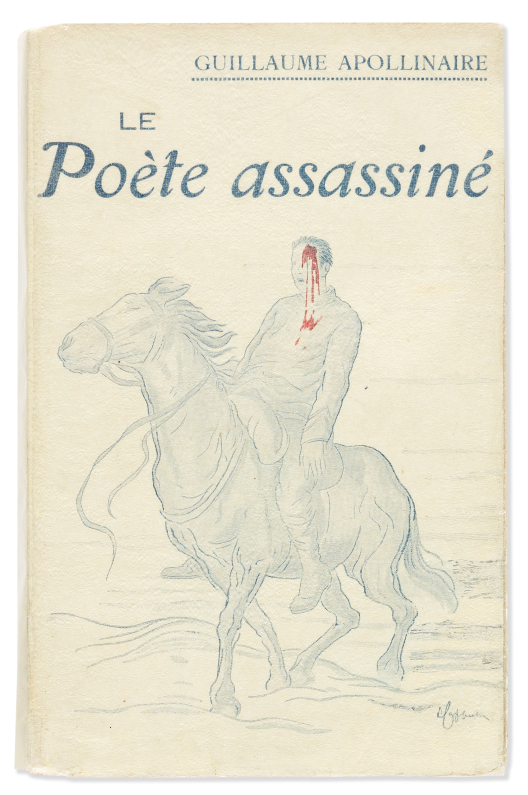

174
Apollinaire, guillaume.
Le Poète Assassinè.

Paris: Bibliotheque des Curieux, 1916
Portrait of Apollinaire by Andre Rouveyre. 8vo, publisher’s pictorial wrappers, front cover with illustration by Cappiello; glassine overwrap; spine partly cracked; front hinge repaired; custom cloth clamshell box. First edition, with unsigned two line inscription by Apollinaire.



175
Arellano, jesus.
El canto del gallo. Poelectrones.

(Mexico City): Metáfora, 1972
4to, publisher’s tan wrappers printed in red and black, mild toning with a few minor smudges. First edition. Scarce book of visual poetry, composed on an IBM photo-typesetting machine with pages in facsimile.



176
Babcock, dwight v.
A Homicide for Hannah.

New York: Alfred A. Knopf, 1941
8vo, publisher’s orange cloth stamped in blue; price-clipped dust jacket, spine panel with minor rubbing to folds and head and foot, small nicks to fold corners, short closed tears; endpapers toned. First edition. The second appearance of the character Hanna Van Doren, considered the first female hard-boiled detective in American literature. The English edition appeared as Murder for Hannah published the same year. Hubin, p. 39.



177
(bayntun binding / extra-illustrated.) rae, w. fraser.
Sheridan. A Biography.

London: Richard Bentley & Son, 1896
2 volumes. 8vo, later full crushed blue morocco by Bayntun, covers with gilt geometrical design within single gilt rules, spines tooled and lettered in gilt in compartments, all edges and wide turn-ins gilt. Extra-illustrated with 43 additional plates, 12 of which are hand-colored. Finely bound; includes portraits, views, and facsimile letters.



178
Beckett, samuel. gorey, edward.
All Strange Away.

New York: Gotham Book Mart, (1976)
Illustrated by Edward Gorey. Design and typography by Ronald Gordon at The Oliphant Press. Tall thin 8vo, publisher’s ¼ gilt-lettered leather over boards decorated by Gorey; publisher’s slipcase. Number 186 of 200 copies signed by Beckett and Gorey. Fine, with virtually no evidence of handling. Toledano B61b.



179
Beckett, samuel.
Group of 5 works.

Vp, vd
Comprising: Our Exagmination round his Factification for Incamination of Work in Progress.</i> 8vo, publisher’s cream printed wrappers, tanned, heaviest to spine, front wrap partly separated with small chips at edges; ownership signature, “Made in Great Britain” stamped beneath imprint. First trade edition. Paris: Shakespeare and Company, 1929 * Murphy.</i> 8vo, publisher’s cloth; dust jacket, spine panel tanned with one tape repair to verso at head; publisher’s inkstamp on copyright. First American edition, originally published in London in 1938. NY: Grove Press, (1957) * Watt.</i> 8vo, publisher’s green cloth, black title labels to front cover and spine; dust jacket; ownership signature to front flyleaf. First cloth-bound trade edition. Paris: The Olympia Press, (1958) * Molloy; Malone Dies; The Unnamable: A Trilogy.</i> 8vo, publisher’s printed wrappers, slight lean, soft crease and tiny tear to front wrap. First edition thus. Paris: the Olympia Press, (1959) * Compagnie.</i> 8vo, publisher’s printed wrappers. First trade edition, precedes Beckett’s English translation. Paris: Les Editions de Minuit, (1980). (5)



180
Beckett, samuel.
Stirrings Still.

New York: Blue Moon Books, 1988
Original duotone lithographed print of Beckett and 8 lithographed drawings in black, by Louis le Brocquy, printed by Pierre Chave at his Atelier in Vence, France. Folio, original ¼ parchment-backed linen stamped in gold along spine and cover; linen slipcase. Number 190 of 200 copies signed by Beckett and Le Brocquy. Beckett’s final work of fiction, written for friend Barney Rosset, his long-time American publisher at Grove Press. Crisp, unread copy.



181
Beckett, samuel.
The North.

London: Enitharmon Press, 1972
Title page printed in grey and black. 3 signed etchings by Avigdor Arikha. Folio, contents loose as issued in blindstamped wrappers; publisher’s linen chemise and slipcase (scattered spotting per usual). Printed at the Rampant Lions Press. Number 90 of 137 copies signed by Beckett.



182
(binding - french.)
La Sainte Messe.

Paris: Bouasse Lebel & fils & Massin,1892
Preliminary with hand-colored arms of alliance under a crown of marquis. Text within illuminated borders richly handcolored and heightened with gold in medieval style. 12mo, bound in full tan calf decorated in black and gilt by Bouasse-Lebel & Massin, religious scene hand-painted on front cover, all edges gilt and turn ins gilt, silk doublures. Printed missal of 50 pages colored by hand. Fine.



183
(binding - french.)
Livre d’heures ou Missel Illustré.

Dijon, Pellion & Marchet, c. 1880s
Illustrated in black and white throughout. 12mo, bound in full plum polished morocco, spine titles gilt in compartments, all edges gilt, chiseled silver metal plate mounted to front cover; gilt turn ins, watered silk endpapers. Supplied hinged box with metal fastener.



184
Black sun press. crosby, harry.
Shadows of the Sun (First and Second Series).

Paris, 1928-29
2 volumes bound in 1. Printed in red and black. Tall 8vo, contemporary ½ straight-grain brown morocco and marbled boards, spine titles gilt, light rubbing to extremities, scuff to rear board; original printed wrappers to each volume bound in. First editions of two of the three separately published volumes of Harry Crosby’s diaries, each one of 44 copies. Minkoff A11.

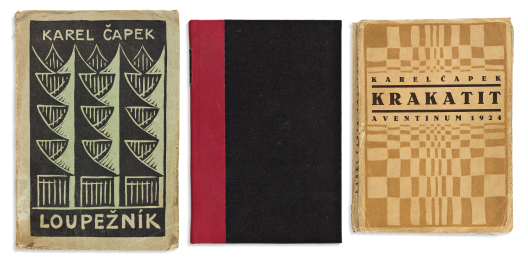

185
Capek, karel.
Group of 3 Prague First editions.

Praha: Aventinum, 1920; 1922; 1924
Comprising: Loupeznik.</i> Illustrations by Josef Capek. 8vo, original pictorial green wrappers printed in black, toning to spine and wrapper edges, small nicks and short closed tears at head and foot of spine, minor soiling; ownership signature to front flyleaf, first signature and further pages neatly detached, contents clean. * Vec Makropulos. [The Makropulos Affair].</i> 8vo, modern ¼ red calf-backed boards, cloth spine label. Capek’s play was first performed in Prague in 1922. Leoš Janácek adapted the play into an opera of the same name shortly thereafter. * Krakatit.</i> Title printed in red and black. 8vo, original printed wrappers with design by Joseph Capek, toned, spine leaning, joints rubbed. (3)



186
Capek, karel.
Krakatit.

Praha: Aventinum, 1924
8vo, modern ½ brown leather over marbled boards, morocco lettering piece in spine compartment; errata leaf at end. First edition, signed by Capek in black ink on the half-title. “[A] rich and wildly imagined work, unusual in its almost orgiastic baroque exploration of power, sexuality, and guilt” (Bleiler, Science-Fiction 360).



187
Capek, karel.
Válka S Mloky. [War With the Newts] * Bílá Nemoc. [The White Disease].

Prague, 1936; 1937
First title: 8vo, publisher’s grey cloth stamped in red and black, some light rubbing to head and foot of spine, few faint stains on rear cover; contents unmarked. First edition. Capek’s last novel, published in English in 1937 as War With the Newts. Scarce. Praha: Nakladatel Fr. Borovy, 1936 * Second title: Small 8vo, publisher’s blue/grey cloth stamped in maroon and black, faint rubbing to spine tips and fore-edge of front board. First edition of Capek’s play translated as “The White Disease.” Signed by the author in black ink on prelim. Its immediate success led to seven editions being published within a year; this the true first. (Praha: Fr. Borovy, 1937). (2)



188
(children’s literature.) carroll, lewis.
Alice’s Adventures in Wonderland.

London: Macmillan and Co., 1891
42 illustrations by John Tenniel. Half-title, frontispiece. 8vo, contemporary full red crushed morocco by Riviere & Son, triple gilt fillet borders, spine tooled in gilt in compartments, all edges gilt, joints repaired, front cover detached (with attached flyleaf); inner dentelles, scattered minor foxing to front and end matter, 4-pages advertisements (top edges trimmed with loss of letters to “Specimen Page”), original red cloth bound in at end. Signed presentation copy, inscribed: “Eda Alison Seys, from the Author. June 26, 1897.” Later printing, Eighty-Fifth Thousand. Provenance: Anderson Galleries, 29 March 1932.

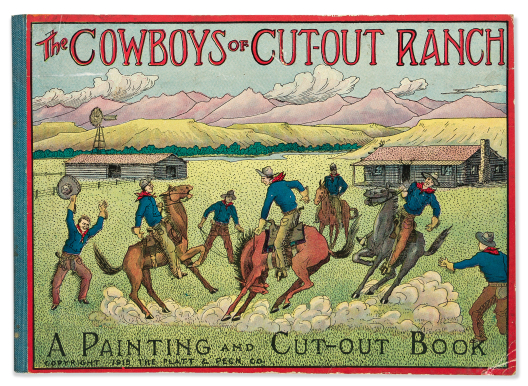

189
(children’s literature.) el camancho [phillips, walter shelley.]
The Cowboys of Cut-Out Ranch.

New York: The Platt & Peck Co., 1915
A Book About Cowboys, with Pictures to Paint and Cut Out.</i> Illustrated with 13 double plates, the colored version facing the uncolored version for coloring in and cutting out. Oblong 4to, publisher’s ¼ cloth-backed illustrated paper-covered stiff boards, slight bow, few minor scrapes; rear hinge stabilized, pages browned, most of the uncolored plates with at least partial hand-coloring but none have been cut out. First edition. A nice survival.

190
(children’s literature.)
Group of 5 First editions.

Vp, vd
4to and 8vo, publisher’s cloth; dust jackets (excepting first title); condition notes below. Comprising: SMITH, E. BOYD. Santa Claus and All About Him.</i> Illustrations (including 19 in colors) and story by Smith. Board edges rubbed with some exposure; front hinge strenghtened, plates quite clean. NY, [1908] * SMITH, E. BOYD. After They Came Out of the Ark.</i> 22 color plates and story by Smith. Extremities rubbed with some exposure; dust jacket with chipping to fold corners and spine panel tips, short tears; contents clean. NY, 1918 * FLACK, MARJORIE. Ask Mr. Bear.</i> Cloth with light finger soiling, slightly shaken; jacket front flap with corners clipped, folds creased and toned; news clipping mounted to copyright page. Presentation copy, inscribed by Flack to her parents: “For my Mother and Father / in whose footsteps / I am trying to follow / in writing and drawing / Marjorie Flack / Christmas 1932.” NY, 1932 * BROWN, MARGARET WISE. The Noisy Book.</i> Illustrations by L. Weisgard. Light rubbing to spine tips and corners; two tape repairs on verso of jacket, uneven toning, light edgewear. NY, 1939 * BURTON, VIRGINIA LEE. Maybelle the Cable Car.</i> Price-clipped jacket with closed tears and small chips, tape remnant on front and rear flaps. [Boston], 1954. (5)



191
(children’s literature.) jansson, tove.
The Happy Moomins.

Indianapolis: Bobbs-Merrill Company, (1952)
Illustrated by the author including frontispiece map on blue paper. 8vo, publisher’s full blue cloth gilt, light tap to bottom of front boards, few very light spots to board edges; unclipped dust jacket, few marks near printed price, some mottling, heaviest to front panel, small nicks, light rubbing to folds; few pages with marginal stains. First American edition. Scarce in the jacket. No other copies traced on Rare Book Hub or ABPC.



192
(children’s literature.) walt disney studios.
The Adventures of Mickey Mouse. Book I.

Philadelphia: David McKay, (1931)
Color illustrations throughout. Thin 8vo, publisher’s pictorial paper-covered boards, spine tips and bottom and top of board edges rubbed; dust jacket, spine tattered, surviving in four fragments split along folds (front panel, rear panel, front and rear flaps); colored pictorial endpapers, front joint partly split, inked and pencil annotations in child’s hand on blank preliminary. First edition. Considered the first Mickey Mouse book appearance, this also marks Donald Duck’s first appearance in print. Book debut for the most famous cartoon character ever created.



193
Conrad, joseph.
Lord Jim.

New York: Doubleday & McClure Co., 1900
8vo, publisher’s green decorated cloth, spine slightly sunned, few light stains; ownership signature (“Józef Kliszczewski” on half-title verso), later ex-collection Stanley J. Seeger with his bookplate; custom ¼ morocco folding box. First American edition, first printing, second state, presentation copy inscribed by the author to Mr and Mrs Józef Spiridion (“To / Mr and Mrs / J. Spiridion / from their friend / the Author / Nov. 1900.”) on front free endpaper. Cagle A5b(2).



194
Davenport, guy.
Wo Es War, Soll Ich Werden.

Champaign, IL: Finial Press, 2004
8vo, publisher’s turquoise cloth over boards; acetate dust jacket; with Circumspectus (sewn pamplet) and Cadenza (folded leaflet) laid in loose, as issued. Deluxe edition, number 43 of 100 copies signed by the author on Frankfurt paper. Scarce; fully subscribed before publication. Fine.

195
Dickens, charles.
A Christmas Carol.

London: Chapman & Hall, 1843
Hand-colored etched frontispiece and three plates by John Leech, four wood engravings in the text by W.J. Linton after Leech. Half-title printed in blue, title-page printed in red and blue, verso printed in blue, 2 page publisher’s advertisement at end, green coated endpapers. 8vo, original vertically-ribbed brown cloth, all edges gilt, spine and front cover gilt-stamped, touch of fraying to head and foot of spine, one small ink blot at top of rear board; dampstain at front confined to front pastedown and endpaper, signature stressed between pp. 80-81, some occasional narrow tidemarks to blank margins, ownership signature to title, Kimbolton Castle shelf label to front pastedown; slipcased. A handsome copy of the first edition, first issue with “Stave I” as the first chapter heading, and balance of text uncorrected. With Todd’s first binding state (the closest interval between blind decorative border on the left and the left extremity of the gilt cartouche measuring 14-15 mm and the “D” of Dickens unbroken). “Dickens’ changes of mind [regarding the production] led to a period in December of 1843 when there were on hand at the printers and the binders different endpapers, title-pages, half-titles and text pages already printed, though not yet cased–a situation that led to copies going out with mixed features” (Lee Biondi, Firsts, September 1997, p. 30). Eckel pp.110-115; Smith II:4.



196
Dickens, charles.
A Christmas Carol.

London: Chapman & Hall, 1843
Hand-colored etched frontispiece and three plates by John Leech, four wood engravings in the text by W.J. Linton after Leech. Half-title printed in blue, title-page printed in red and blue, verso printed in blue, 2 page publisher's advertisement at end, yellow coated endpapers. 8vo, original vertically-ribbed brown cloth, all edges gilt, spine and front cover gilt-stamped, mottling to spine and covers, rear board also with a few small stains, slight lean; plate facing p. 78 ("Scrooge's third Visitor") with small puncture to upper blank margin, small booklabel to rear pastedown; slipcased. Second edition with "Stave One" as the first chapter heading, and balance of text uncorrected.



197
Dickens, charles.
A Christmas Carol.

London: Chapman & Hall, 1844
Hand-colored etched frontispiece and three plates by John Leech, four wood engravings in the text by W.J. Linton after Leech. Half-title printed in blue, title-page printed in red and blue, verso printed in blue, 2 page publisher’s advertisement at end, yellow coated endpapers. 8vo, original vertically-ribbed brown cloth, all edges gilt, spine and front cover gilt-stamped, head and foot of spine slightly frayed, few pale stains to rear board; ownership signature to front free endpaper and contents leaf, mild foxing, chiefly to front and end matter; slipcased. Fourth edition.



198
Dickens, charles.
A Tale of Two Cities.

London: Chapman & Hall, 1859
8 parts in 7. Etched frontispiece, additional title and 14 plates by Hablot K. Browne. 8vo, original blue-green pictorial wrappers, some rebacked or with repairs to spines; ex-collection Donald Drapkin with his bookplate; custom ¼ morocco folding case. First edition in original monthly parts, first issue of parts 7/8 with page 213 numbered “113”, preceded by the weekly publication in All the Year Round. “Tale of Two Cities Advertiser” present in each part (lacking pp. 1-2 in part VI, and pp. 1-4 in part VII) and other inserted advertisements (lacking that of the Cornhill Magazine in part 7/8), including Dr. de Jongh’s Cod Liver Oil ad and Morison’s Medicines ad both present in part VII (not called for in Hatton & Cleaver). Hatton & Cleaver, pp. 331-42; Eckel, pp. 86-90.



199
[dickens, charles.] onwhyn, t.
The Pickwick Papers. India Proofs. Printed from the thirty-two Original Steel Plates.

London: George Allen, [1897]
11½ x 9 inches, sheets. Comprising letterpress title with woodcut device, index, 32 engraved plates including ornamental title, each on mounted India paper, tissue guards, browning to letterpress title, light spotting to some extremities, loose as issued in original paper sleeve (torn with loss) and burgundy cloth portfolio lettered in gilt. With facsimile edition.

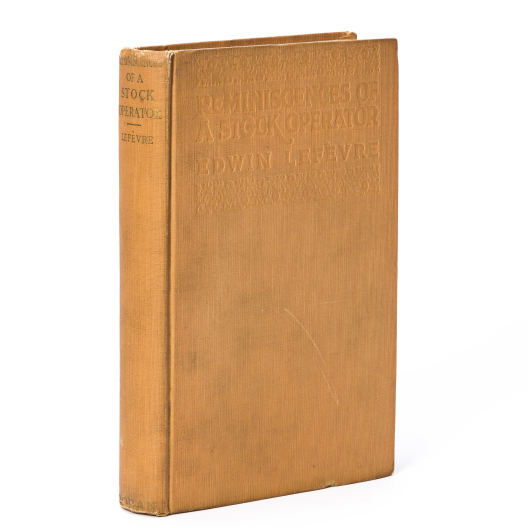

200
(economics.) lefèvre, edwin.
Reminiscences of a Stock Operator.

New York: George H. Doran, (1923)
8vo, original tan cloth, spine gilt-lettered, blind-stamped front cover, minor finger soiling, spine tips pushed, corners bumped; front hinge partly cracked, effaced ownership inscription on front flyleaf, tiny ink spot to fore-edge. First edition. Meets the following first printing points: tan/light brown cloth (as opposed to green), blind stamped front cover, George H. Doran logo/emblem and the roman numeral “I” on the copyright page. The classic fictionalized biography of the great Boston and New York stock trader Jesse Livermore.



201
Eliot, george.
Romola.

London: Smith, Elder, & Co., 1880
Illustrated by Sir Frederick Leighton. 3 volumes. Folio, uniformly bound in modern full black crushed morocco blocked in gilt, top edges and turn-ins gilt; housed in matching silk-lined folding cases with snap fasteners (one defective; corners rubbed, few splits). Extra-illustrated by Frances E. Taft with numerous portraits, views, engravings, watercolors, manuscript letters; each page including text leaves mounted to larger page. The 2-volume Leighton edition expanded to 3. Number 125 of 1000 copies.



202
Eliot, t.s.
Dante.

London: Faber & Faber, (1929)
8vo, publisher’s blue cloth, spine gilt-lettered, top edges gilt, front board slightly bowed, spine faded, thin dampstain with ink bleed to bottom of rear board with a few associated spots to rear pastedown and a few leaves at bottom blank margins. Number 52 of 125 copies signed by Eliot. Number 2 from the series, “The Poets on the Poets.”



203
Eliot, t.s.
The Waste Land.

New York: Boni & Liveright, 1922
8vo, publisher’s stiff black gilt-lettered cloth, spine faded with light rubbing to head and foot; lacking dust jacket; contents clean and unmarked. Limited edition, number 908 of 1000 copies of the “second edition” (i.e., First Edition, Second Impression), retaining the misspelling of “mount in” on page 41, and colophon number 2mm high. Gallup A6b.



204
Eluard, paul.
Le Devoir et l’inquiétude, poèmes, suivis de le Rire d’un autre.

Paris: A. J. Gonon, 1917
Frontispiece engraving by André Deslignères. 12mo, publisher’s gilt-lettered marbled wrappers; glassine overwrap with light edgewear. Limited edition, one of 200 copies, signed by the publisher, on d’Arches. Unopened copy.



205
Fariña, richard.
Been Down So Long It Looks Like Up to Me.

New York: Random House, (1966)
8vo, publisher’s ¼ green cloth and blue paper-covered boards, very slightly skewed, scattered minor soiling; unclipped dust jacket, several old cellotape mends on top and bottom edges of verso repairing short closed tears and small nicks, moderate dust soiling and edge creasing; endpapers toned with some spotting. First edition, inscribed by the author: “G – Recognize any of these events. We had fun. Dick.” According to Rare Book Hub, the first signed or inscribed copy to appear at auction. It is surmised that the dedicatee is Richard Gillespie who was at Cornell University the same time as Fariña and Thomas Pynchon. The three shared the same residence in Ithaca and would have crossed paths frequently; Farina was known to have signed letters to his friends as “Dick.” (For Richard Gillespie see: https://thomaspynchon.com/playing-bridge-with-thomas-pynchon/). The fact that the inscription is in red correction pencil suggests it was likely accomplished prior to his book signing at the Thunderbird book store in Carmel, California (the few copies he signed there were done in ink) whereafter, later that same day, 30 April 1966, two days after the novel’s publication, he tragically died in a motorcycle accident. A 1960s American counter-culture desideratum.



206
Faulkner, william.
A Fable.

(New York): Random House, (1954)
8vo, publisher’s pictorial blue cloth stamped in gold, white, and blue over beveled boards; top edges stained blue; original glassine jacket, spine panel tattered; publisher’s slipcase, soiled but intact; custom clamshell box. Number 83 of 1000 copies signed by Faulkner. Petersen A31b.



207
Fitzgerald, f. scott.
Tender is the Night.

New York: Charles Scribner’s Sons, 1934
Illustrated by Edward Shenton. 8vo, publisher’s dark green cloth, slight lean, extremities worn with exposure, spine tips frayed with crude tape mends, front joint split, spine gilt dulled with tears; news clippings cellotaped to front flyleaf and following blank, TLS by Alexander Clark of Princeton laid-in. First edition, later printing, with a presentation inscription by Fitzgerald on irregulalry clipped plain sheet cellotaped to front pastedown reading: “For Holger [Lundbergh] / from his [?] / devotedly / Scott Fitzgerald.” While the extent of their relationship isn’t clear, Fitzgerald and Lundbergh did enjoy a correspondence, however brief (the laid in 1-page TLS on Princeton University Library stationery signed by Mr. Clark the Manuscripts Curator, dated 19 March, 1969, confirms Lundbergh’s gift of 3 Fitzgerald holograph letters to him to be added to Princeton’s Fitzgerald holdings). A letter from Fitzgerald to Maxwell Perkins (circa 1 March, 1929) includes a favorable mention of Lundbergh: “Will you watch for some stories from a young Holger Lundberg who has appeared in The Mercury? He is a man of some promise and I headed him your way” (Turnbull, ed., The Letters of F. Scott Fitzgerald, NY, 1963, p. 214).



208
Fitzgerald, f. scott.
The Great Gatsby.

New York: Scribner’s, 1925
8vo, publisher’s dark green cloth, minimal spine lean, front cover blind-stamped, spine gilt-lettered, few minor blemishes to front cover; faint spotting or offsetting chiefly to endpapers. First edition, first printing with uncorrected text, meeting all points. Bruccoli A11.1.a; Connolly, The Modern Movement 48.

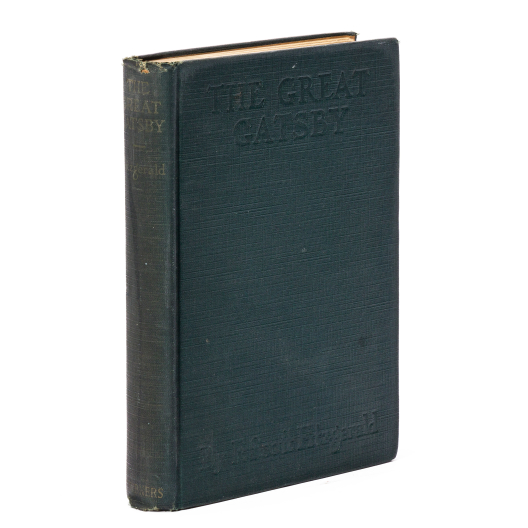

209
Fitzgerald, f. scott.
The Great Gatsby.

New York: Charles Scribner’s Sons, 1925
8vo, publisher’s dark green cloth, spine tips frayed, front cover blind-stamped, spine gilt dulled; rear free endpaper lacking with associated tear to pastedown with loss, ex-collection Holger Lundbergh (see lot 207) with his inscription dated 1927 on front free endpaper. First edition, first printing with uncorrected text, meeting all points. Bruccoli A11.1.a; Connolly, The Modern Movement 48.



210
Gray, oscar.
The Bagshot Mystery.

New York: The Macaulay Company, (1929)
8vo, publisher’s orange cloth lettered in dark red, light rubbing to head and foot of spine; dust jacket with three corners narrowly clipped retaining $2.00 price, panels rubbed with some small abrasions to rear panel, folds rubbed, few small nicks to fold corners, dust soiling; contents clean. First American edition, clean and square copy in scarce and unrestored jacket. Elusive “mystery novel centering about that curious sect called ‘The Thugs’ […].” Though Hubin lists both the English and American first editions as 1928 issues, the small handful located in WorldCat that bear the Macaulay imprint are dated 1929 as here. Hubin, p. 345.



211
H.d. [hilda doolittle].
The Usual Star.

London: Privately printed, 1928
8vo, publisher’s printed wrappers; unopened. “Printed by Imprimerie Darantiere at Dijon France M. CM. XXXIV.” One of 100 unnumbered copies. Near fine copy.



212
[halliday, brett.] baker, asa.
Mum’s the Word for Murder.

New York: Frederick A. Stokes Company, 1938
8vo, publisher’s black-stamped green cloth, light rubbing to spine tips, some superficial scratches on rear cover; unclipped dust jacket, stabilized on verso with thin (5mm) tape mends running length of top and bottom edges, spine panel with green ink faded and shallow chips at head, serrated chipping along top half of both flaps (touching price) with associated abrading on verso, corner nicks, few short closed tears; contents clean and unmarked. First edition of the first mystery by Halliday, exceedingly scarce with no other copies traced at auction according to ABPC or Rare Book Hub. Hubin, p. 42.



213
Hemingway, ernest.
The Old Man and the Sea.

New York: Charles Scribner’s Sons, 1952
8vo, publisher’s blue cloth, mild rubbing to extremities; first state dust jacket, corners clipped retaining $2.00 price, soft creasing to folds; contents clean and unmarked. First edition, first issue, a superb copy in bright, unfaded and unrestored jacket. With ‘A’ and publisher’s seal on verso of title-page, and no mention of the Pulitzer Prize he was awarded the following year. Hanneman A24a.



214
(illuminated manuscript / sangorski & sutcliffe.)
Of Gardens, An Essay.

London, nd [c. 1910]
By Francis Bacon. Illuminated and bound by Sangorski & Sutcliffe in gold and colors, 21 pages on vellum, includes frontispiece/title with a large miniature detailed in gold, first sheet with a large missal border in gilt and colors and final sheet with small initial and border. 8vo, bound in full green crushed morocco, all edges gilt, sun-dial central device tooled in gilt on the front cover within roses inlaid in red levant and gold tooled leaves in the corners, spine gilt in compartments (light wear to head and foot of spine and top of rear joint); wide gilt turn ins, silk endpapers, leather bookplate; cloth slipcase. Superb manuscript finely bound.



215
(illuminated manuscript facsimile.)
Nouvelles Heures Gothiques d’apres les Manuscrits des Bibliotheques Nationales et Particulieres.

Paris: Leroy, Secail & Cie., [c. 1880s]
Numerous full-page illustrations; each text page within different historiated or floral border; entirely printed in chromolightography and gold with richly decorated borders. 12mo, bound in full brown morocco gilt extra, spine tooled in gilt in compartments, all edges gilt; patterned front endpaper cut with loss. Fine example of French color printing of the period. A gift for the wedding of Adrienne Rendon, that includes a laid in handwritten certificate of confession dated June 16, 1895. Confession heard at the convent of the Barnabite Fathers, rue Legendre in Paris.



216
Joyce, james.
Haveth Childers Everywhere. Fragment from Work in Progress.

Paris/New York: Henry Babou and Jack Kahane/The Fountain Press, 1930
Title printed in green and black. Tall 4to, letterpress stiff wrappers; glassine jacket, spine tanned with small chip at foot, else fully intact; original green paper-covered board slipcase, one panel lacking and one cracked with corners chipped. Limited edition, number 132 of 500 copies on “handmade pure linen Vidalon Royal” from a total edition of 685.



217
(kelliegram binding.) goldsmith, oliver.
The Vicar of Wakefield.

London & New York: MacMillian & Co., 1890
Illustrated by Hugh Thomson. 12mo, bound in full brown morocco gilt extra by Kelliegram with central inlaid morocco design on front cover reproducing plate on p. 25, spine gilt in compartments, all edges gilt, turn-ins gilt; catalogue clipping tipped at front, ex-collection Eugene Field with his signature dated 1893, thence to his son Eugene Field II inscribed by him and dated 1931 on rear endpaper. First issue with suppressed plate on p. 95.



218
Kipling, rudyard.
Collected Verse of Rudyard Kipling.

New York: Doubleday, Page & Co., 1910
With 17 illustrations (9 in colors and tipped to mounts) by William Heath Robinson. 4to, bound in ½ red morocco and marbled boards by Starr Bookworks, spine tooled and lettered in gilt in compartments, top edges gilt, others uncut; offsetting to pp. 112-113. Limited edition, number 108 of 125 copies signed by Kipling. Fine.



219
Leroux, gaston.
Le Fantôme de l’Opéra.

Paris: Pierre Lafitte et Cie., [1910]
Half-title. Small 8vo, contemporary ¼ pebbled green cloth and marbled boards, spine label gilt; contents slightly browned as usual, age-toning to front and end matter; original wrappers bound in. First book edition, retaining the fragile wrappers. Preceded only by a popular tabloid edition. The source material for numerous films, as well as the enormously successful stage production.



220
Lewis, wyndham.
One-Way Song.

London: Faber and Faber Limited, (1933)
Title border and part-title vignettes after Lewis. 8vo, publisher’s full yapp-edged vellum, gilt-lettered, top edges gilt, faint stain to rear cover. First edition, number 17 of 40 copies signed by the author. Satirical verse divided into five sections: ‘Engine Fight-Talk’; ‘The Song of the Militant Romance’; ‘If So the Man You Are’; ‘One-Way Song’; and ‘Envoi’. Morrow and Lafourcade A21a.



221
Lewis, wyndham.
The Ideal Giant. The Code of a Herdsman. Cantelman’s Spring-Mate.

London: Privately printed for the London Office of the Little Review, [1917]
8vo (215 x 140 mm), publisher’s printed stapled self-wrappers string-tied into original cloth-backed pictorial board folder, cover illustration after design by Lewis, boards with dust soiling, chipped corners, and scattered staining; staples rusted. First edition of Lewis’s first separate literary book, (preceded by Timon of Athens, a portfolio of illustrations). Printed in an edition of approximately 200 copies, though Pound and Grover speculate that perhaps only 50 copies of the folder were produced but that more copies of the pamphlet were printed. Rare; according to Rare Book Hub, the first copy at auction in nearly two decades. Morrow and Lafourcade A2; Pound and Grover A1.



222
Magill, marcus [pseud. joanna giles and brian hill].
Who Shall Hang?

Philadelphia: J.B. Lippincott Company, 1929
8vo, publisher’s black cloth lettered in red; dust jacket with corners narrowly clipped retaining $2.00 price, closed tears along bottom half of front and rear flap folds, few other nicks and short closed tears; contents clean and unmarked. First edition in unrestored jacket. Hubin, p. 543.



223
[marx, karl.] marx, carlos.
El Capital. Resumido y acompanado de un estudio sobre el socialismo científico por Gabriel Deville.

Madrid: Ricardo Fé, 1887
Half-title (mounted on stub); 3-page index at end. Small 8vo (6½ x 4¼ inches; 170 x 110 mm), later ¼ morocco and marbled boards, spine ruled and lettered in gilt; pages age-toned, no markings. A work of the utmost scarcity, the first Spanish edition of this translation, with no other examples appearing at auction according to Rare Book Hub. This is the most important abridged version of Marx’s Capital ever to have appeared. Superior to the edition, also published in Madrid, by Dionisio de los Ríos with a translation by Zafrilla, bearing an 1886 publication date, which is generally considered to be the first Spanish translation of Das Kapital, and deemed an inferior (also abridged) version from Roy’s French version. OCLC locates four copies (British Library, Bibliothèque Nationale, and two in the United States). This Spanish translation was made from the French of Gabriel Deville (1854 -1940), the French socialist theoretician, politician and diplomat, who did more than almost anyone else to raise awareness of Karl Marx’s theories of the weaknesses of capitalism, most effectively through the present work, which came to have a profound influence upon the spreading of Marxist thought throughout the Spanish speaking world. “The epitome, here translated, was published in Paris, in 1883, by Gabriel Deville, possibly the most brilliant writer among the French Marxians. It is the most successful attempt yet made to popularize Marx’s scientific economics” (Robert Reeves La Monte, Introductory Note to the 1899 English translation). The Spanish translator of the work is Antonio Atienza, a typographer and translator at the press of Ricardo Fé, who in 1886 volunteered his work at the newly founded “El Socialista,” the Spanish flagship publication of Marxist socialism. It was also in 1886 that Atienza translated the present work, with the publication following in 1887. This translation happened almost simultaneously with the problematic translation by Zafrilla, which appeared in weekly installments in the rival newspaper “La Républica.”



224
Melville, herman.
Mardi: and a Voyage Thither.

New York: Harper & Brothers, 1849
2 volumes. 8vo, publisher’s purple cloth, covers blocked in blind, spines gilt-lettered, joints dried with a few small nicks, spine fade extending into front and rear covers; front free endpapers excised, ex-collection Henry McBride with his booklabel to yellow-coated pastedown, light to moderate foxing throughout. First American edition of Melville’s third novel. BAL 13658; Sadleir, Excursions 225.



225
Melville, herman.
Moby-Dick; or, the Whale.

New York: Harper & Brothers, 1851
12mo, original purple/brown cloth, blind-stamped with heavy rule frame and publisher’s circular device at center of each cover, spine slightly faded with minor fraying to head and foot, corners bumped, small abrasion to bottom of rear board; orange endpapers with minor discoloration, rear hinge tender, intermittent, mostly moderate foxing, 6-pages of publisher’s advertisements at end; custom ¼ morocco slipcase and cloth chemise. First American edition, first state binding, containing thirty-five passages and the Epilogue omitted from the English edition (published a month earlier). Melville himself famously described his book thus: “It is the horrible texture of a fabric that should be woven of ships’ cables and hawsers. A Polar wind blows through it, and birds of prey hover over it.” “[Melville’s] great book, Moby Dick, was a complete practical failure, misunderstood by the critics and ignored by the public; and in 1853 the Harpers’ fire destroyed the plates of all of his books and most of the copies remaining in stock (only about sixty copies survived the fire) … Melville’s permanent fame must always rest on the great prose epic of Moby Dick, a book that has no equal in American literature for variety and splendor of style and for depth of feeling” (Dictionary of American Biography XII, pp. 522-526). BAL 13664; Sadleir, Excursions 229; Grolier, American 60; Johnson, High Spots 57.



226
Melville, herman.
Omoo: A Narrative of Adventure in the South Seas.

New York: Harper & Brothers, 1847
Frontispiece map, half-title printed in red, title printed in black and red, “Round Robin” illustration on p. 104, 25 pp. advertisements at end. 8vo, publisher’s blind- and gilt-stamped brown cloth, cocked, short splits and shallow chips to spine tips and top of rear joint, rear board with scattered discoloration; ex-collection Kenneth Rapoport with his bookplate on front pastedown, ownership signatures in pencil. First American edition. BAL 13655. [With:]</i> Another copy. 8vo, publisher’s blind- and gilt-stamped cloth, spine faded; Rapoport bookplate, earlier ownership signature, inked numerals on title, additional bookplate, 8-pp. adverts at end. Fifth edition. NY, 1847. BAL 13656. (2)



227
Melville, herman.
Pierre; or, the Ambiguities.

New York: Harper & Brothers, 1852
8vo, original slate blind-stamped cloth, uneven browning, soiling to rear board, gilt-lettered on spine (darkened), splits along joints and spine tips; Henry McBride booklabel, usual spotting to front and end matter. First edition.The follow-up to Moby-Dick. The notorious opprobrium of the critics towards Melville’s later novels likely reached their zenith as regards the reception of Pierre, with the objections such that his sanity was called into question. Today, the work is considered perhaps “the best psychological novel that had yet been written in English” (Higgins and Parker, p. 196). A large portion of the first edition of Pierre was destroyed in the 1853 fire at Harper & Brothers. BAL 13666.



228
Melville, herman.
The Piazza Tales.

New York: Dix & Edwards, 1856
7-page publisher’s advertisements at rear. 8vo, original brown blind-stamped cloth, spine with gilt lettering and decoration, light wear to spine tips and corners, dent to top of rear board; front hinge partly cracked, front pastedown with Henry McBride booklabel and catalog clipping, last two text leaves with upper outer blank corners torn. First edition, including the first book appearance of several of Melville’s best-known short stories, including “Bartleby, the Scrivener,” “Benito Cereno,” and “The Enchantadas” (all previously published in Putnam’s Monthly Magazine). BAL 13669.



229
Milton, john.
Paradise Lost. A Poem in Twelve Books.

London: Tho. Hodgkin, for Jacob Tonson, 1695
320 x 195 mm. [A]4, B2, c-Z4, Aa-Yy4. Engraved portrait frontispiece of Milton bound opposite the title, additional 12 full-page engravings. Folio, bound in full modern calf in the style of contemporary speckled calfskin, spine gilt in compartments with morocco lettering piece; contents with a few minor old paper repairs, ownership signature. Sixth edition. Wing M2151.



230
(modern first editions.)
Group of 8 works of literature.

Vp, vd
8vo, publisher’s cloth, dust jackets (one facsimile); condition notes below. Comprising: BIERCE, AMBROSE. The Shadow on the Dial and other Essays.</i> Three tape repairs on jacket verso. First edition. San Francisco, 1909 * FAULKNER, WILLIAM. As I Lay Dying.</i> Spine toned; facsimile jacket. First edition, corrected issue, with p. 11 properly aligned. NY, 1930 * COBB, HUMPHREY. Paths of Glory.</i> Jacket spine panel faded. First edition. NY, 1935 * BOULLE, PIERRE. The Bridge on the River Kwai.</i> Ownership inscription; jacket with dampstains, short closed tears, portion excised from bottom of front flap. First English translation. London, 1954 * HELLER, JOSEPH. Catch-22.</i> Spine and board edges toned; jacket soiled, closed tears, chipped including loss of top 1½ inches of spine panel; front hinge split. First edition with first printing indication. NY, 1961 * SHEPARD, SAM. Five Plays.</i> Jacket with light dust soiling, small dampstain. First edition. Indianapolis, 1967 * HELLER, JOSEPH. Something Happened.</i> Few creases to jacket. First edition, Signed by the author. NY, 1974 * RUSHDIE, SALMAN. Midnight’s Children.</i> Top edges of jacket with small nicks and closed tears; upper corner of front free endpaper neatly excised. First American edition. NY, 1981. (8)



231
Moore, clement c.
A Visit from St. Nicholas.

New York: Henry M. Onderdonk, 1848
Frontispiece, 5 full-page woodcuts, initial, borders, and vignette at end by T. C. Boyd. 8vo, publisher’s wrappers printed in red and blue, supplied later thin card overwrap, lightly browned, few insignificant stains/spots, old ownership inscription dated 1854 on first leaf. Exceedingly well-preserved rare first fully-illustrated book-length edition of “‘Twas the Night Before Christmas.” Marshall in her definitive bibliography of the poem cites only two known copies. According to Rare Book Hub, this is just the second copy of this imprint to appear at auction (Swann, 2 Feb 2006, sale 2065, lot 174, $4,600). Marshall, The Night Before Christmas 32.



232
(mystery / crime fiction.)
Group of 3 First editions.

Vp, vd
Comprising: CHARTERIS, LESLIE. Enter the Saint.</i> 8vo, publisher’s yellow cloth, scattered soiling, spine tips and joints frayed slightly; lacking the rare dust jacket; ownership inscription; buckram drop-back case. London, (1930) * THORNDIKE, RUSSELL. Dr. Syn Returns.</i> 8vo, publisher’s gilt-lettered black cloth; first issue unclipped dust jacket priced at 7/6, spine panel darkened with shallow chips to extremities, light surface soiling; cloth drop-back case. Signed and inscribed by the author, with an 8-line signed presentation inscription including quote from “Dr. Syn’s Song” (“Oh - Here’s to the feet wot have walked the plank!! Yo - ho for the Dead Man’s Throttle!”) to unknown recipient dated 18 March 1939. London, 1935 * HILLERMAN, TONY. The Fly on the Wall.</i> 8vo, publisher’s blue cloth lettered in indigo and white, top corners lightly bumped; first issue dust jacket, spine panel lightly faded with minor rubbing to head and foot; cloth drop back case. Signed by the author, with a lengthy inscription dated in the year of publication, referencing a perceived inaccuracy in the book as an apology to “…fellow fly fishermen” for “the misuse of Cotton’s fishing pole in Chapter Fourteen.” New York, (1971). (3)



233
(mystery and detective fiction.)
Group of 8 Queens Quorum/Haycraft Queen Cornerstones.

Vp, vd
8vo, various bindings, notes including condition below. Comprising: GODWIN, WILLIAM. Adventures of Caleb Williams.</i> 2 volumes bound in 1. Later ¾ morocco and marbled boards, spine gilt in compartments, top edges gilt, boards scuffed; front pastedown with abrasion and War Service Library bookplate. Harper’s Stereotype Edition. NY, 1831 * COLLINS, WILKIE. The Woman in White.</i> Modern blue cloth; contents with few tape mends, Florence & Edward Kaye leather bookplate. First appearance in print, serialized in All the Year Round</i> (Vol. II, October 29, 1859-April 7, 1860; Vol. III, April 14-October 6, 1860; bound in 1). London, 1860 * ALLEN, GRANT. An African Millionaire: Episodes in the Life of the Illustrious Colonel Clay.</i> Original decorated green cloth, top edges gilt, light rubbing to extremities. First edition. London, 1897 * DOYLE, ARTHUR CONAN. The Hound of the Baskervilles.</i> Original maroon cloth gilt, minor rubbing to extremities, corners slightly exposed; ownership inscription, prelims foxed, 8 pp. adverts at end. First American edition, third state, in Tabard Inn Library binding. Green and Gibson A26c.ii. NY, 1902 * BENTLEY, E.C. Trent’s Last Case.</i> Original gilt-lettered blue cloth, light wear to spine tips. First edition. London, [1913] * MAUGHAM, W. SOMERSET. Ashenden.</i> Original blue cloth lettered in gilt and black, slight lean, light soiling to front cover; abrasion to front pastedown. First edition. London, 1928 * VICKERS, ROY. The Department of Dead Ends.</i> Original red cloth, spine gilt; unclipped dust jacket, spine panel sunned with small chips at head not touching letters, corners nicked, folds rubbed; abrasion to front pastedown. First English and hardcover edition. London, 1949 * BLOCHMAN, LAWRENCE G. Diagnosis: Homicide. The Casebook of Dr. Coffee.</i> Thin line of dampstaining along fore-edge of front board; faint tidemark to upper outer corner of first 12 pages; jacket rubbed along folds and spine panel ends, light dust soiling. Philadelphia, 1950. (8)



234
Nicholson, meredith.
A Reversible Santa Claus.

Boston and New York: Houghton Mifflin Company, 1917
Illustrations by Florence H. Minard including color frontispiece (tissue guard present). 8vo, publisher’s light blue decorated cloth; crisp and clean original dust jacket with “$1.00 net” printed price on spine panel, corners narrowly clipped, two small closed corner tears; contents clean and unmarked. First edition, fine copy in a near fine jacket; rare as such and certainly amongst the best obtainable copy. Hubin, p. 601.

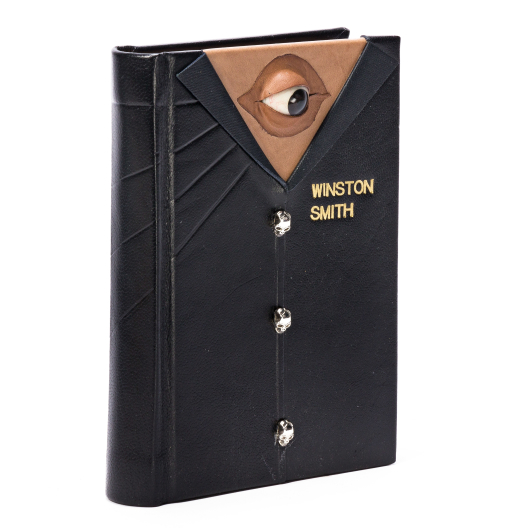

235
Orwell, george.
Nineteen Eighty-Four.

London: Secker & Warburg, 1949
8vo, bound in modern full black leather by Exeter Bookbinders, styled as man’s jacket, raised metal skeletons as buttons, within the folded lapels is a genuine onlayed prosthetic or “fake” eye with tan calf eyelids, front and rear covers gilt-lettered, blind rules; pastedowns and free endpapers with patterned collage of the author’s eyes, with two secret panels on the front pastedown concealing a Ten Shilling Bank Note of England displaying HM Queen Elizabeth’s II’s face and a one dollar bill displaying George Washington; binder’s gilt leather label mounted to rear pastedown also beneath secret panel designating this as “The Black Edition 5 of 5.” The bindery also produced 100 numbered copies in various other colored bindings. First edition, and one of the 5 special copies done in black leather by Exeter Bookbinders.



236
Rand, ayn.
Atlas Shrugged.

New York: Random House, (1957)
8vo, bound in green morocco, top edges gilt, spines tooled and lettered in gilt in compartments. First edition, with “First Printing” indication on the copyright.



237
Rand, ayn.
Atlas Shrugged.

New York: Random House, 1957
8vo, publisher’s full blue cloth gilt; mylar dust jacket; hinges starting; card slipcase (extremities rubbed with small nicks, toned). Number 1406 of 2000 copies. Ninth Printing. Special Tenth Anniversary Edition, signed by Rand.



238
Roth, henry.
Call It Sleep.

New York: Robert O. Ballou, (1934)
8vo, publisher’s dark red cloth, gilt-lettered blue cloth spine label, cocked, black top-stain, corners lightly bumped, scattered minor abrasions; unclipped dust jacket, numerous tape mends on verso repairing closed tears including length of two folds, portions of top and bottom edges and across spine panel, several hard fold creases, extremities and flap folds rubbed with mild abrading, small nicks; front hinge starting, slight separation at gutter of title page, few signatures stressed, endpapers toned, contents with occasional staining, mostly to blank margins. First edition in first state jacket, inscribed by Roth to his sister on the half-title: “For my dear sister, Rose / Henry Roth.” Variant binding in red cloth (all others located in the blue cloth), possible trial binding, in slightly oversized (by 5mm) jacket. According to Rare Book Hub, just the third inscribed copy to appear at auction, all sold in these rooms (14 June 2001, lot 256, $18,000, Ben Sackheim copy; 18 May 2016, lot 339, $12,500, Lawrence Fox copy).



239
Roth, henry.
Two Inscribed titles.

Vp, vd
Comprises: Call It Sleep.</i> Mass-market paperback, pictorial wrappers, light edgewear with a few creases. First paperback edition, signed and inscribed by Roth to his father: “To my father, Herman Roth / Kennst du das Land? / Henry Roth” in blue ink on verso of front wrap. NY, [1976]. [And:] Nature’s First Green.</i> Thin 8vo, publisher’s green cloth; plain yellow dust jacket. Limited edition, number 293 of 350 copies signed by Roth; additionally signed and inscribed by him to his sister: “To Rose Broder / my dear Sister / For a chuckle / on her birthday / Henry Roth.” NY, 1979.



240
Roussel, raymond.
Nouvelles Impressions d’Afrique suivies de L’Ame de Victor Hugo.

Paris: Librairie Alphonse Lemerre, 1932
With 59 illustrations by Henri-Achille Zo. 16 pp. “La Critique et Raymond Roussel” inserted before the title. 8vo, publisher’s printed wrappers; glassine overwrap; unopened but for preliminaries. First edition. One of an unspecified number on Japon. Beautifully preserved copy, in fully intact glassine.



241
Shakespeare, william.
The Dramatic Works of William Shakespeare with a Glossary.

London: Charles Whittingham for the Chiswick Press, 1823
Wood-engraved additional pictorial title and title-vignette. 12mo, bound in black pebbled morocco, covers and spine decorated in gilt, all edges gilt, mild wear to corners and head of spine; gilt turn-ins.



242
Smith, adam.
An Inquiry into the Nature and Causes of the Wealth of Nations.

Edinburgh/London: Adam Black, and William Tait/Longman, Rees [etc.], 1828
Notes, etc., by J.R. McCulloch. 4 volumes. Half-titles. Frontispiece portrait in vol. 1. 8vo, modern ¾ tan calf and marbled boards, spines gilt in compartment, morocco lettering pieces in 2, marbled edges; foxing to vol. 1 prelims, else generally quite clean. First McCulloch edition.



243
Stein, gertrude.
Three Lives. Stories of the Good Anna, Malanctha and the Gentle Lena.

New York: The Grafton Press, 1909
8vo, publisher’s vertically ribbed navy cloth, front cover and spine gilt stamped, mild rubbing to spine tips and corners; ex-collection Henry McBride with his booklabel to front pastedown. First edition of Stein’s first book. One of 1000 copies, of which 300 were subsequently used for the 1915 first English edition. Bright, square copy.



244
Stevens, wallace.
Harmonium.

New York: Alfred A. Knopf, 1931
8vo, publisher’s ¼ cloth-backed grey patterned boards, printed paper spine label; dust jacket, spine panel tanned, folds rubbed, spine panel with short closed tears along folds and shallow chipping to head and foot; ex-collection art critic Henry McBride with his sticker on front pastedown, small bookseller’s ticket on rear pastedown. Second (revised) edition, first state binding. Edelstein AI.b.



245
(supernatural / fantasy / ghost stories.)
Group of 8 First editions.

Vp, vd
8vo, publisher’s cloth; dust jackets as called for; condition notes below. Comprising: DUNSANY, LORD. Tales of Wonder.</i> lllustrations by S.H. Sime. Age-toning and moderate edgewear. London, 1916 * HAMPTON, LOU. Ghosts of My Study.</i> Faint mottling to spine; jacket tanned at spine panel and flap folds; endpapers toned. NY, 1927 * BLACKWOOD, ALGERNON. Short Stories of To-day and Yesterday.</i> Jacket spine panel tanned, price-clipped. London, 1930 * ONIONS, OLIVER. The Open Secret.</i> Jacket with several tape repairs on verso, dust soiling, short closed tears, nicks and creasing to edges. Boston, 1930 * PHILLPOTTS, EDEN. Lycanthrope. The Mystery of Sir William Wolf.</i> Discoloration to joints; jacket with top corner clipped retaining price at bottom, closed tears, spine panel faded and chipped. NY, 1938 * MAURO, JOHN F. Rhapsody in Death.</i> Preface by Bela Lugosi. Jacket spine faded, folds rubbed, tape repairs on verso. NY, 1940 * DARE, M.P. Unholy Relics.</i> Jacket with mild dust soiling and light wear to spine panel ends. London, 1947 * DUNSANY, LORD. The Little Tales of Smethers and Other Stories.</i> Top corners lightly bumped, first state black cloth binding. London, 1952. (8)



246
Thoreau, henry david.
The Writings.

Boston: Houghton Mifflin and Company, 1906
19 (of 20) volumes. Lacking vol. 3. Titles in red and black. Illustrated throughout, including a folding map of Concord. 8vo, contemporary ¾ crushed green morocco, spines tooled and lettered in gilt in compartments, top edges gilt, occasional minor rubbing to extremities, vol. 18 with line of white paint along most of front joint. Number 51 of 600 sets signed by the publisher and with an original 2-page manuscript sheet by Thoreau from his journal tipped into volume 1. Comprises 58 lines collected in Excursions in slightly different form (“To my surprise, the only yellow that I see amid the universal red and green and chocolate is one large tree top in the forest, a mile off in the east, across the pond, which by its form and color I know to be my late acquaintance the tall aspen (tremuliformis) of the 29th”). To create the text on this leaf, Thoreau rearranged observations from Journal entries of October 29 and 31 and November 2, 1858. In fall and winter 1858 he was composing and gathering Journal passages for a lecture titled “Autumnal Tints,” which he first delivered in Worcester, Massachusetts, on February 22, 1859. Borst B3.



247
Tolkien, j.r.r.
The Hobbit or There and Back Again.

Boston and New York: Houghton Mifflin Co., 1938
13 text illustrations after Tolkien, four in color; endpapers illustrated with maps of the Wilderland and Thror’s Map in red. 8vo, publisher’s pictorial tan cloth stamped in blue and red, cocked and slightly shaken, head and foot of spine frayed, corners rubbed with minor exposure, one small spot on rear cover; hinges cracked but holding. First American edition, first impression with an illustration of a bowing Hobbit on the title page, the list of illustrations on page [9] mistakenly listing “Thror’s Map” first, Chapter VII with “Chapter VI” misprint on page [118], and with final leaf blank and without half-title as issued. Hammond and Anderson A3bi.



248
Twain, mark.
Adventures of Huckleberry Finn.

New York: Charles L. Webster and Company, 1885
Half-title and front and rear flyleaves (tape repairs and pencil inscription to latter) retained. Frontispiece and text illustrations by E.W. Kemble, photogravure plate of a portrait bust by Karl Gerhardt (BAL state 2). 4to, modern full red crushed morocco, spine gilt in compartments; scattered light to moderate spotting to contents. First American edition, with the following first issue points: p. [9] with “Decided”; p. 13 illustration caption incorrect; and p. 57 (“with the was”). The other known points “are of no significance in determining the sequence of the printing of the sheets. All of these occur at random in relation to each other within copies of the first printing, a strong indicator of the use of multiple plates, and possibly mixed sheets within the collating process” (MacDonnell, Firsts, vol. 8, no. 7/8, 1998, p. 31). BAL 3415.



249
Twain, mark.
The Adventures of Tom Sawyer.

Hartford: The American Publishing Company, 1876
Wood engraved frontispiece and numerous illustrations in text by True Williams and others, 4-page publisher’s advertisements at end. 4to, original blue cloth stamped in gilt and black, light wear to spine tips and corners, few minor smudges to rear board; front hinge starting but holding, yellowed cellophane tape mends to pp. 33-34 with faint offsetting to facing pages, else contents clean. Superb copy of the first American edition, first printing, printed on wove paper, versos of half-title and preface blank. Exceedingly bright and clean copy. BAL 3369; Grolier 100 American 79; Johnson, pp 27-30.



250
Villiers de l’isle-adam, auguste, comte de.
L’Eve Future.

Paris: de Brunhoff, 1886
Half-title. Small 8vo, bound in later full red morocco, spine gilt in one compartment, top edges and turn-ins gilt, original printed wrappers in red and black bound in (front wrapper trimmed with loss of author’s name along top edges, and small paper repair to bottom corner), 1-page publisher’s advertisement on verso of half-title, 3 pp. table of contents at end. First edition in book form (first published serially in La Vie Moderne, 18 July 1885 - 27 March 1886). “A remarkable work that deserves more attention than it has received. Although it has had little influence in the English-speaking world, it is undoubtedly to be ranked in quality and thought-provoking power with Frankenstein, Erewhon, and We.” Bleiler, Science-Fiction: The Early Years 2259.



251
Wells, h.g.
The War of the Worlds (serialized in Pearson’s Magazine).

London: C. Arthur Pearson Ltd., 1897
2 volumes: Vol III, January-June, 1897; Vol IV, July-December, 1897. Illustrated by Warwick Goble. Large 8vo, publisher’s decorated cloth gilt over bevelled boards, cocked, second volume with water staining and spotting to portions of spine and rear board; hinges strengthened. Complete serialized run of the first appearance of Wells’ story in print. This serialized version preceded the William Heinemann edition in book form by a year. This run also includes portions of stories by Rudyard Kipling, Arthur Conan Doyle, Guy Boothby, and others. Hammond B5.



252
Wolfe, thomas.
Of Time and the River.

New York: Charles Scribner’s Sons, 1935
8vo, publisher’s black cloth lettered and decorated in gold and green; unclipped dust jacket, spine panel faded with minor wear to head and foot, light dust soiling and wrinkling. First edition, inscribed by Wolfe: “For Alice L. Steinlen with friendship and thanks, and with a pleasant memory of a voyage made together. Thomas Wolfe Feb 25, 1935.” One of the earliest known inscribed copies of the author’s second book; it wasn’t published until the 8th of the following month.</i>



253
Woolf, virginia.
Mrs. Dalloway.

London: The Hogarth Press, 1925
8vo, publisher’s deep rust cloth, spot of fading to spine foot; original dust jacket designed by Vanessa Bell, priced “7/6”, spine panel slightly tanned with shallow chipping to head and foot not touching letters, scattered minor foxing, small nicks to corner folds, short closed tear with associated creasing at top of front panel; endpapers browned, bookseller’s ticket to rear pastedown, ex-collection art critic Henry McBride with his booklabel to front pastedown. First edition, in the rare dust jacket, entirely unrestored. One of approximately 2,000 copies printed. Kirkpatrick A9a.



254
Yeats, william butler.
October Blast.

8vo, publisher’s cloth-backed light blue boards, paper spine label, faint soiling and streaking; original plain dust jacket, chip at bottom of spine/front panel, scattered staining, spine panel titled in manuscript; endpapers toned, partly unopened. First edition, one of 350 copies, in the rare jacket.



255
Yeats, william butler.
The Variorum Edition of the Poems of W.B Yeats.

New York: Macmillan, 1957
Edited by Peter Allt and Russell K. Alspach. Thick 8vo, gilt-lettered red and white buckram, top edges stained black, faint sunning to spine; publisher’s card slipcase, two corners stained with one small chip. Number 816 of 825 copies signed by Yeats.
Art, Press & Illustrated Books



256
Appel, karel and bert schierbeek / contemporary art.
A Beast-Drawn Man.

Amsterdam: De Bezige Bij, 1963
7 color lithographs on Arches paper: five measure 500x400 mm; 19¾x15¾ inches, and two double-page sheets measure 495x800 mm; 19½x31½ inches, Each signed by Appel and numbered 15/78 in lower image, loose as issued. Text printed in Gill type in black on variously colored paper. Large folio, black cloth stamped in white with photographic portrait of Appel and Schierbeek; publisher’s printed plastic sleeve, minor wear and some separation beginning along top. Number 15 of only 75 copies signed by Appel and Schierbeek.



257
Arp, jean.
Ce Chant Entres Deux Astres.

Paris: La Fenetre Ardente, 1962
By Gaston Puel. Color frontispiece serigraph signed by Arp. Small 8vo, publisher’s wrappers printed in blue and black, light toning to edges. One of 50 copies, this number XXIV signed by Puel and with the original serigraph in colors signed by Arp.



258
Bachofen, johann jakob.
Walls: Res Sanctae/Res Sacrae. A Passage from Versuch Lieber Die Graebersymbolik Der Alten.

Lexington, KY: Stamperia Del Santuccio, 1961
Translated by B.Q. Morgan; note by Lewis Mumford. 8vo, publisher’s brown paper-covered stiff boards, printed paper label on spine and covers; on Magnani paper printed in Hammer Unical. Number 32 of 100 copies.



259
Bakst, leon.
The Designs of Léon Bakst for The Sleeping Princess.

London: Benn Brothers Limited, 1923
Preface by André Levinson. Portrait of Bakst by Picasso and 54 color plates by Bakst with lettered tissue guards. Folio, publisher’s ¼ vellum-backed boards, scattered finger soiling to cloth, corners and bottom of rear board bumped, few superficial scratches; plates bright. Number 61 of 1000 copies.



260
Baudelaire, charles. jansem, jean.
Le Spleen de Paris.

Paris: Societe de Femmes Bibliphiles, 1963
15 hors-texte color lithographs. 4to (318 x 252 mm), loose as issued in original wrappers; original snakeskin-patterned chemise and slipcase. Limited edition, number 79 of 140 copies signed by Jansem and the publishers and printed on Velin d’Arches.



261
Bellmer, hans. jouffrey, alain.
Les Anagrammes du Corps.

Paris: Editions Georges Visat, 1973
Complete set of 10 etchings with aquatint printed in colors, on Arches, each signed and numbered 76/100 in pencil (full sheets 505 x 380 mm); half-title, title and text leaves. Publisher’s plain wrappers, contents clean and laid in loose in silk-covered patterned gilt-lettered portfolio, original matching slipcase (scattered soiling, corners rubbed). Number 76 of 60 copies on Arches, each etching signed by Bellmer in pencil, from a total edition of 125.



262
(bird & bull press). schmoller, hans.
Mr. Gladstone’s Washi: A Survey of Reports on the Manufacture of Paper in Japan.

Newtown, PA, 1984
Illustrated with 3 folding plates, tables, 20 color lithographic reproduction plates on 10 leaves, and 30 facsimile of Kamisuki Chohoki woodcuts on Torinoko Gampi. Small 4to, publisher’s ¼ burgundy morocco and patterned boards, leather spine label gilt; prospectus laid in; original card slipcase toned. Number 390 of 500 copies, includes the extra suite of 20 color plates in a gray paper portfolio.



263
Blake, william.
The Marriage of Heaven and Hell.

Chairvaux, Trianon Press, [1960]
Illustrated with 27 color plates. Folio, publisher’s ¼ green morocco and patterned boards, spine browned; original matching morocco-edged (rubbed) board slipcase. Number 345 of 240 copies for American distribution, from a total edition of 526.



264
Blake, william.
William Blake’s Water-Colour Designs for the Poems of Thomas Gray.

London: The Trianon Press, 1972
Introduction by Geoffrey Keynes. 116 color facsimile plates, laid in loose, as issued. Folio, original printed wrappers, glassine overwrap; publisher’s ¼ morocco portfolio and matching folding case. Number 384 of 352 copies thus bound or unbound, numbered 37-388, from a total edition of 518 copies. Fine.

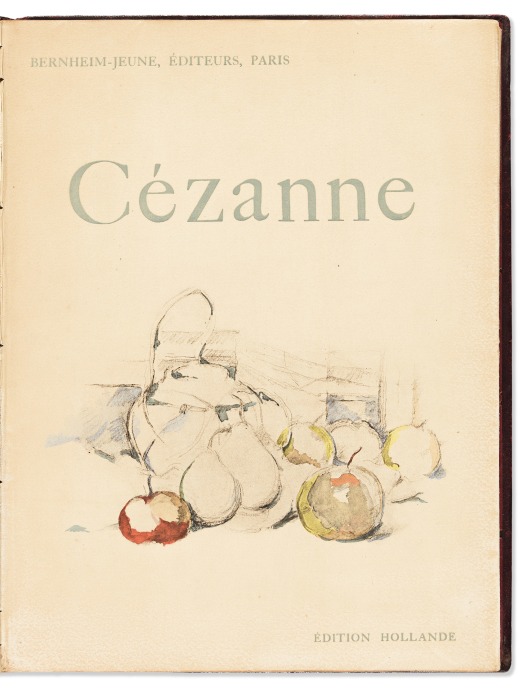

265
Cezanne, paul.
Cèzanne.

Paris: Bernheim-Jeune, 1914
Frontispiece etching by Cezanne, 6 lithographs by Vuillard, Bonnard, Denis, Matisse, Roussel, and Maillol. Small folio (380 x 285 mm), 20th-century brown leather, neatly rebacked, front cover set with green leather onlay depicting a still-life by Cezanne; original wrappers bound in. Limited edition, number 130 of 100 copies on verge d’Arches of a total edition of 600.



266
Chagall, marc.
Derriere le Miroir. Nos 66-67-68.

Paris: Maeght Editeur, 1954
Comprising 11 original lithographs by Marc Chagall, including the front and back covers, 9 of which are printed in colors and one folding, with 12 pp. text. Printed by Mourlot. Folio (15 x 11 inches; 380 x 280 mm), publisher’s lithographed self-wrappers, separated along spine fold with some abrading, front wrap with some age-toning and spotting, top outer corner torn but present; contents loose as issued, light, occasional smudging, mild edge-toning. Special triple number. Features Chagall’s Paris-themed works exhibited at Maeght in 1954. Cramer 24; Maeght 65; Mourlot 93-103.



267
(chagall, marc.) lassaigne, jacques.
Chagall.

(Paris): Maeght Editeur, (1957)
With 15 original lithographs, all but one in color, printed by Mourlot (four folding; total includes cover and frontispiece), additional color and monochrome reproductions. 4to, original stiff card wrappers with lithographed outer wrapper, spine head lightly bumped; ex-collection Edwin Bachmann with his inscribed bookplate taped to front flyleaf; publisher’s acetate dust jacket. First edition, second issue with the uncolored bouquet in the frontispiece.



268
Columbian exposition / bancroft, hubert howe.
Achievements of Civilization. The Book of Wealth.

New York: The Bancroft Company, 1896-1908
Wealth in Relation to Material and Intellectual Progress and Achievement.</i> 7 (of 10) volumes (lacking sections 4, 7 & 8) plus 1 duplicate volume. Photographic illustrations and reproductions. Large folio, 550 x 425 mm; 17 x 22 inches, elaborately watercolored covers by various artists including W. How, R. Wiley, H. M. Armstrong, H. Sandham and others, over gold silk boards, scattered moderate wear to silk with several splits along joints with fraying, corners bumped, covers generally bright; some hinges cracked or starting; all edges trimmed and gilt, patterned silk doublures, a few clean marginal tears or creases. Comprises: Sections 1-3; 5-6; and 9-10. With a duplicate copy of Section 3; this copy bound in ¾ leather gilt over cloth (scattered soiling, spine foot chipped, abrading) with front cover designated “Author’s Edition” with identical contents to companion volume. Number 94 of 150 numbered sets of the edition cygne noir signed by Bancroft for subscriber Mrs. John Dunfee. (8)

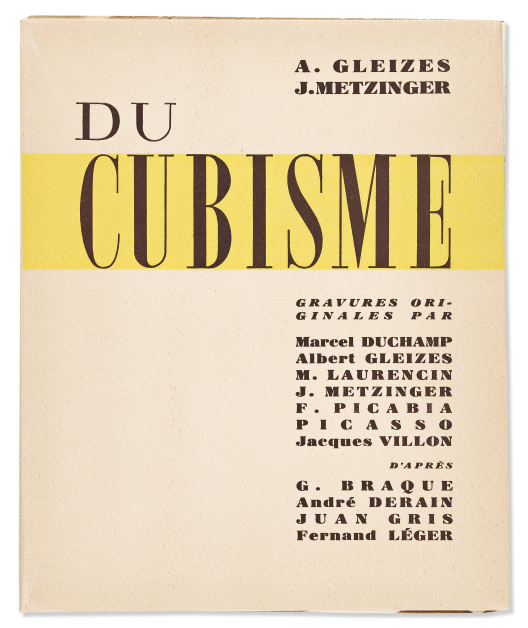

269
[cubism.] gleizes, albert and metzinger, jean.
Du Cubisme.

Paris: Compagnie Française des Arts Graphiques, 1947
Portfolio with complete text and 11 etchings, engravings and aquatints, (255x200 mm; 10x8 inches), full margins. 4to, publisher’s printed wrappers, inked presentation inscription on first blank, contents laid in loose as issued; housed in original stiff-card chemise with printed paper spine label (joints repaired) and board slipcase (tanned, edges rubbed). Number 229 of 435 numbered copies. Includes prints by Marcel Duchamp, Pablo Picasso, Albert Gleizes, Marie Laurencin, Jean Metzinger, Francis Picabia, Jacques Villon and (after) Georges Braque, André Derain, Juan Gris and Fernand Léger.



270
Dali, salvador. gérard, max.
Dali.

New York: Abrams, (1968)
Translated by Eleanor R. Morse. Illustrated throughout. 4to, publisher’s pictorial cloth, light rubbing to spine tips and joints; dust jacket, few superficial scratches and soft creasing; contents clean. First edition, signed and inscribed by Dali in blue pen.



271
Daumier, honoré.
Album des Charges du Jour.

Paris: Chiavari and Martinet, [1859]
Lithographed title-page and 30 captioned lithographs. Oblong 4to, 10½x13¼ inches, original yellow pictorial wraps, chip to foot of backstrip, few short closed tears with tape mends to verso of front wrap, scattered light soiling, penciled notes at top of front wrap and catalogue clipping mounted to verso; contents variously quite clean to darkened and heavily foxed.



272
(de beaumont, edouard.)
Le Barbe Bleue & La Belle Au Bois Dormant * Cinderella and the Two Gifts.

Paris, 1878; 1886
By Charles Perrault. Together, 2 volumes. Folio, each bound in contemporary full red pebbled morocco gilt extra, first volume with cosmetic touch-ups to slightly darkened spine; top edges and turn ins gilt, silk endpapers. Each illustrated on rectos only by de Beaumont with hand-colored lithographs (Cinderella with 33 aquarelles; housed in slipcase). Fine. (2)



273
(detmold, edward j.) aesop.
The Fables of Aesop.

London: Hodder & Stoughton, 1909
25 tipped-in color plates by Edward Detmold captioned on previous page. Large 4to, publisher’s gilt-pictorial cream cloth, spine slightly sunned, scattered spotting to rear board; top edges trimmed and gilt, endpapers toned as usual. Number 93 of 750 copies signed by Detmold.



274
Dine, jim.
Glyptotek.

New York/London: Jim Dine/Pace Editions/Waddington Graphics, 1988
Complete with 40 intaglio plates (etching and aquatint on chine collé). Folio (37 x 21 inches), bound in publisher’s black cloth stamped in silver, few scuffs and blemishes; matching slipcase with similar wear; plates clean. Number 30 of 90 copies, signed by Dine on the limitation.



275
Dufy, raoul. fleuret, fernand.
Eloge de Raoul Dufy.

[Paris:] Les Amis Du Docteur Lucien-Graux, [1931]
Illustrated with etched portrait and 4 color lithographs by Dufy. 4to, publisher’s pink printed wrappers, minor chipping to bottom of spine; glassine overwrap; laid into supplied ¾ morocco folder, spine gilt lettered. Number 49 of 150 copies, this example with extra color litho (“Mozart”), and extra etched portrait printed on Japanese, signed “Raoul Dufy” and “11/31” in pencil laid in loose.



276
Ernst, max. waldberg, patrick.
Aux Petits Agneaux.

Paris: Au Pont des Arts, Galerie Lucie Weill, 1971
Illustrated with 19 original color lithographs by Max Ernst, printed on velin d’Arches. 4to (325 x 250 mm), contents loose as issued in publisher’s lithographed and printed wrappers, fine; exhibition invitation laid in; housed in cloth clamshell box (two corners split). Limited edition, number 50 of 100 copies, signed by both author and artist on the colophon, and without the suite (there were also 21 hors-commerce copies with the suite).



277
Gill, eric / golden cockerel press.
The Four Gospels of the Lord Jesus Christ according to the authorized version of King James I.

(Waltham St. Lawrence), 1931
18-point Golden Cockerel Face type. 65 wood-engraved illustrations by Eric Gill, including 4 full-page plates. Folio, publisher’s gilt-lettered ½ white pigskin over tan buckram, bound by Sangorski & Sutcliffe, raised bands, gilt lettering to spine, top edges gilt, others untrimmed, some discoloration at top of front board just touching pigskin; contents clean. Number 445 of 500 copies of one of the most important fine press books produced in the 20th century. This edition of the Four Gospels set in the text of the King James Gospels. Gill integrated the text and illustrations into a modern homage to the tradition of illuminated manuscript. “Conceived in the fruitful mind of Robert Gibbings, this is the Golden Cockerel book usually compared with the Doves Bible and the Kelmscott Chaucer. A flower among the best products of English romantic genius, it is also surely, thanks to its illustrator, Eric Gill, the book among all books in which Roman type has been best mated with any kind of illustration”– Chanticleer 78; From Manet to Hockney 89; E.R. Gill, Eric Gill, 285.



278
Gill, eric.
Group of 3 wood engravings [from] The Four Gospels of the Lord Jesus Christ

[Np, but Waltham St. Lawrence], 1931
according to the authorized version of King James I.</i> Each 12¾ x 9 inches, mount apertures. Printed in 18-point Golden Cockerel Face type. Comprises two divisional title pages: The Gospel According to Saint Matthew, and The Gospel According to Saint Luke, and in-text illustration from p. 66 of the Golden Cockerel book (some red ink spots to blank borders, and a few tiny pinholes along top margins). The title sheets are both dated 1931 and initialed by Gill, while the third sheet bears an unsigned inscription by the artist: “viz. [Robert] Gibbing’s original concept - and so all congratulations to the (almost) infallible Cooper!!”; accomplished in pencil. Additionally St. Luke is numbered “6th/10” and St. Matthew “5/XI.” Together in wooden frame and exhibition mount. Unexamined out of frame.



279
Glaister, donald.
3 in Search of the Universe: Rumi, Walt Whitman and the Voyager spacecrafts wonder at The Quest.

Vashon Island, Washington: Foolsgold Studio, 2016
Poems by Walt Whitman and Rumi translated by Zahra Partovi. [10] leaves; pages of laminated aluminum and boards, including some cut away in geometrical patterns to reveal the metal underneath. 14¼ x 12½ inches, original black morocco spine with sanded aluminum insets on front and back covers; typography and letterpress printing on aluminum and polyester sheets from photopolymer plates by Jessica Spring at Springtide Press in Tacoma, WA; housed in publisher’s cloth folding box with printed paper spine label. Number 1 of 10 copies, inscribed “for Deke” by Donald Glaister, from a total edition of 15; two of which are deluxe copies lettered A and B; three of which are hors de commerce copies designated AP1, AP2 and AP3.

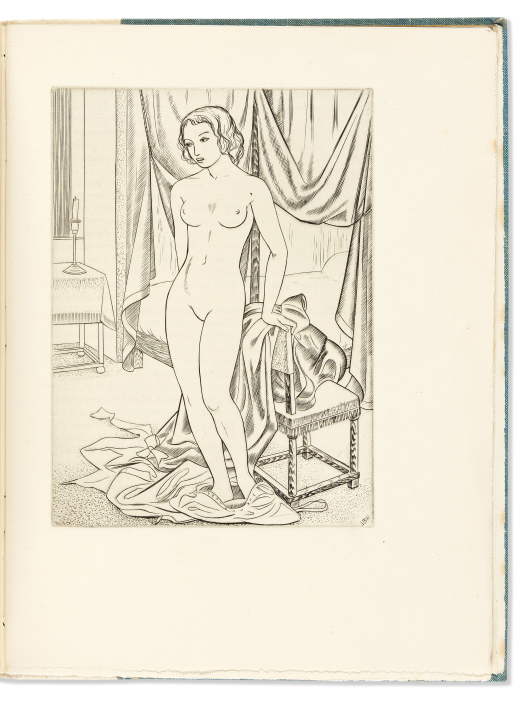

280
(golden cockerel press.)
Group of 3 limited editions.

(Waltham St. Lawrence, 1928; 1932; 1938)
Comprising: A Sentimental Journey Through France and Italy. Sterne, Lawrence. Illustrated by J.E. Laboreur. 8vo, full red buckram, spine gilt. Number 13 of 500 copies. [With:] The Amores of P. Ovidius Naso. Illustrated by J.E. Laboureur. Translated by E. Powys Mathers. 8vo, ½ brown calf, scattered soiling to cloth, spine titles gilt. Number 148 of 350 copies. [And:] Mademoiselle de Maupin. Illustrated by John Buckland Wright with 8 plates. 4to, ¼ pigskin, spine titles gilt. Number 410 of 450 copies. (3)



281
Guido, alfredo (illustrator) and sarmiento, domingo f.
Facundo.

Buenos Aires: Sociedad de Bibliófilos Argentinos, 1933
Edited by Eduardo Bullrich and Carlos M. Mayer; printed by Francisco A. Colombo. 4to, publisher’s printed wrappers, some mild creasing; sheets laid in loose, as issued, contents clean; supplied card slipcase. Number 7 out of 100 copies on Japan Imperial paper, printed for Maurice Bock. Comprising 37 etchings, 1 rejected etching, and 3 original drawings by Guido signed; in enclosed printed paper folder. The first book published by the Sociedad de Bibliofilos Argentinos, and a remarkable publication lavishly illustrated by artist Alfredo Guido. Considered the most beautiful private-press book published in Argentina in the Golden Age of Bibliophilia.



282
Indiana, robert.
Numbers.

Stuttgart: Edition Domberger/Düsseldorf: Galerie Schmela, 1968
Poems by Robert Creeley. Title, text and limitation pages (2 separate folded sheets, one signed by Indiana out-of-series, and one unsigned with “XXXVIII” indication), original paper folder for each of the prints (25½ x 19¾ inches; 645 x 500 mm, sheets), mylar sheet for each, and each with a poem by Creeley in English and German, on Schoeller Parole white wove paper, printed by Domberger KG, laid in loose, as issued; original oatmeal cloth portfolio (few faint spots). The complete set of 10 color screenprints, each signed, dated and numbered XXVIII/XXXV in pencil, also numbered on the limitation. One of 35 artist’s proofs from a total edition of 160. Beautifully preserved example. Sheehan 46-55.



283
(jones, david.) coleridge, samuel taylor.
The Rime of the Ancient Mariner.

Bristol: Douglas Cleverdon for the Fanfare Press, 1929
10 copper-engraved plates by Jones. 4to, original ¼ gilt-lettered cream cloth over green boards, spine lightly toned, faint mottling to portions of board edges; offsetting to endpapers. Number 384 of 470 total copies.



284
(kent, rockwell.) melville, herman.
Moby Dick, or, The Whale.

Chicago: The Lakeside Press, 1930
3 volumes. Illustrated profusely by Kent. Large 4to, publisher’s silver-stamped black cloth over beveled boards, lightly scuffed; usual offsetting from illustrations to facing pages; original aluminum slipcase, scratched with a few stains. Limited edition, one of 1000 unnumbered sets. The Artist and the Book 140.



285
Laurens, henri. saroyan, william.
Contes.

Paris: Les 100 Bibliophiles de France et d’Amerique, 1953
French text translated by Anne Green. Wrapper cover, frontispiece and 9 color woodcuts by Laurens, additional in-text illustrations. 4to, publisher’s pictorial wrappers; occasional light to moderate spotting to text leaves, contents loose in original matching chemise and slipcase. With one woodcut numbered I/XXV and signed by Laurens and the publisher. Additionally signed by both on the limitation, this copy designated “Exemplaire No. XLVI” of XLVII copies from a total edition of 147.



286
Lepere, auguste. lotz-brissoneau, a.
L’Oeuvre Grave de Auguste Lepere *Auguste Lepere: Peintre et Graveur Décorateur de Livres.

Paris, 1905; 1931
Together, 2 volumes. Illustrated by Lepere. 4to, first title bound in ¾ brown morocco by Maylander with original wrappers bound in, spine titles gilt; second title in original printed wrappers (unevenly toned); partly unopened. First title: Number 4 of 125 copies with the artist’s stamped monogram on the limitation, signed and numbered frontispiece, and additional tipped in manuscript letters and partly printed cards by the author and Edmond Sagot at front. Second title: Number 115 of 150 copies from a total edition of 650. (2)



287
(limited editions club.) o’hara, frank.
Poems.

New York, 1988
Lithographs by Willem De Kooning on Kitakata paper. Large folio, publisher’s gilt-lettered black morocco; original cloth clamshell box; prospectus laid in. Number 29 of 550 copies with DeKooning’s authorized facsimile signature. Fine.



288
(lissitzky, el.)
USSR. An Album Illustrating the State Organization and National Economy of the USSR.

(Moscow), Scientific Publishing Institute of Pictorial Statistics, [1939]
Text in English. Photographic illustrations and pictorial charts and diagrams, many in color, depicting aspects of Russian industry such as the Voroshilov Sanatorium in Sochi, many by Lissitzky who was also the primary designer of the book, with Alexander S. Grigorovich and Mikhail V. Nikolaev; several pages with die-cuts inserted. Oblong folio, original red cloth-covered flexible wrappers with hammer and sickle device in upper left corner of front cover, joints split, minor finger soiling; publisher’s folded printed pamphlet laid in titled “Basic Indices of the Economic and Culrural Growth of the U.S.S.R. According to the Third Five-Year Plan. 1938-1942.” First edition. The work is typical of the typographical work Lissitzky did for the government after his return to Russia from Germany in 1928 where he was highly influential in the Bauhaus movement. Not in Lissitsky-Kuppers.



289
Lobel-riche, almery. coquiot, gustave.
Poupees de Paris Bibelots de Luxe.

Paris: Librairie de la Collection des Dix, 1912
40 etchings (38 full page with titles lower margins); additional suite of 40 etchings hors-texte on Japon blanc a la forme. 4to (310 x 235 mm), original printed wrappers (small split to front lower joint); original glassine; board slipcase and chemise. Limited edition, number 106 of 110 copies on Japon Imperial and Velin d’Arches with the plates in two states of a total edition of 300.



290
Louys, pierre. calbet, antoine.
Aphrodite. Moeurs antiques.

Paris: Librairie Borel, 1896
Illustrated with vignette title, frontispiece, and numerous others by Calbet. Small 8vo, contemporary ½ morocco over marbled boards, spine ruled and lettered in gilt, slight lean; intermittent to moderate foxing. First illustrated edition, one of 73 on Japon; from a total edition of 98 copies.



291
Léger, fernand. frénaud, andré.
Source Entière.

(Paris:) Seghers, (1952)
The complete set of 5 lithographs including the title page (4 in colors; sheets 275 x 220 mm), text in French and table of contents, on Annam. 4to, publisher’s red wrappers printed in black, light creasing to top outer corners, unstitched copy with stab holes present; original red and black paper-covered board portfolio with red-stamped title on the spine, splitting along rear joint with abrasions to front board; publisher’s matching slipcase (extremities rubbed with exposure, finger soiling). Number 17 of 25 copies, signed in ink by the artist and author on the colophon (there were also 3 copies lettered A-C).



292
Léger, fernand. rimbaud, arthur.
Les Illuminations.

Lausanne: Grosclaude Éditions des Gaules, [1949]
15 lithographic plates, 12 with pochoir coloring. Folio (330 x 250 mm), bound in yellow morocco gilt with variously colored horizontal onlay pattern by Michel Kieffer with their ticket, spine tanned, top edges gilt, original wrappers bound in, publisher’s prospectus laid in; morocco-edged slipcase matching endpapers design. Number 57 of 75 copies, signed by the artist and the publisher, with the additional suite of lithographs on China, from a total edition of 395.



293
Masson, andré. senghor, léopold sédar.
Chants d’Ombre.

Geneva: Éditions Regard, 1976
The complete set of ten aquatints in colors each signed in pencil by Masson, text in French by Senghor, list of plates, on Arches paper. Folio (17 x 13 inches; 430 x 330 mm, sheets), publisher’s printed wrappers, contents laid in loose as issued; original blue cloth-covered clamshell folding case with a sand imprint of the artist’s design with his initials in pencil under Plexiglas cover (numbered 140 inside front lid in pencil); prospectus laid-in. Number 140 of 125 copies on Arches, signed by the author and artist on the colophon. From a total edition of 190.



294
Millet, jean-francois. sensier, alfred.
La Vie & L’oeuvre de J.-F. Millet.

Paris: A. Quantin, 1881
4to, contemporary full olive morocco gilt by Chatelin, spine tooled in gilt in compartments, top edges gilt, spine foot and corners rubbed with light exposure; inner dentelles, armorial bookplate, contents quite clean. Extra-illustrated with 1 original lithograph by Millet (“Le Semeur”), and 4 etchings and 14 woodcuts by or after the artist. The additional plates bound in include:(i) Millet (J. F.) Le Semeur, [1851]. Lithograph [Delteil 22; Melot 22], 191 x 156 mm (spotting) [pp. 124/125] * (ii) Millet (J. F. & J. B.) La grande bergère assise, [c. 1863]. Woodcut [Delteil 33/2; Melot 33], 270 x 220 mm (left margin cut by binder) [pp. 384/385] * (iii) Millet (J. F. & J. B.) Femme vidant un seau, [c. 1870]. Woodcut [Delteil 32; Melot 32], 143 x 95 mm [pp. 384/385] * (iv) Millet (J. B.) [Barbizon]. Etching, 229 x 142 mm [pp. 116/117] * (v) Gaujean. Le Greffeur. Etching after Millet, 148 x 207 mm [pp. 158/159] * (vi) Waltner (Ch.) L’ Angelus. Etching after Millet, 200 x 243 mm [pp. 190/191] * (vii) La Mort et le Bûcheron. Etching after Millet, 135 x 179 mm [pp. 192/193] * (viii-xi) Lavieille (A.) Les Quatre heures du jour. 4 woodcuts after Millet on India paper mounted, 148 x 219 mm each [pp. 386/387] * (xii-xvii) Lavieille (A.) Les Travaux des champs. 6 woodcuts after Millet on India paper mounted on 3 leaves, 140 x 76 mm each [pp. 390/391].



295
[miniature book.] galilei, galileo.
Galileo a Madama Cristina di Lorena.

Padua: Tipogr. Salmin, 1896 (i.e. May 1897)
Wood-engraved portrait frontispiece of Galileo. Printed in exceedingly small “fly’s eye” type. 16 x 10mm, blue cloth decorated in gilt, “Galileo” in gilt on spine, all edges gilt, spine detached from textblock. First Miniature Edition. “For many years this tiny book which is only half the size of an ordinary postage stamp was considered the smallest printed from movable type” (Bondy, pp. 95-96).



296
Mucha, alphonse. france, anatole.
Clio.

Paris: Calmann Lévy, 1900
Lithographed color plates and text illustrations by Mucha. 8vo, contemporary ½ brown morocco, spine tooled in gilt in compartments, top edges gilt. Limited edition, one of 100 copies on Japon, from a total edition of 150.



297
(print portfolio.) erb, christopher.
Dead Birds.

Np: Vital Signs, 1988
24 broadsides containing a hand-printed and signed print by various artists including Will Barnet, Robert Blackburn, Joe Lee, George Nama, and others, accompanying a poem by Erb. Verona typeface hand set and printed by Elena Laza. Folio, 381x533 mm; 15x21 inches, sheets, full margins. Folio, contents loose as issued in silver-stamped textured board clamshell box. Number 11 of 36 copies signed by Erb and each of the artists.



298
Rackham, arthur.
The Allies’ Fairy Book.

London/Philadelphia: William Heinemann/J.B. Lippincott Co., [1916]
12 color, tipped-in plates, printed tissue guards, numerous other in-text black and white illustrations. Small 4to, publisher’s blue buckram gilt, spine darkened, moderate scuffing to covers, light wear to spine tips and corners; endleaves browned. Limited edition, number 333 of 525 copies signed by Rackham.



299
(rampant lions press.) eliot, t.s.
Four Quartets.

Cambridge, 1996
Designed and printed by Sebastian Carter. Folio, publisher’s ¼ brown cloth and patterned paper-covered boards, spine label; original stiff card slipcase. Number 116 of 200 copies. Fine.

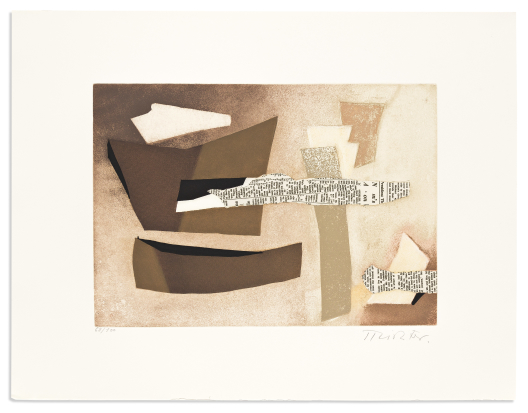

300
Richter, hans. arp, hans (poems).
Six cuivres graves a l’eau-forte.

Paris: Editions Georges Visat, 1974
Complete with 12 original prints signed and numbered by Richter. Folio (23 x 17¾ inches; 590 x 450 mm, sheets), publisher’s plain white wrappers; contents laid in loose, as issued; original cloth folding case with printed paper spine label (dampstaining to front cover). Number 68 of 100 copies, comprising two suites of six each on Arches and Japon Nacré, all 12 signed and numbered by Richter. Fine.



301
Richter, hans. rosey, gui.
Faits divers faits éternels.

Paris: Éditions Georges Visat, 1972
7 color etchings on Arches each numbered 56/99 and signed by Richter in pencil. 4to, publisher’s blindstamped wrappers, unsewn as issued; in original cloth chemise and matching slipcase. Number 56 of 99 copies.



302
Ruscha, edward.
Group of 4 First editions.

Hollywood/Los Angeles, vd
Comprising: Crackers.</i> Illustrated with reproductions of Ruscha’s photographs illustrating a story by Mason Williams entitled “How to Derive the Maximum Enjoyment from Crackers.” 8vo, perfect bound plain brown wrappers; printed dust jacket, light dust soiling; remnant of Pasadena Art Museum sticker on front flyleaf. One of 5000 unnumbered copies. 1969 * Real Estate Opportunities.</i> 8vo, printed wrappers; original glassine dust jacket; Wittenborn and Company ticket inside rear cover. One of 4000 copies. 1970 * Records.</i> Photos by Jerry McMillan. 8vo, printed wrappers, pale stain to front wrap; remnant of Pasadena Art Museum sticker on front flyleaf. One of 2000 copies. 1971 * Colored People.</i> 8vo, printed wrappers; remnant of Pasadena Art Museum sticker on title-page. One of 4065 copies. 1972. [With:] Edward Ruscha. Books and Prints. Stapled pamphlet published in conjunction with an exhibit of his works at UC-Santa Cruz, Jan-Feb 1972. (5)



303
Ruscha, edward.
Royal Road Test.

Los Angeles: Self-published, 1967
A collaboration between Edward Ruscha, Mason Williams, and Patrick Blackwell. Illustrated with reproductions of photographs documenting the destruction of a Royal “Model X” Typewriter. 8vo, original spiral bound printed wrappers, few light smudges on rear wrapper; faint spotting to top of blank prelim. First edition, one of 1000 unnumbered copies. Hasselblad 198.



304
Ruscha, edward.
Some Los Angeles Apartments.

Los Angeles: self-published, 1965
Illustrated with reproductions of Ruscha’s photographs. 8vo, original white wrappers printed in green; glassine dust jacket, spine panel tanned; Wittenborn and Company ticket to rear blank. First edition. One of 700 unnumbered copies.



305
Ruscha, edward.
Thirtyfour Parking Lots in Los Angeles.

Aerial photographs by Art Alanis. 4to, original printed wrappers; glassine dust jacket, light wear to top edges; Wittenborn and Company ticket at rear. First edition, one of 2413 unnumbered copies. Parr & Badger II, p. 141



306
Ruscha, edward.
Twentysix Gasoline Stations.

(Alhambra, California): Self-published (Printed by The Cunningham Press), 1967
Illustrated with reproductions of Ruscha’s photographs of West Coast and Southwest gas stations. 8vo, publisher’s wrappers printed in red; original glassine dust jacket with spine panel lightly tanned; Wittenborn and Company ticket at rear. Second edition, one of 500 unnumbered copies.



307
(satz, matthew.) mcwhinnie, john.
How to Shoot at One Who Outdrew You.

East Hampton: Horowitz, 2005
Volume of color photographic plates showing artworks by Satz, with an introductory essay by McWhinnie; accompanied by three original paintings, 182x131 mm each, signed and dated by Satz on verso, and an original oil-based enamel on waxed linen thread, 229 mm long. Oblong 4to, original dove grey cloth lettered in blue; laid into matching cloth clamshell case with insets to house paintings and thread; inscribed by Satz to collector on title-page. One of only 35 deluxe limited editions with the signed artworks; from a total edition of 785.



308
Shapiro, joel. cole, peter.
Rift.

New York: Grenfell Press, 1986
Poem by Cole. Illustrated with woodcut frontispiece by Shapiro. 8vo, publisher’s full limp vellum, gilt-lettered spine; housed in original full cloth folding case. Deluxe issue, number X of XV copies signed by the author and artist. With separately issued two color woodcut, signed, dated [19]87 and numbered 10/25 by the artist, from a total edition of 135. Fine.



309
Strang, william.
Catalogue of His Etched Work * Supplement to the Catalogue.

Glasgow: James Maclehouse, 1912; 1923
Together, 2 volumes. Etched frontispieces, signed by Strang in pencil below the image of Volume 1; profusion of plates with catalogue entries. 8vo, publisher’s cloth, top edges gilt, lightly rubbed; new spine labels tipped to rear pastedowns; scattered light foxing/browning. One of 130 and 300 numbered copies, respectively. (2)



310
Sutherland, graham. apollinaire, guillame.
A Bestiary and Some Correspondences.

London/Milan: Marlborough/2RC Editrice, 1978-79
Complete set of 15 color aquatints (35 x 26½ inches, overall), on Magnani paper, with publisher’s blindstamp, complete text (title-page with closed tears and one tape mend), from the Standard Edition, the justification page numbered 30/75 in pencil; loose in original cloth tray-case. Each aquatint signed and numbered 30/75 in pencil by Sutherland



311
Swift, jonathan. cresset press.
Gullivers’ Travels.

London: The Cresset Press, 1930
2 volumes. Colored frontispieces and 10 plates, 5 maps, vignettes, and head- and tailpieces by Rex Whistler. Folio, bound by Monique Lallier in full light green morocco with dark green morocco inlays lettered in gilt on front and rear covers depicting the Remote Nations of Lilliput, Brobdingnag, Balnibardi [sic], and Houyhnhnms, the front covers with folding panels that open to pop-ups constructed of variously colored and cut paper, top edges gilt; publisher’s prospectus laid in; each in cloth folding case. Number 170 of 195 copies. A superb copy in an evocative and elaborate binding by Lallier.



312
Tanning, dorothea. crevel, rené.
Accueil.

Paris: Jean Hugues, [1958]
Original etchings in color by Tanning. 8vo, publisher’s printed wrappers decorated with an original etching by Tanning on front wrap with laminate overwrap, contents laid in loose as issued; housed in original silk-covered chemise, leather lettering, matching slipcase. Number 48 of 50 copies initialed by the publisher and signed by the artist on the colophon (also 10 hors commerce copies).



313
(typography.) oliver, simon and morison, stanley (eds.).
The Fleuron: A Journal of Typography.

London, 1923-1930
7 volumes, complete. Hundreds of tipped-in, mounted, and folding plates and illustrations, plus additional inserts and plates in the text; adverts at end of each volume. 4to, various cloth bindings: Volumes 1-4 full black cloth, top edges gilt, boards lightly scuffed, vol. 3 with repairs to front joint, few bumped corners; vol. 5 in tan decorated buckram, spine darkened with minor frays; vol. 6 in green cloth gilt, bright and clean; vol. 7 in gilt-lettered navy cloth, spine and portion of covers faded, rear board scuffed; ex-collection Harold Hugo, director of Meriden Gravure, with his bookplate in several volumes. Deluxe editions on handmade paper. Limitation ranges from 110 to 210 copies, with final volume signed by Morison. Simon was the editor of the first four (produced by Curwen Press), with Morison the editor of the last three (produced by Cambridge Univ. Press). Complete sets of this handmade paper edition quite scarce.



314
Vlaminck, maurice de.
Et Noir et en Couleur.

(Paris): Aux depens d’un amateur, (1962)
Folio (380 x 280 mm). 104 pp. Illustrations and text by Maurice de Vlaminck throughout with original lithographs and woodcuts, comprising: a front cover lithograph in bistre, a duotone lithographed self-portrait frontispiece, 5 color lithographs (4 of which are double-page and all but one of which is hors-texte), 10 large lithographs within text (in black or black and gray), and 19 woodcuts within text. All loose as issued in the original lithographed wrappers. With 3 extra suites of loose lithographs: 1) 10 hors-texte lithographs; 2) 5 hors-texte color lithographs (not called for in the colophon); and 3) 8 color proofs. Each suite in a plain folder. Housed together in original suede-lined board chemise and linen clamshell box (light wear). One of 75 deluxe examples on Grand Velin D’Arches and with extra suites, from a total edition of 298, this copy unnumbered. Monod 11350.




























